inbox and environment news: Issue 571
February 12 - 18 2023: Issue 571
Stop PEP11 & Protect Our Coast Bill 2023 To Be Tabled In Federal Parliament This Week By Warringah MP - Will Be Seconded By Mackellar MP
Mackellar MP Dr. Sophie Scamps has stated she will be seconding Warringah MP Zali Steggall's Stop PEP11 and Protect Our Coast Bill 2023 on Monday February 13th when Parliament returns.
''The Northern Beaches is united on this - we will never accept drilling for oil and gas off our beaches!'' Dr. Scamps has stated
''Zali's Bill will rule out any consideration of an application to drill for oil and gas off our coast and protect our oceans and our coastline for good.
It's time for the Albanese Government to do what the Morrison Government couldn't, and that's kill off PEP-11 for good and start investing in the future - clean, cheap and reliable renewables backed by storage technology.''
More in: Agreement To End PEP-11 Litigation Revives Applicants' Licence Extension Process - Issue 570
Plastic Boardwalk Through Manly Warringah War Memorial Park: 'We Can Do Better!' States Save Manly Dam Bushland Group
WE CAN DO BETTER !!
Boardwalk Empire from Malcolm Fisher on Vimeo.
Pittwater: Urban Wallabies
Report Fox Sightings
%20(1).jpg?timestamp=1675893929686)
Avalon Dunes Bushcare Returns Sunday March 5th
Next will be on March 5, meeting at 8.30 in the parking area off Tasman Rd south.
We work until 11.30 but any time you can spare is wonderful.
We always find interesting insects and other wildlife. We can see the progress happening as we work in this corner of the 4.5ha dunes.
Call in to say hello or phone 0420 817 574 if you can't see us there.
New helpers very welcome, and there's always something yummy for morning tea.
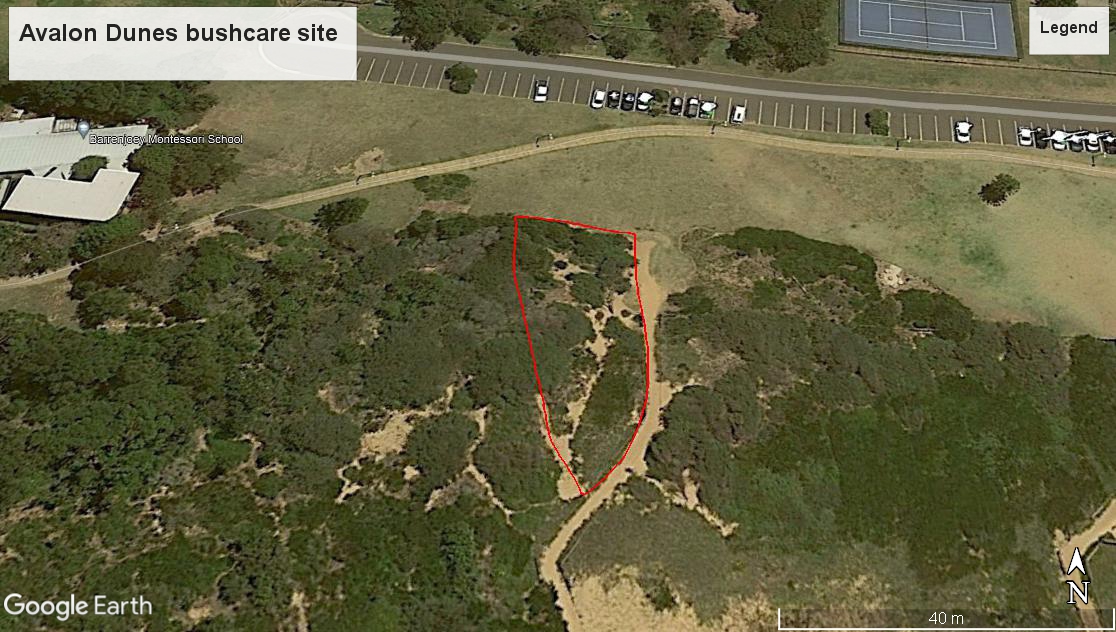
Our bushcare area is within the red lines. We can work in the shade in summer, or in sun in winter. Barrenjoey High school is to the north.
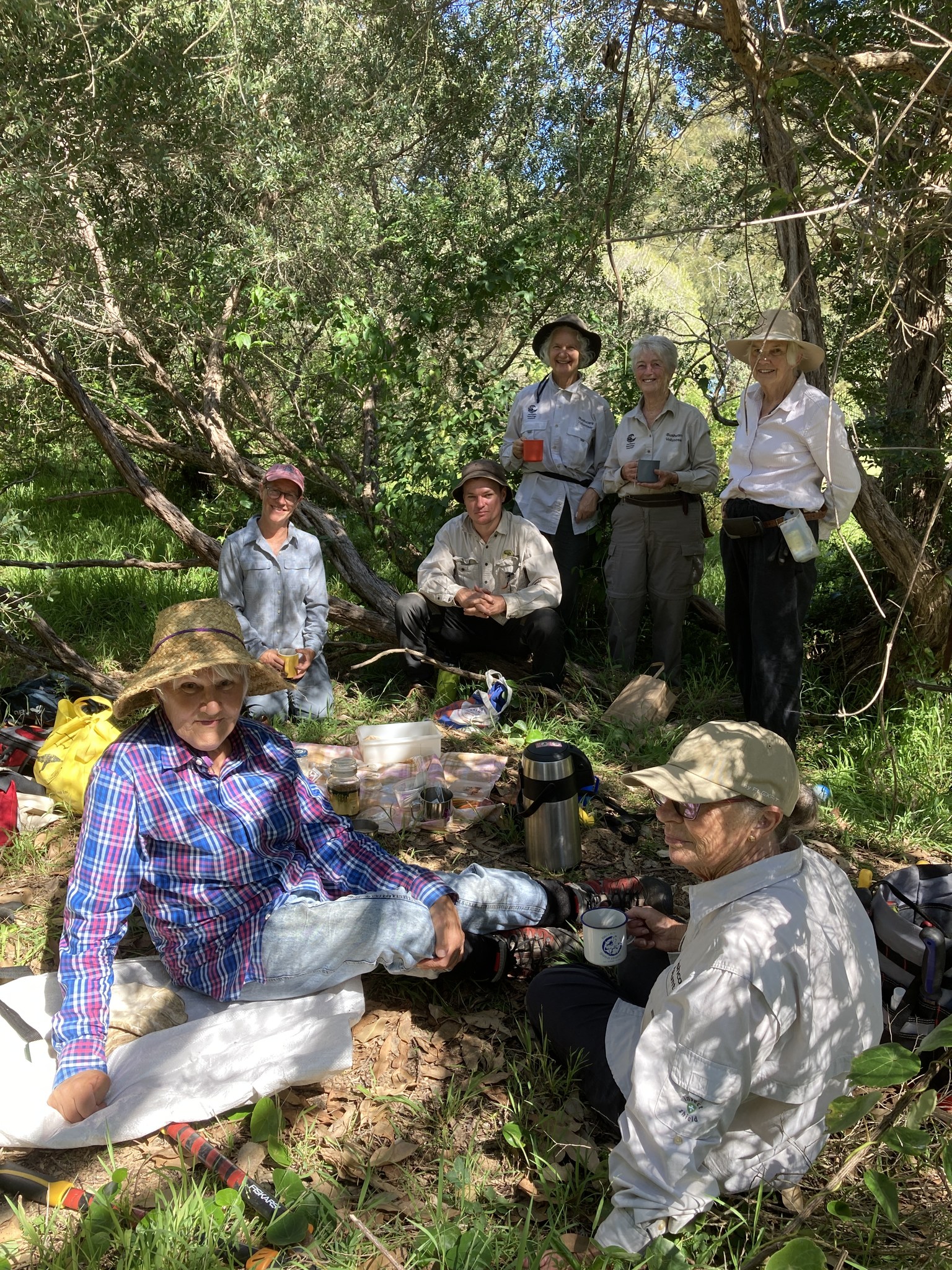
Morning tea with good company and cake.
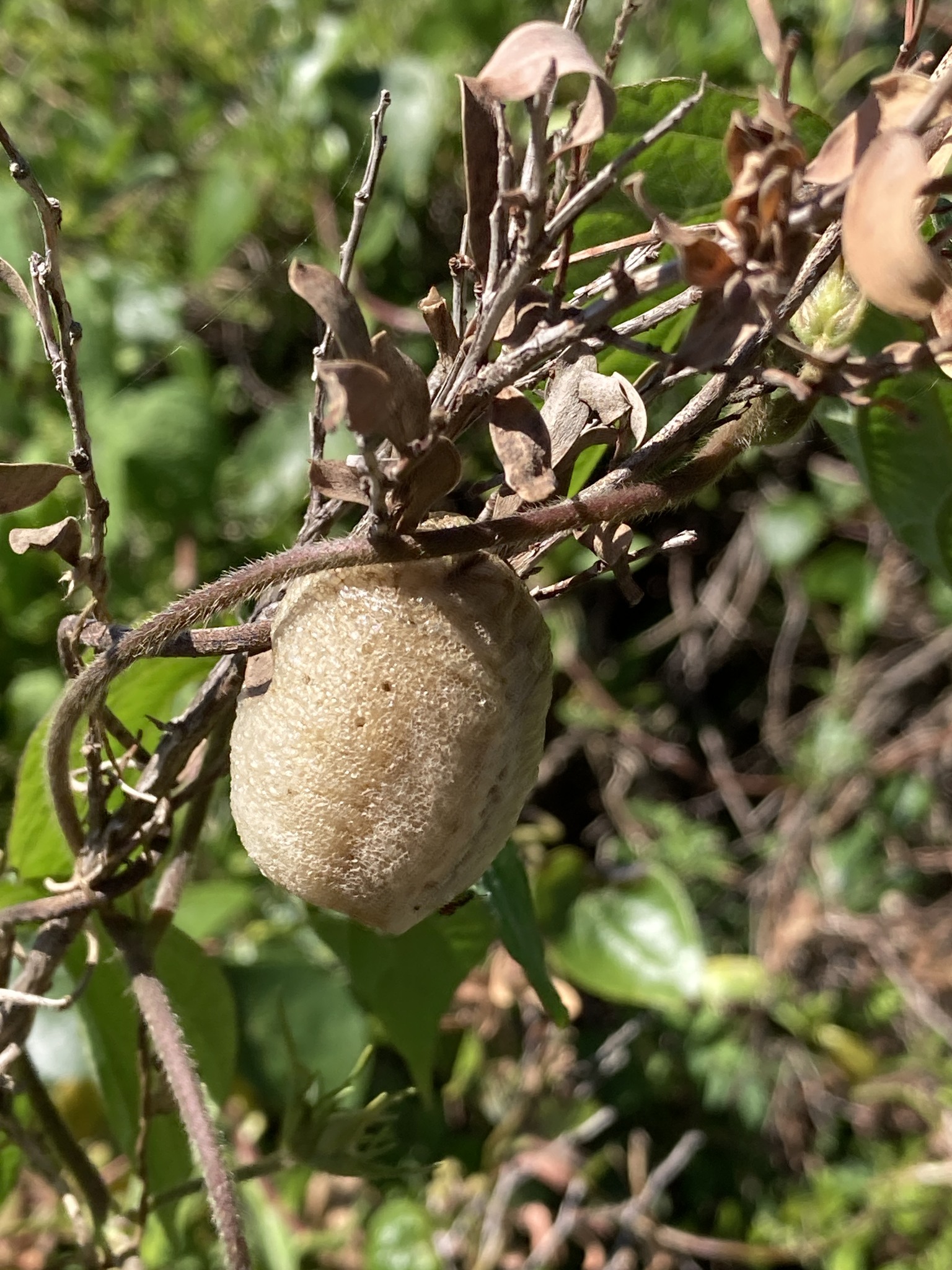
The egg case or ootheca of a Praying Mantis. Each ootheca contains a number of eggs, up to 200 with some species. Mantis eggs can take anywhere from 40 days to around five months to hatch. On hatching, the baby mantises are about as big as a large ant. The tiny holes on this one suggest the eggs have hatched.
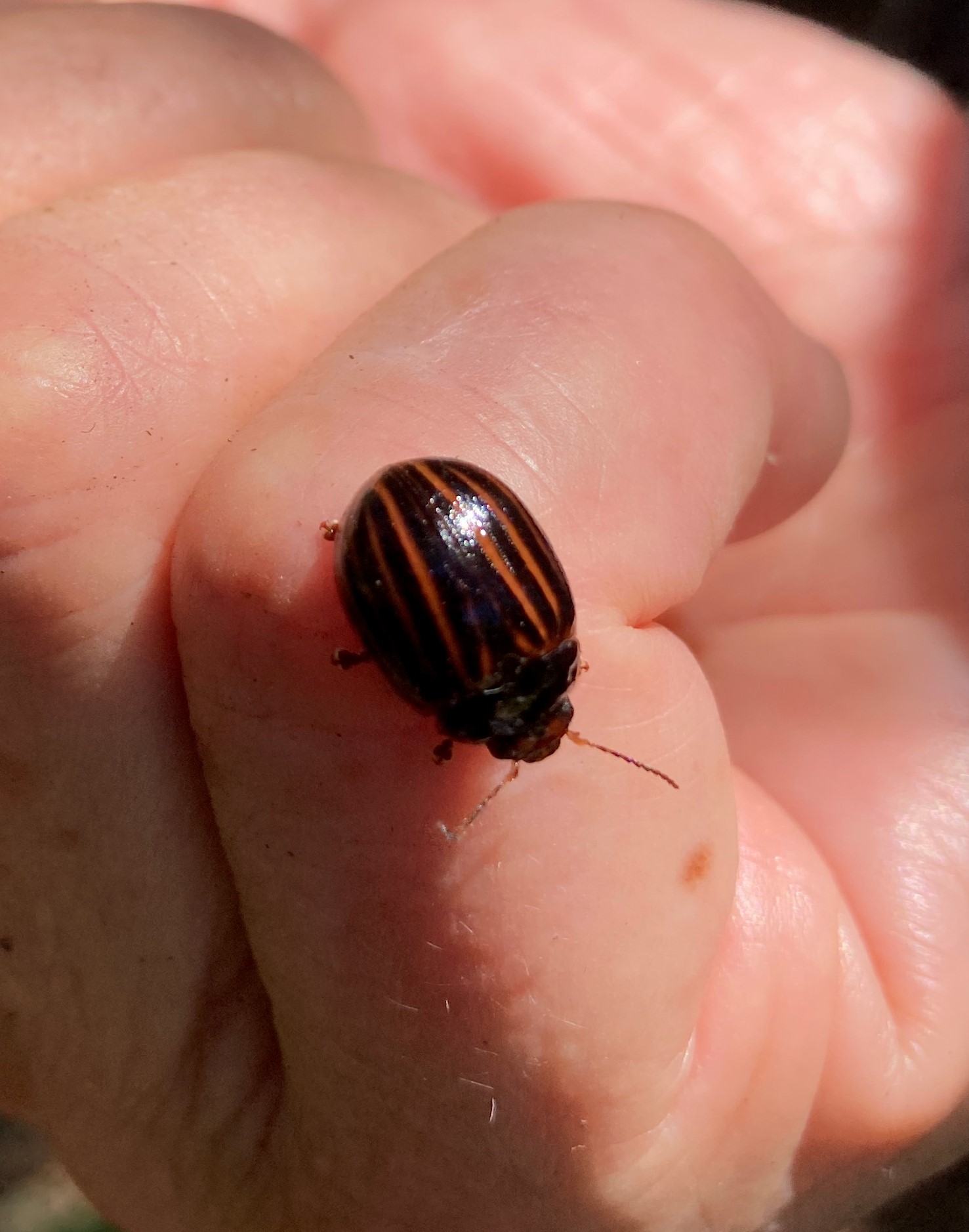
This Leaf Beetle in the genus Paropsisterna. It has been feeding on Eucalypt or Acacia foliage. It is one of Australia's many beetles. The total species number is estimated to be in the range of 80,000 to 100,000.
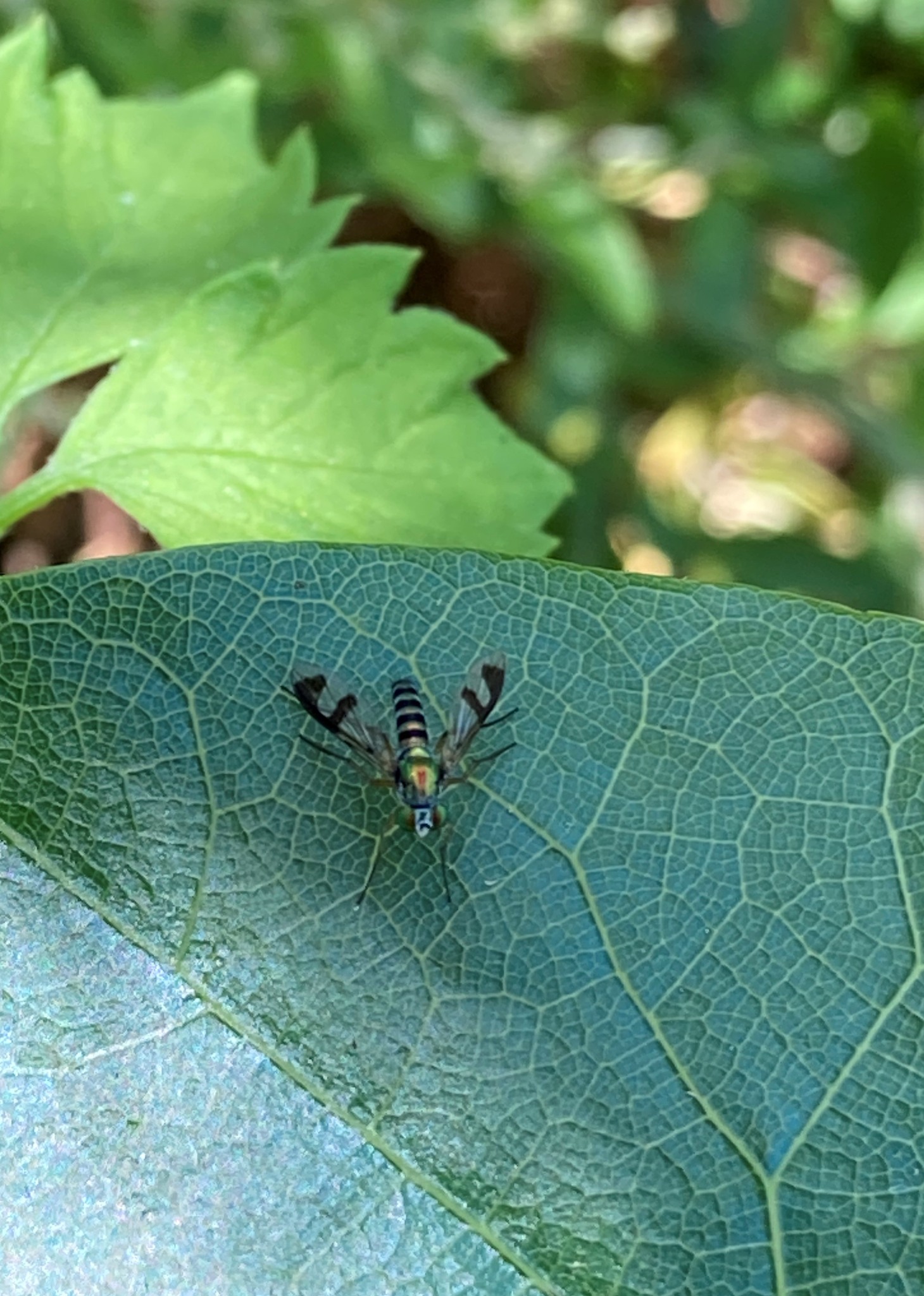
A long-legged Dancing Fly pauses on a leaf of Snake Vine.
Photos; PNHA
Ocean Street Narrabeen Bridge Works
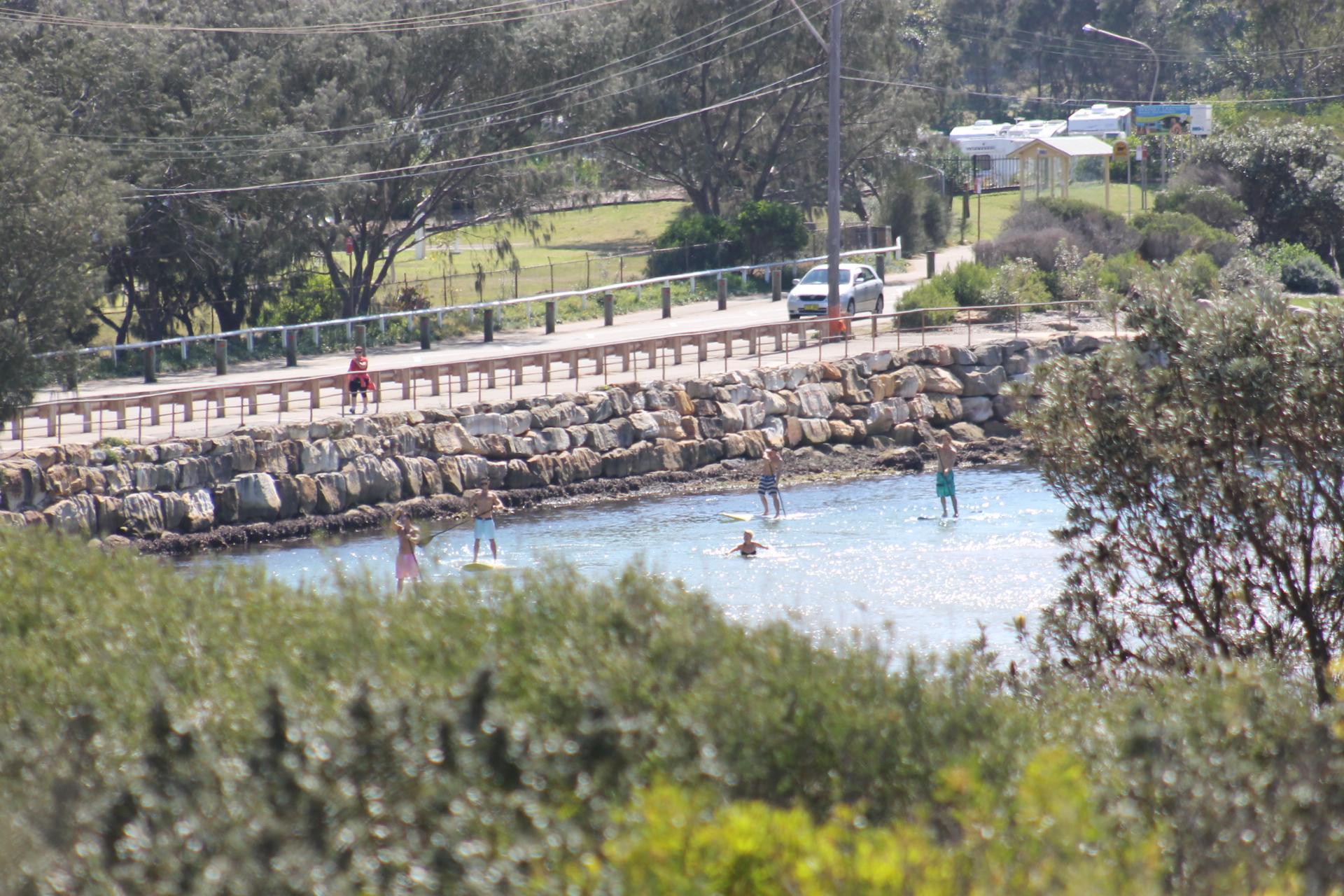
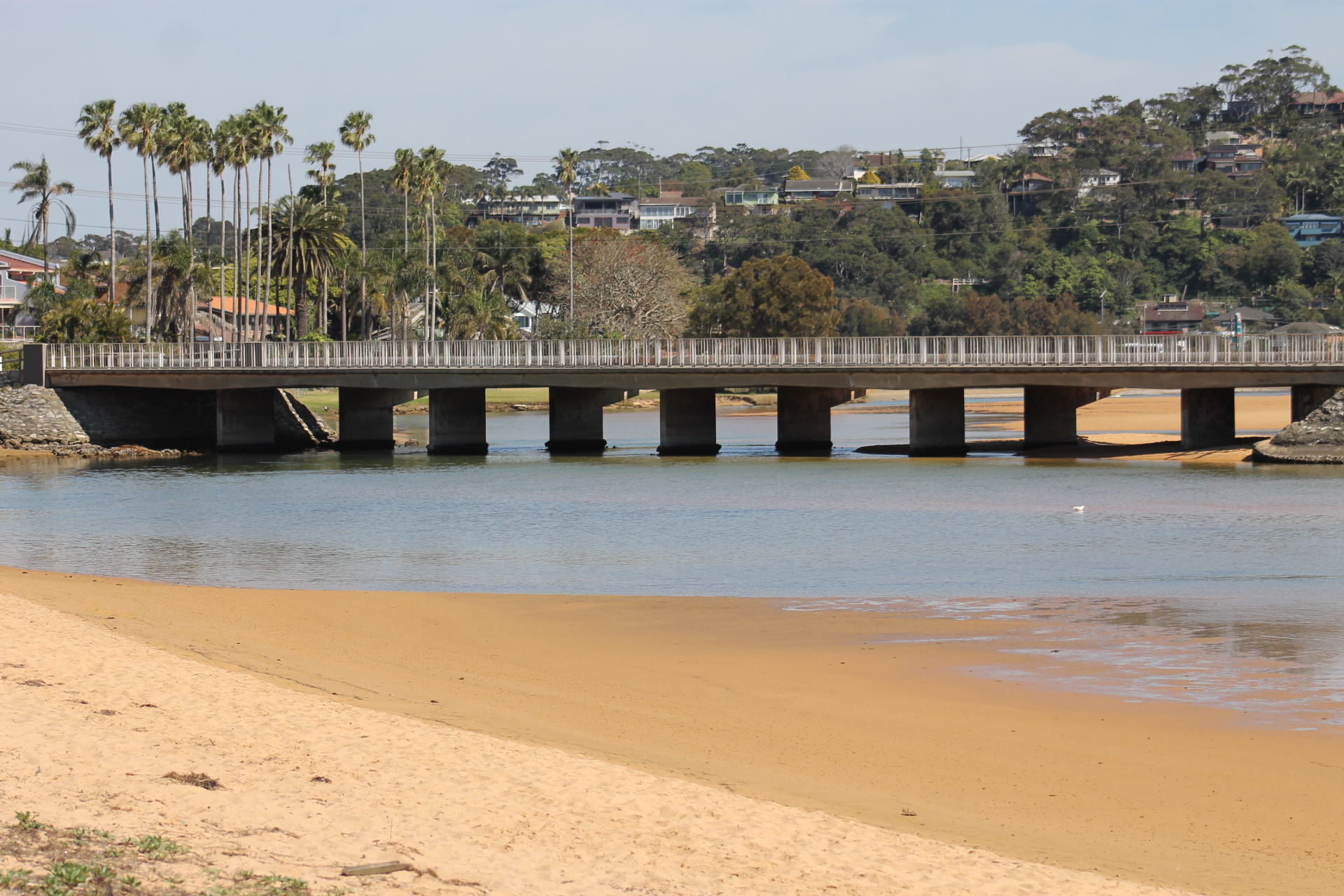
Juvenile Rainbow Lorikeet Pair
.jpg?timestamp=1675965948553)
.jpg?timestamp=1675965974397)
Black Swans On DY Lagoon
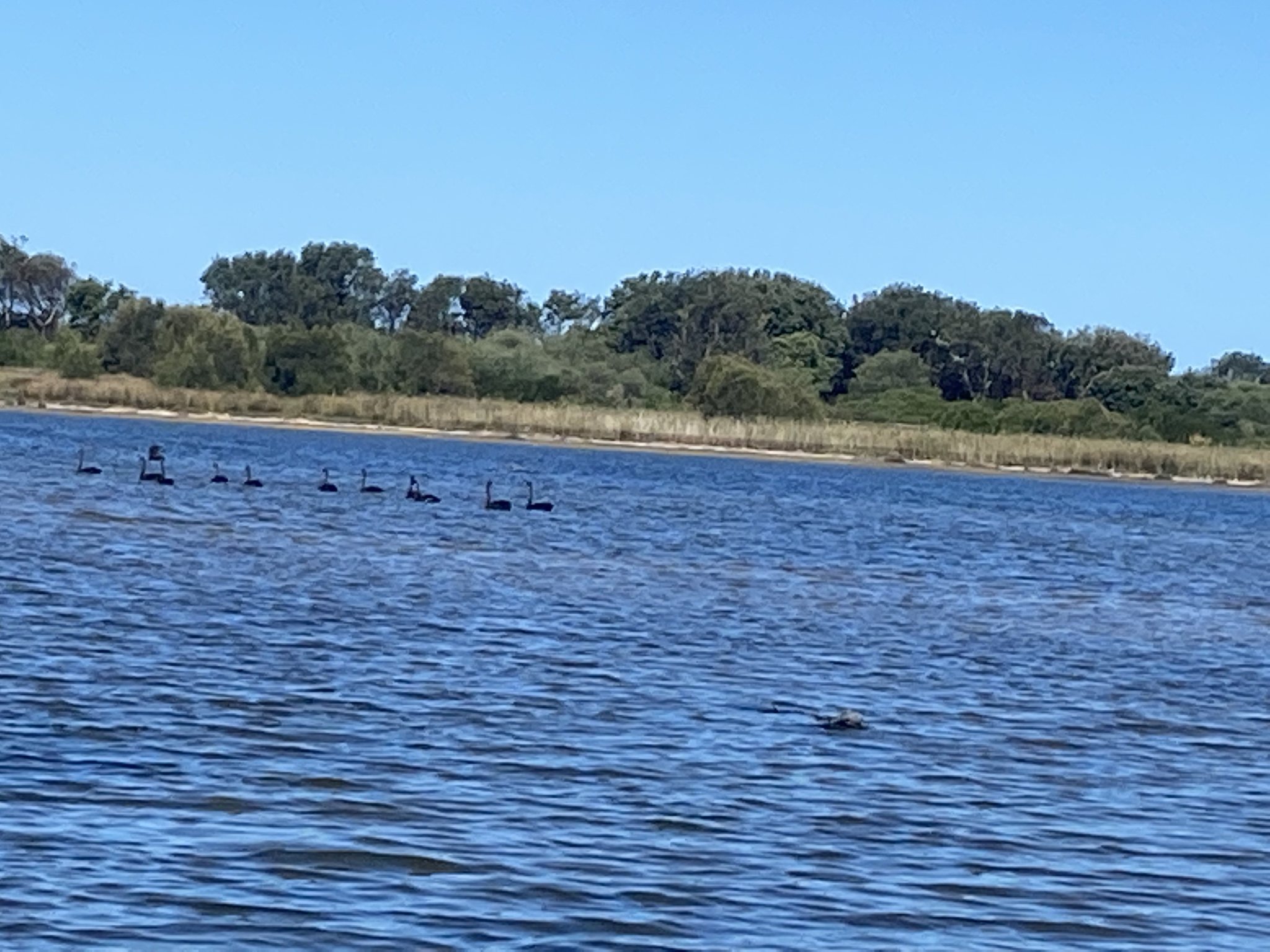
Collins Beach Clean Up
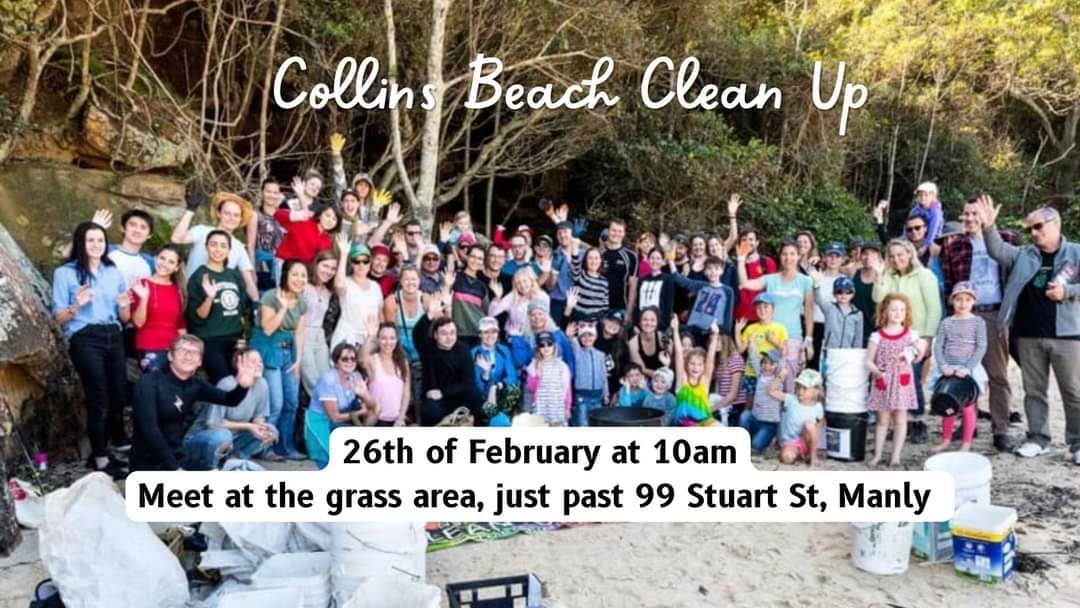
Prune Viburnum Hedge Agapanthus Flowers To Prevent Spread Into Bush Reserves
PNHA: January 11, 2023
Now is the time to prune the berries off the Viburnum hedge and dehead those old Agapanthus flowers. Put these prunings into your green waste bin. Both are now weeds of bushland as their seeds travel.
Photos: Pittwater Natural Heritage Association (PNHA)
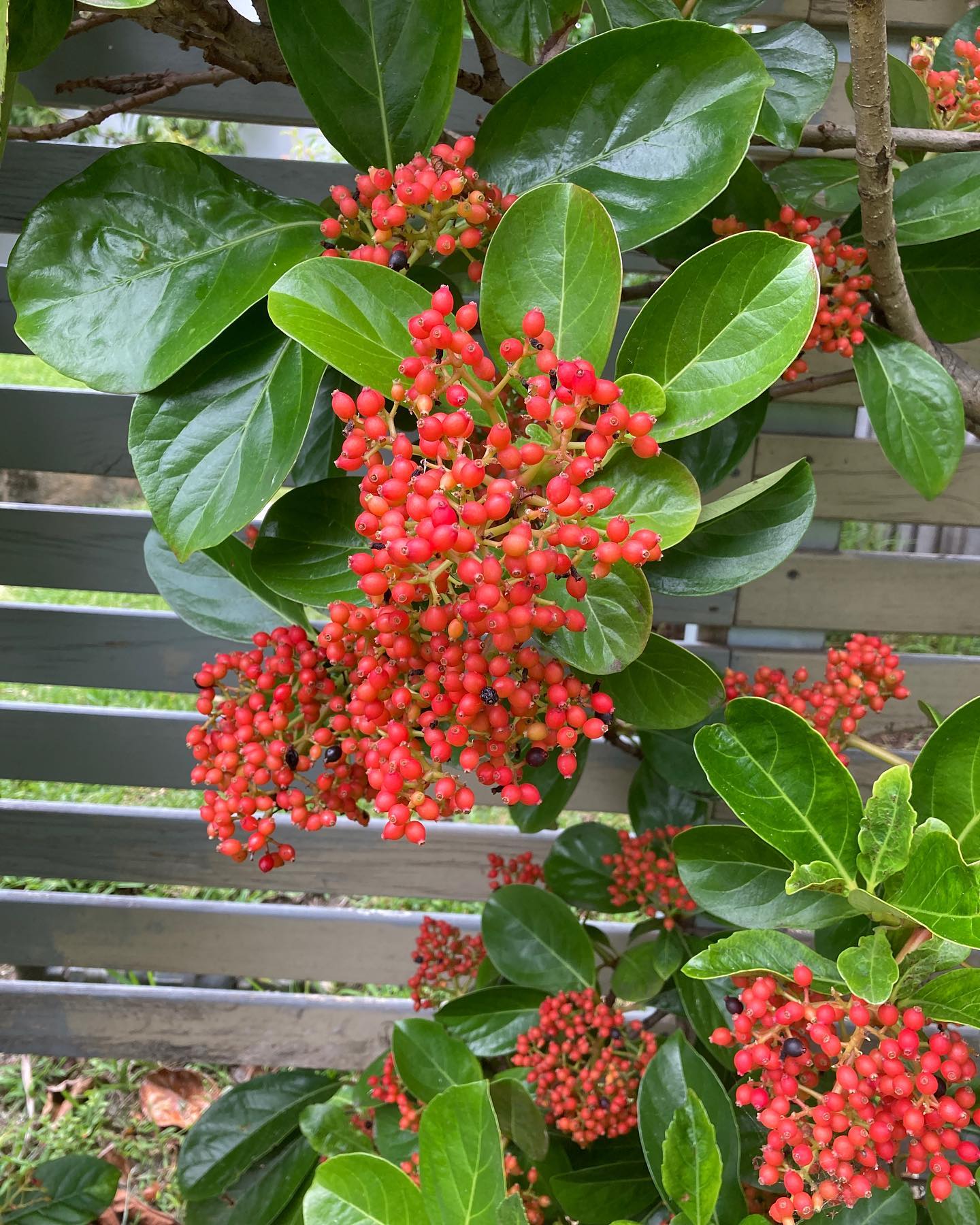
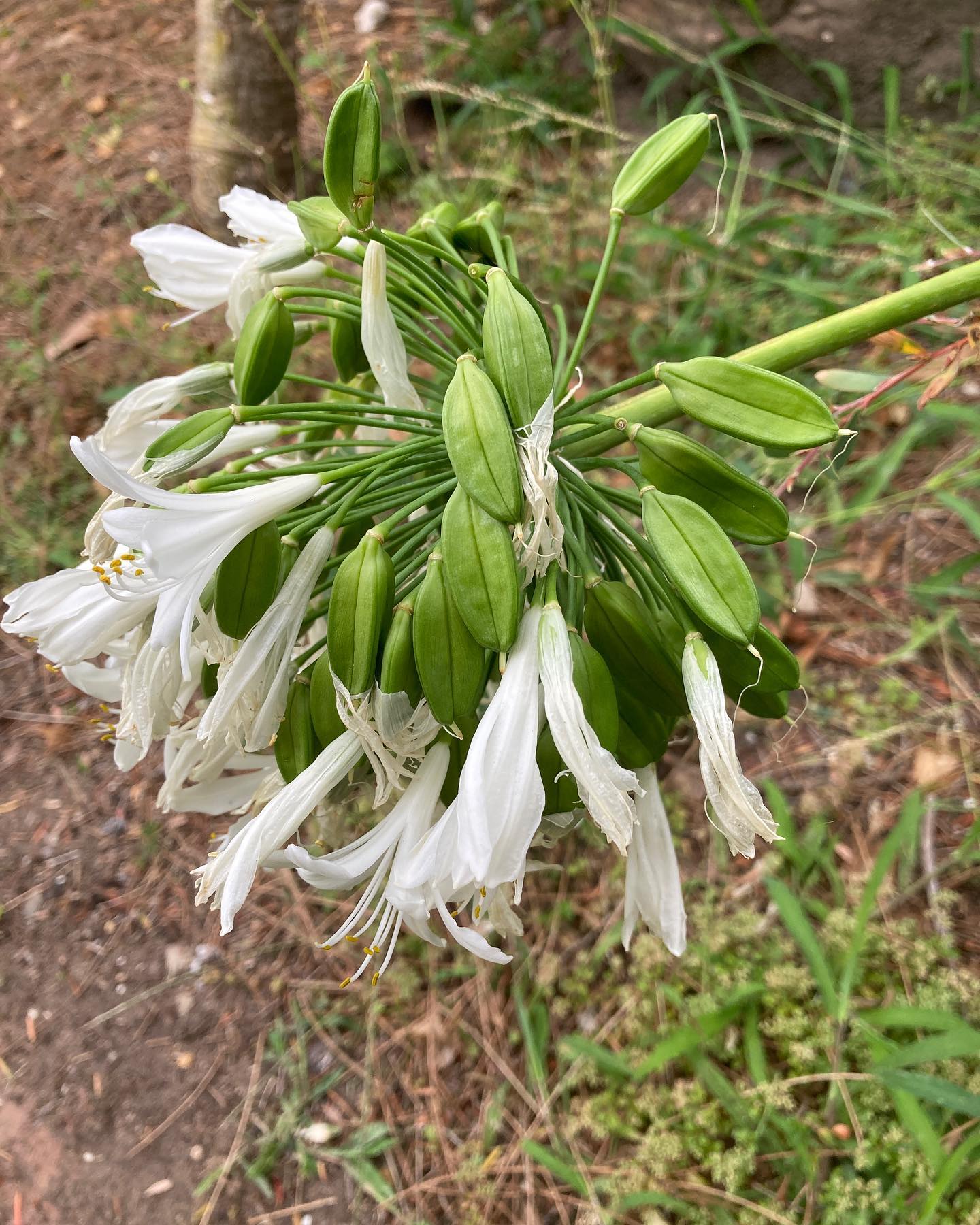
New Marine Wildlife Rescue Group Launched On The Central Coast
A new wildlife group was launched on the Central Coast on Saturday, December 10.
Marine Wildlife Rescue Central Coast (MWRCC) had its official launch at The Entrance Boat Shed at 10am.
The group comprises current and former members of ASTR, ORRCA, Sea Shepherd, Greenpeace, WIRES and Wildlife ARC, as well as vets, academics, and people from all walks of life.
Well known marine wildlife advocate and activist Cathy Gilmore is spearheading the organisation.
“We believe that it is time the Central Coast looked after its own marine wildlife, and not be under the control or directed by groups that aren’t based locally,” Gilmore said.
“We have the local knowledge and are set up to respond and help injured animals more quickly.
“This also means that donations and money fundraised will go directly into helping our local marine creatures, and not get tied up elsewhere in the state.”
The organisation plans to have rehabilitation facilities and rescue kits placed in strategic locations around the region.
MWRCC will also be in touch with Indigenous groups to learn the traditional importance of the local marine environment and its inhabitants.
“We want to work with these groups and share knowledge between us,” Gilmore said.
“This is an opportunity to help save and protect our local marine wildlife, so if you have passion and commitment, then you are more than welcome to join us.”
Marine Wildlife Rescue Central Coast has a Facebook page where you may contact members. Visit: https://www.facebook.com/profile.php?id=100076317431064
- Ph: 0478 439 965
- Email: marinewildlifecc@gmail.com
- Instagram: marinewildliferescuecc

Watch Out - Shorebirds About
.JPG.opt1460x973o0,0s1460x973.jpg?timestamp=1663629195339)
Possums In Your Roof?: Do The Right Thing

Aviaries + Possum Release Sites Needed

Bushcare In Pittwater
Where we work Which day What time
Avalon
Angophora Reserve 3rd Sunday 8:30 - 11:30am
Avalon Dunes 1st Sunday 8:30 - 11:30am
Avalon Golf Course 2nd Wednesday 3 - 5:30pm
Careel Creek 4th Saturday 8:30 - 11:30am
Toongari Reserve 3rd Saturday 9 - 12noon (8 - 11am in summer)
Bangalley Headland 2nd Sunday 9 to 12noon
Bayview
Winnererremy Bay 4th Sunday 9 to 12noon
Bilgola
North Bilgola Beach 3rd Monday 9 - 12noon
Algona Reserve 1st Saturday 9 - 12noon
Plateau Park 1st Friday 8:30 - 11:30am
Church Point
Browns Bay Reserve 1st Tuesday 9 - 12noon
McCarrs Creek Reserve Contact Bushcare Officer To be confirmed
Clareville
Old Wharf Reserve 3rd Saturday 8 - 11am
Elanora
Kundibah Reserve 4th Sunday 8:30 - 11:30am
Mona Vale
Mona Vale Beach Basin 1st Saturday 8 - 11am
Mona Vale Dunes 2nd Saturday +3rd Thursday 8:30 - 11:30am
Newport
Bungan Beach 4th Sunday 9 - 12noon
Crescent Reserve 3rd Sunday 9 - 12noon
North Newport Beach 4th Saturday 8:30 - 11:30am
Porter Reserve 2nd Saturday 8 - 11am
North Narrabeen
Irrawong Reserve 2nd Saturday 2 - 5pm
Palm Beach
North Palm Beach Dunes 3rd Saturday 9 - 12noon
Scotland Island
Catherine Park 2nd Sunday 10 - 12:30pm
Elizabeth Park 1st Saturday 9 - 12noon
Pathilda Reserve 3rd Saturday 9 - 12noon
Warriewood
Warriewood Wetlands 1st Sunday 8:30 - 11:30am
Whale Beach
Norma Park 1st Friday 9 - 12noon
Western Foreshores
Coopers Point, Elvina Bay 2nd Sunday 10 - 1pm
Rocky Point, Elvina Bay 1st Monday 9 - 12noon
Friends Of Narrabeen Lagoon Catchment Activities

Gardens And Environment Groups And Organisations In Pittwater
200 experts dissected the Black Summer bushfires in unprecedented detail. Here are 6 lessons to heed

The Black Summer bushfires of 2019-20 were cataclysmic: a landmark in Australia’s environmental history. They burnt more than 10 million hectares, mostly forests in southeast Australia. Many of our most distinctive, ancient and vulnerable species were worst affected.
A new book released today, titled Australia’s Megafires, synthesises the extent of the losses. The work involved contributions from more than 200 scientists and experts. It provides the most comprehensive assessment yet of how the fires affected biodiversity and Indigenous cultural values, and how nature has recovered.
The work reveals a picture of almost unfathomable destruction. More than 1,600 native species had at least half their range burnt. And hundreds of species and ecosystems became nationally threatened for the first time, or were pushed closer to extinction.
We must use Black Summer as an opportunity to learn – and make fundamental changes. Here, we outline six lessons to heed.
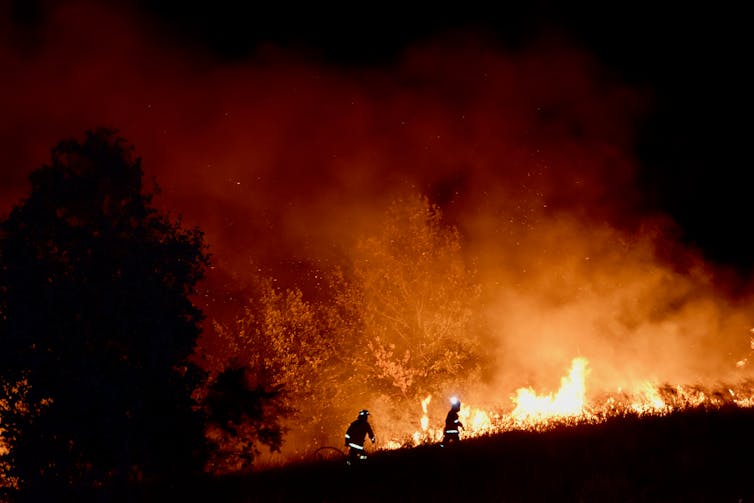
1. Natural Systems Are Already Stressed
Problem: Even before Black Summer, most Australian ecosystems were already struggling due to multiple threats.
The threatened alpine bog communities in the Australian Capital Territory, for example, were already being damaged by climate change, weeds and feral animals. Then the Black Summer fires came through and burnt 86% of known sites.
Put all these threats together, and recovery for these ecosystems – which are slow to develop – will not be easy. They may be lost altogether, along with threatened animals that call the bogs home, such as the broad-toothed rat.
Solution: Managing crises such as fires is not enough on its own. Our natural systems must be made more resilient. More effective legislation and management is needed to control all threats that degrade nature. And in some cases, threatened species may need to be relocated to put them out of harm’s way.
2. We Don’t Know What, Or Where, All Species Are
Problem: Thousands of Australian species are not (or barely) known to science. It’s very hard to protect a species if we don’t know it exists, where it lives or how it responds to fire.
For example, it’s likely that the Black Summer fires sent many invertebrate species – such as insects and spiders - to extinction. But we’ll never know because they were never described by Western science, and their distributions were never traced.
Only about 30% of Australia’s estimated 320,000 invertebrate species have been described by taxonomists. Of those that are described, most are known from only one or two records, which provides only limited insight. Information is similarly poor for fungi.
Solution: We need to gather more information about how species and environments respond to fires, and to what extent conservation efforts after fires are working. This is especially true for poorly known species groups. And the data should be made accessible to all who seek it.
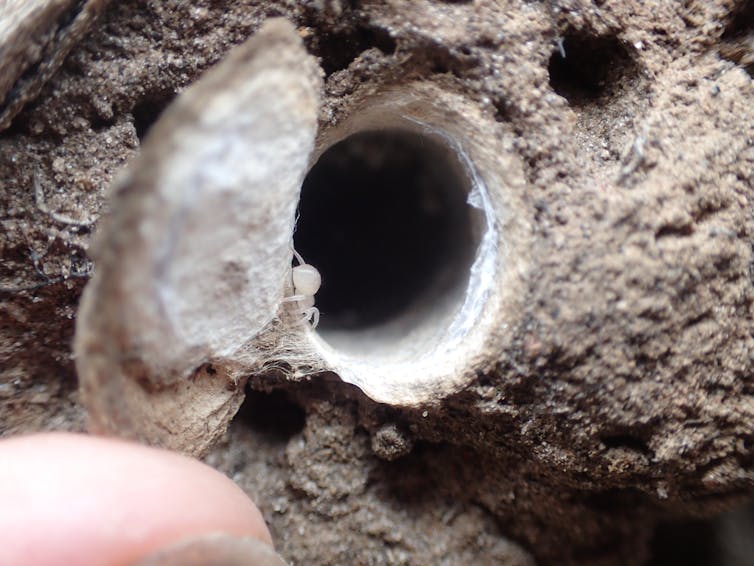
3. Emergency Responders Don’t Have Enough Information
Problem: Emergency responders told us that during the fires, they didn’t have the information to prioritise the most important areas for conservation.
We found across 13 agencies, just two threatened species were covered by a specific and accessible emergency plan: the Wollemi pine and the eastern bristlebird. These plans told emergency responders what rescue action was needed.
For example, a plan was in place to protect the only known natural stand of Wollemi pines, in New South Wales. This prompted an extraordinary firefighting effort during the Black Summer fires. The effort was successful.
Solution: More than 1,800 of Australia’s plant and animal species are at risk of extinction. We must identify which are a priority, where they are, and how to protect them from bushfires. This information must be communicated to emergency responders and incorporated into regional fire management plans.
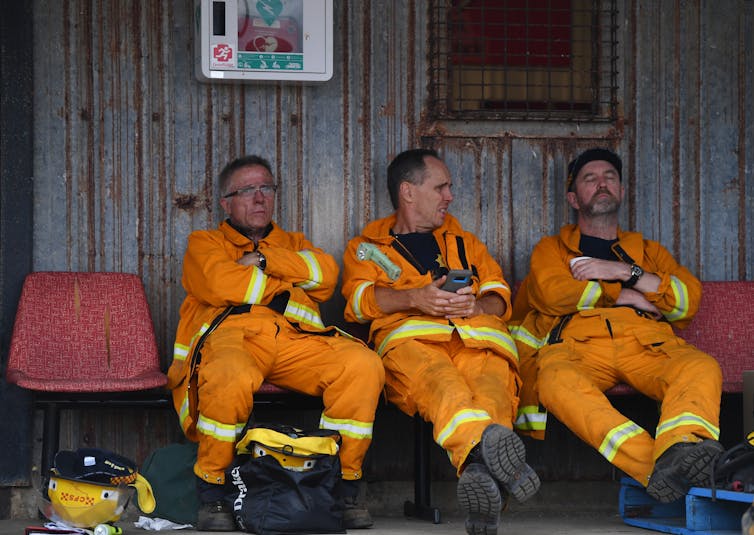
4. Biodiversity Usually Comes Last
Problem: Traditionally, the hierarchy of what to protect in disasters goes like this: first human life, then infrastructure, and finally biodiversity. If this hierarchy continues, some of our most significant species and natural environments will be lost.
In one example recounted to the book’s researchers, fire authorities decided to prioritise saving a few farm sheds over 5,000 hectares of national park.
Solution: There are cases, such as avoiding extinctions, where protecting nature is more important than saving infrastructure. Community priorities should be surveyed, and the information used to inform planning and policy.
Legal obligations to protect biodiversity in fires are few. The current re-working of federal environment laws provides an opportunity to change this.
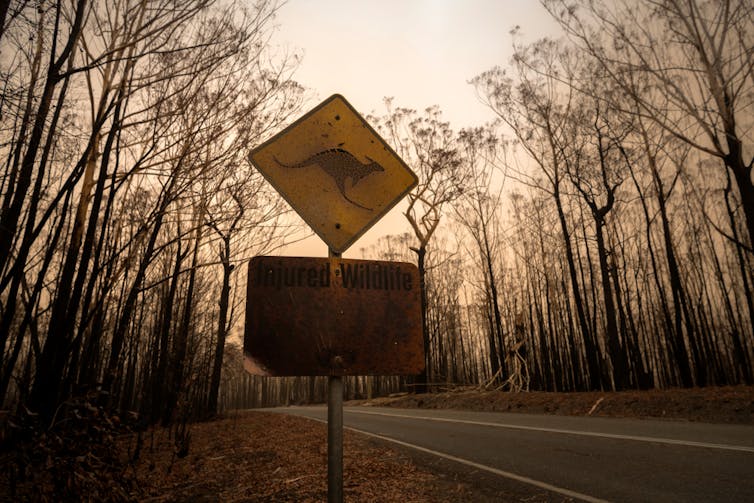
5. Conservation Funding Is Grossly Insufficient
Problem: Decades of sustained management effort is needed to recover many species and environments affected by fire. Unfortunately, funding for the task is short-term and inadequate.
For example, both state and federal governments invested heavily in controlling feral herbivores, such as deer, in the months after the fires. This was done to protect unburnt and regenerating vegetation. Yet, eventually the funding dries up and feral populations rebound.
Extra funding for some short-term recovery projects flowed in the wake of the Black Summer fires – from governments, the private sector and the community. But for many species, recovery will be a long-term proposition – if it happens at all.
Solution: Governments must stop seeing spending on the environment as optional. It’s as fundamental to our society and well-being as health and education – and funding levels should reflect this.
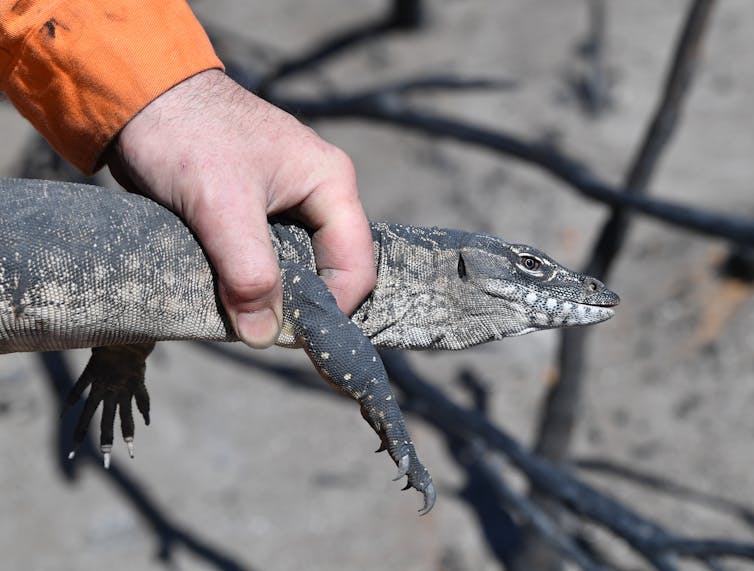
6. First Nations Knowledge Has Been Sidelined
Problem: First Nations people have used fire to manage forested landscapes for millenia. Yet their knowledge and perspectives have not been incorporated into forest fire management and recovery.
So how has this come about? Barriers identified in the book include inadequate employment and training opportunities for First Nations people to undertake cultural burning activities. Also, First Nations people are frequently denied access to Country to rekindle and develop their land management skills, and lack the legal authority to undertake cultural burning.
And as the book shows, cross-cultural challenges mean non-Indigenous fire officers can have limited appreciation or knowledge of Indigenous cultural burning protocols.
Solution: Indigenous people should be supported to rekindle cultural fire practices in forests. And non-Indigenous fire managers should, with consent from First Nations people, incorporate these practices into policies governing fire management and recovery.
What’s more, species and sites that are culturally important to First Nations people should be prioritised for protection and recovery.
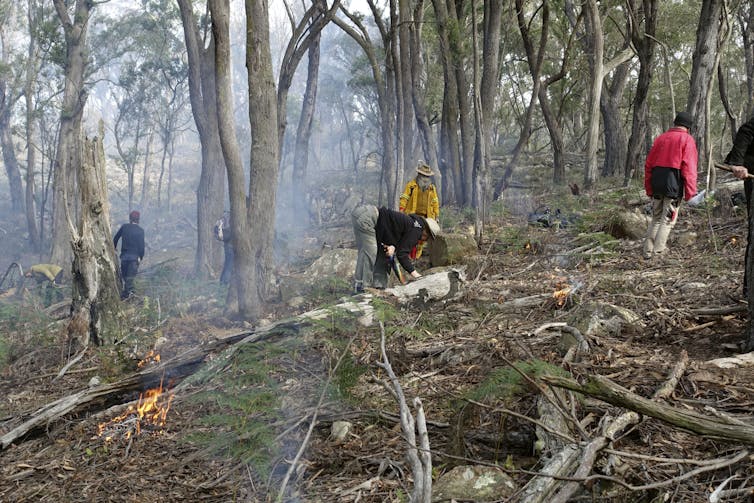
Harnessing Our Grief
The Black Summer fires showed people care. The disaster triggered an outpouring of grief from Australia and around the world. We understood one thing clearly: we were losing what enriches our lives.
But protecting our precious natural assets requires a fundamental reset of Australia’s fire management.
More broadly, the Black Summer fires kickstarted a huge collaborative recovery effort from governments, conservation and research organisations, and First Nations groups. If we’re to be better prepared for future megafires, this impetus must continue.
Libby Rumpff, Senior Research Fellow, The University of Melbourne; Brendan Wintle, Professor in Conservation Science, School of Ecosystem and Forest Science, The University of Melbourne; John Woinarski, Professor (conservation biology), Charles Darwin University; Sarah Legge, Professor, Australian National University, and Stephen van Leeuwen, Indigenous Chair of Biodiversity & Environmental Science, Curtin University
This article is republished from The Conversation under a Creative Commons license. Read the original article.
‘We need to restore the land’: as coal mines close, here’s a community blueprint to sustain the Hunter Valley
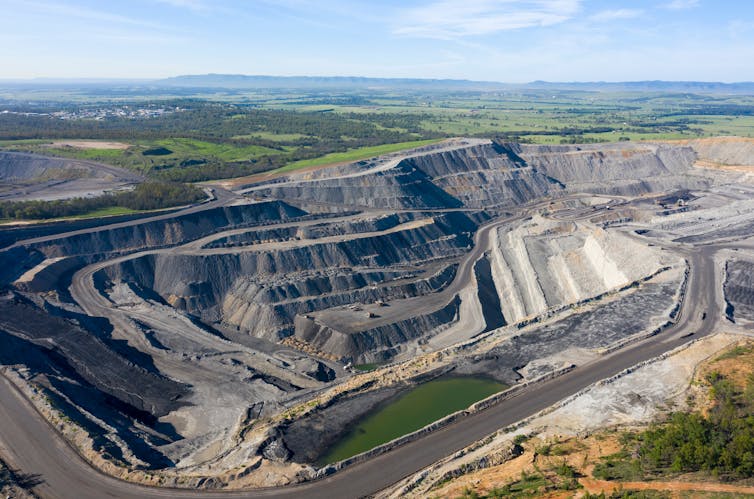
The decline of the coal industry means 17 mines in the New South Wales Hunter Valley will close over the next two decades. More than 130,000 hectares of mining land — nearly two-thirds of the valley floor between Broke and Muswellbrook — will become available for new uses.
Restoring and reusing this land could contribute billions of dollars to the Hunter economy, create thousands of full-time jobs and make the region a world leader in industries such as renewable energy and regenerative agriculture that improves soil and water quality and increases biodiversity and resilience. But to unlock these future opportunities, we must first clean up the legacy of the past.

Last year community organisation Hunter Renewal asked people across the Hunter Valley about their priorities. They told us they want the Hunter to become a thriving natural environment, a more vibrant and attractive place to live with connected communities, and a diverse and resilient economy.
These community priorities, and their implications for land use planning, are outlined in a report published by Hunter Renewal today: After the coal rush, the clean-up. A community blueprint to restore the Hunter. This blueprint could be a model for other Australian communities planning their transition away from fossil fuels.
How Were Priorities Identified?
We began by analysing more than 170 documents from government, academia and industry about post-mining land use, planning and related issues. From this, a first draft of principles and recommendations for action was created.
The draft was put to a panel of ecological, social and technical experts from the University of Newcastle. Wanaruah/Wonnorua Elders and other First Nations peoples also advised on this draft.
Hunter community members then reviewed and revised a second draft through a series of workshops, interviews and an online survey. They included land holders, students, business owners, mine rehabilitation experts, Indigenous knowledge holders and renewable energy workers.
Rehabilitation And Restoration
Hunter residents want mined lands to be restored to support biodiversity and clean industries such as regenerative farming, renewable energy, and other industries that regenerate rather than extract.
To ensure this restoration happens, stronger legal obligations would ensure mining companies cannot walk away from their obligations, leaving voids in the landscape that become a perpetual hazard to human and environmental health. As one resident said:
Mining companies shouldn’t be allowed to have a free pass at everything and get as much funding via subsidies as they do from the government.
Planning And Governance
People said that for the Hunter landscape to be restored at the scale required, planning and policy mechanisms will have to be well co-ordinated. An independent and locally based Hunter Rehabilitation and Restoration Commission could do this. It could work alongside the already proposed Hunter Valley Transition Authority.
The community suggested increasing coal-mining royalties to pay for this co-ordinated work. Mining companies would then be the ones that foot the clean-up bill.
In NSW, the royalty rate for open-cut coal is just 8.2% of the resale value. That’s too low for what is required. As another resident said:
We shouldn’t underestimate the size of the task and true cost and effort of rehabilitation of multiple large mines over decades. This is an opportunity to repurpose the land and the physical and social infrastructure.
Community Involvement
Successful mine closure and relinquishment requires that affected communities and stakeholders are meaningfully involved at every stage of planning and implementation. Yet true involvement is rare
People in the Hunter want to see greater community involvement mandated to ensure new developments benefit their communities for the long term. As one Hunter resident said:
The mines have privatised all the profits and socialised all the costs […] We want to be involved from the beginning as equals.
First Nations
In Australia all mines are on Indigenous land and over 60% of mines are near to Indigenous communities. Yet Indigenous people are less likely to benefit economically from mining operations than non-Indigenous people.
Hunter residents said this needs to change. One way to do this is to return mining land to Traditional Owners, especially unmined buffer lands.
Making decisions with First Nations people from the outset for new projects will help to overcome the systemic disadvantage in Australia since colonisation. It will also build a knowledge base for change. As one Hunter resident said:
There is so much to be gained in recognising and understanding the land management practices of the local Aboriginal people, based on 60,000 years of observation and science dealing with the oldest continent on the planet.
Climate And Environment
Plants and animals need connected ecosystems that allow them to move, adapt and survive. People in the Hunter want a region-wide system of biodiversity corridors. The transition from coal is an opportunity to set up a system that will give the region’s native species a fighting chance in a warming world.
As one resident told us:
Rehabilitating the land to ensure biodiversity is restored is the most important thing to ensure the native plant species can grow back and allow the native animals to return. We need to restore the land to try and reverse the human impacts on the site as much as possible.
Dawn Of A Cleaner Future
The coal industry has had it pretty good in this region for generations. We need a focus now on cleaning up the mess so a new, cleaner future can emerge. This requires a new approach to planning and development in partnership with local communities.
The consultative approach behind the Hunter community blueprint demonstrates the value of including a wide range of perspectives in planning for a post-coal future.
What this set of prioritised recommendations shows is that the people of the Hunter understand the complexity of the task and want to be part of planning it. It will require new laws and well-resourced public agencies capable of managing restoration and ensuring coal companies pay their dues and clean up after themselves.![]()
Kimberley Crofts, Doctoral Student, School of Design, University of Technology Sydney and Liam Phelan, Senior Lecturer, School of Environmental and Life Sciences, University of Newcastle
This article is republished from The Conversation under a Creative Commons license. Read the original article.
Tanya Plibersek killed off Clive Palmer’s coal mine. It’s an Australian first – but it may never happen again
Justine Bell-James, The University of QueenslandFederal Environment Minister Tanya Plibersek has formally rejected mining magnate Clive Palmer’s proposed Central Queensland Coal Project. Her decision was based on the risk of damage to the Great Barrier Reef, freshwater creeks and groundwater.
The 20-year open-cut mine project would have extracted up to 10 million tonnes of metallurgical coal – used to make steel – each year.
Plibersek’s decision is significant. It’s the first time a coal mine has been refused in the two decades our federal environment law has been in place. But those hoping the decision sets a precedent for other mine proposals are likely to be disappointed.
Palmer’s mine was not refused on climate change grounds. Objectors to coal mines will still need to persuade the federal government of the link between future coal mine developments and global warming.

A Rare Decision Indeed
Australia’s federal environment law is known as the Environment Protection and Biodiversity Conservation (EPBC) Act. It came into force in 2000 to provide federal oversight of large projects.
Under the law, proponents must refer a proposal to federal environment authorities if it’s likely to significantly impact so-called “matters of national environmental significance”. These matters include the Great Barrier Reef.
But it’s extremely rare that any development is refused under the EPBC Act. As of July last year, more than 7,000 projects had been referred to the federal government under the law, for assessment of the proposal’s impacts. Just 13 were ultimately refused.
So why did Palmer’s proposed mine cross this exceptional hurdle for refusal? Largely because of its location. The proposed site was just ten kilometres from the Great Barrier Reef world heritage area.
Explaining the decision on Wednesday, Plibersek said:
[…] risks to the Great Barrier Reef, freshwater creeks and groundwater are too great. Freshwater creeks run into the Great Barrier Reef and onto seagrass meadows that feed dugongs and provide breeding grounds for fish.

The Thin End Of The Wedge?
Plibersek’s decision has triggered calls for the federal government to reject other fossil fuel projects.
For example, Greens environment spokeswoman Sarah Hanson-Young on Wednesday described Plibersek’s decision as “the thin edge of the wedge”. She went on:
There [were] 118 new coal and gas projects in the pipeline. One down, 117 to go.
From Narrabri’s double-whammy new coal and gas projects, Woodside’s North West Shelf offshore gas extension, billionaire miner Gina Rinehart’s proposed CSG expansion in the Surat Basin, or the Mount Pleasant coal project extension in the Hunter, the Minister has many projects left to rule out.
Approving more coal and gas in the midst of a climate crisis is reckless and dangerous.
However, persuading the federal minister to reject these mines will not be easy. That’s because the law contains no explicit requirement for the minister to consider the climate change impacts of a proposal.
This certainly hasn’t stopped litigants from challenging projects on climate grounds. But to date, none have succeeded.
Other legal objections – such as one brought by the Australian Conservation Foundation against the Adani mine – have taken a different tack. They’ve sought to show the carbon emissions resulting from burning coal from a mine would harm a matter of national environmental significance.
The ACF argued the Adani mine was inconsistent with Australia’s international obligations to protect the Great Barrier Reef. But the challenge was unsuccessful.
Such arguments are difficult to run. That’s partly because they string together a number of causal links. In other words, they rest on the assumption that one action is definitively responsible for another, and so on down the chain.
Such links may be possible to show in cases such as the Palmer mine, when a development is close to the coast and its direct operation might pollute waterways. But it’s harder to show that coal from a single mine, burnt by a third party, will damage the Great Barrier Reef.
Room For Hope
Plibersek’s decision is unlikely to set a precedent for federal mine approvals.
The EPBC Act could, in theory, be strengthened to give the minister more power to reject a proposal on climate grounds. But unfortunately, the Albanese government’s promised reforms of the law fail to do so.
First, the reforms failed to include a “climate trigger” – a mechanism by which development proposals are not approved unless their climate impact has been considered.
Second, the reforms fail to make so-called “scope 3 emissions” a mandatory consideration in environmental approvals. These types of emissions are produced indirectly – such as when a company’s coal is burned for energy.
There is room for hope, however. The federal government’s Climate Change Act enshrines in law Australia’s goal of reaching net-zero emissions by 2050. Under this policy position, the approval of large coal mines will become increasingly difficult to reconcile.
And in recent years, some state courts have been convinced by causal arguments linking mines to climate change. So future federal decisions are unlikely to be immune from further challenge.
What’s Next For Clive Palmer?
Plibersek’s decision comes during a bad few months for Palmer. In November last year, Queensland’s Land Court recommended Palmer’s proposed Waratah coal project in Queensland also be rejected due to its likely contribution to climate change, and subsequent erosion of human rights.
Palmer can seek a judicial review of the latest decision. But success would rest on whether it could be shown Plibersek’s decision involved a legal error. These types of challenges are notoriously difficult – so there’s a good chance this proposed mine has reached the end of the road. ![]()
Justine Bell-James, Associate Professor, TC Beirne School of Law, The University of Queensland
This article is republished from The Conversation under a Creative Commons license. Read the original article.
The coal whack-a-mole: getting rid of coal power will make prices fall and demand rise elsewhere
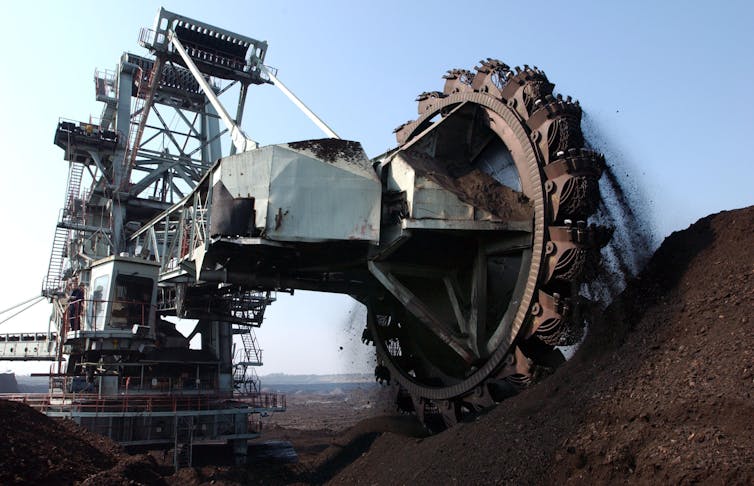
The fight against climate change is full of inconvenient truths. The latest? Coal is going to be harder to get rid of than we had hoped. Every victory like the rejection of Clive Palmer’s proposed Rockhampton coal mine seems to be offset by coal’s gains elsewhere.
Potsdam Institute experts this week published research suggesting we have less than 5% chance of actually ending coal use by 2050. That would make the Paris Agreement goal of keeping global heating under 1.5℃ all but impossible.
Why? Supply and demand coupled with domestic policies and priorities. While coal power is likely to drop sharply, coal use will rebound in other sectors, according to the research. Why? As some countries move to clean energy, the price of coal will fall. Once coal is cheaper, other countries or domestic sectors such as steelmaking are likely to seize the opportunity and buy more. The researchers estimate for every 100 joules of coal not burned in power plants, an extra 54 joules will be burned in other sectors, in a trend they dub “coal leakage”.
Leakage poses a new challenge, just as the world seems set to accelerate climate action. The only answer? Accelerate even faster.
Fossil Fuels Are Extraordinarily Resilient
What this study tells us is our current efforts won’t be enough – even with the current tailwinds of Europe’s gas crisis and plunging renewable costs.
In 2017, nations at the annual United Nations climate talks launched the Powering Past Coal Alliance in an effort to speed up action. But according to the Potsdam research, efforts by the 48 nations and 49 sub-national regions involved could be counterproductive.
That’s because members of this alliance haven’t taken steps to avoid the risk of rebound coal use – even elsewhere in their own economies.
Depressingly, this is part of a trend. The fossil fuel sector is proving powerfully resistant to change. The world keeps on burning more fossil fuels despite the COVID lockdown drop in 2020. Coal burning increased by 6.3% in 2021, and the International Energy Agency estimates this figure will have increased again by 1.2% in 2022 to reach a historic high.
Russia’s invasion of Ukraine saw coal use soar, as Europe weaned itself off Russian gas. Germany had to delay its plans to quit coal power within 15 years and fire up coal plants again over the winter, while Japan’s reliance on coal has only grown in recent years.
In developing countries, coal is seen as a cheap, convenient and proven way to power the economy. China is far and away the world’s largest coal user – and producer. The downside has been terrible air pollution. That forced the government to force millions of households to replace coal with natural gas or electricity for heating, while supercharging its renewable sector, which now produces almost 30% of its electricity.
But as China’s economy slows and energy shortages increase, the government has backtracked and approved 300 million tonnes of new coal production capacity in 2022, on top of 220 million tons of capacity added in 2021. That’s more than all the coal Australia produced in 2021 (478 million tonnes).
New coal power projects have also been boosted, with 65 gigawatts of new coal power projects approved by the Chinese government in the first 11 months of 2022 – more than three times the capacity approved in 2021.
It’s no wonder coal and other fossil fuel producers are enjoying windfall profits. Australian coal exporters earned A$45 billion over 2021–22 thanks to soaring prices in the international market.

What About The Huge Investment In Renewables?
You might read this with your heart sinking and think – wait, wasn’t 2022 the first year the world invested more than US$1 trillion (A$1.44 trillion) in clean energy? How can coal rebound while we switch to clean energy?
Yes, we’ve seen stunning and welcome growth in green energy technologies and related industries. This has been driven by government policies, corporate demand for clean energy and the ever-increasing market competitiveness of solar, wind and offshore wind.
Unfortunately, what this new research tells us is that both are true. Renewables are racing ahead. But the world’s demand for energy grows and grows as nations get richer and the population grows. To phase out fossil fuels remains the hardest challenge we face. The solutions will have to be hashed out politically.
After all, we now have almost all the technologies we need to stop burning fossil fuels. (Aviation, cargo ships and steelmaking are some of the hardest sectors to clean up.)
What Do We Do?
Put simply, we’re almost out of time. Any delay in ending our reliance on coal and keeping those carbon-dioxide dense rocks safely stored in the ground is extremely dangerous.
Sustained political effort does work. Even though Germany had to reopen some coal plants, their reliance on coal for electricity fell from 60% in 1985 to below 30% in 2020.
To end coal means clamping down on free-riders. Australia is a good case study. The companies which own our doddering old coal stations are heading for the exit as quickly as they can. Even the newest coal power stations are expected to have shorter lifetimes than anticipated. But to date, there’s been little effort to ensure coal doesn’t simply get burned in, say, steelworks.
Internationally, developed countries should offer greater financial incentives to help developing countries switch to renewables. In 2021, rich countries offered billions to South Africa to quit coal. Last year, they made a similar offer to Indonesia. This is welcome – but we need more.
Worldwide, 770 million people still live without access to electricity. For years, China used this as a justification for funding coal plants overseas. But in 2021, President Xi Jinping announced this would end.
Moves like this are essential. We can’t simply expect markets to end the burning of coal as quickly as we need. That means we’ll need policies to do the work.
To nail down the coffin on fossil fuels, we have to embrace what economists call “creative destruction” – the ability for technologies to disrupt the old and create the new. Coal and oil ended centuries of reliance on horses for transport. Now it’s time to end our reliance on fossil fuels – to destroy the old and make room for the new. ![]()
Hao Tan, Associate Professor, Newcastle Business School, University of Newcastle
This article is republished from The Conversation under a Creative Commons license. Read the original article.
The new climate denial? Using wealth to insulate yourself from discomfort and change

While the days of overt climate denial are mostly over, there’s a distinct form of denial emerging in its stead. You may have experienced it and not even realised. It’s called implicatory denial, and it happens when you consciously recognise climate change as a serious threat without making significant changes to your everyday behaviour in response.
Much research has focused on how we intellectually distance ourselves from the unpleasant realities happening around us. What requires greater attention is how we may engage in climate denial by seeking out spaces of sensory comfort and using them to shield ourselves as the world unravels outside our window.
Denial, thought of in this way, is entirely sensible. My colleagues and I asked residents around the Western Sydney suburb of Penrith – famously the hottest place on Earth during the Black Summer of 2019-20 – about their experiences during heatwave conditions. Unsurprisingly, sensory denial is central to how they cope with extremes – primarily by using air conditioning.
Those without access to aircon resorted to wetting towels, or using fans and spray bottles. While these low-cost strategies are actually more sustainable than aircon, people don’t like them as much. Given the opportunity, we’re likely to engage in sensory climate denial as a way to insulate ourselves from experiences of climate change.

Why Do Our Senses Matter When It Comes To Climate Denial?
We tend to think of climate denial as a delaying tactic used by fossil fuel advocates. This is not wrong, given climate denial was strategically created and fostered by politicians and coal, oil and gas companies with vested interests in stalling action and deflecting responsibility.
Researchers have historically linked climate denial to inadequate knowledge, sociopolitical biases or emotional defence. Other researchers have focused on beliefs, psychological barriers, and moral disengagement.
But focusing on how and why we think overlooks the main way we actually respond to our environments: our bodies. The role of our senses and their influence on our everyday behaviour tends to be overlooked in social and political thought. Reckoning with climate change inaction demands we return to our senses. Here, we find climate denial is more than just a political tool.
Within our communities, it’s the way in which different segments of society are able to maintain a physical sense of normalcy and comfort, while others bear the brunt of climate disasters.
A heatwave in Western Sydney in 2016-17 reflects this clear divide, as colleagues and I found in earlier research.
People who lived in households without aircon were hit hard by the heat. It affected their bodies and emotions, making them fatigued, sometimes nauseous, anxious and stressed. It was hard for them to do anything other than swelter or seek out spaces of relief where possible. In contrast, people with aircon were far less affected, or even unbothered by the heat. They knew there was a heatwave, but it didn’t directly affect them.
One resident told us of trying to sleep without aircon:
If you only get maybe three or four hours sleep – and it’s not good sleep – … it’s like, “I can cope today.” (By) the third sleep, it’s like, “Please keep away from me” … And every day after that just gets worse and worse.
Another resident told us of the relief she felt at being able to leave her overheated house, taking her kids and staying at a friend’s house with both air conditioning and a pool. “It was like a holiday,” she said.
Both groups were being entirely rational in seeking relief from the overwhelming heat in whatever ways they could. Those without aircon longed for the relief it would bring.
For those with aircon, their main concern was the cost of running it. While this is a burden, the fact this was their main worry indicates aircon worked. Their relative wealth shielded them.
Why Does This Matter?
If we use technologies like aircon to avoid dealing with the root causes of climate change, we are in denial.
As the world heats up, demand for air conditioning has skyrocketed. The International Energy Agency has estimated that by 2050, up to two-thirds of the world’s households will have installed aircon, particularly in China, India and Indonesia.
As a privatised answer to a public problem, aircon reliance has been normalised to the point of invisibility. When we use our air conditioners to fend off a heatwave, we can overwhelm the power grid and trigger local blackouts. Worse, with today’s energy sources, our need for sensory comfort causes yet more emissions to be pumped into the atmosphere. On a street level, air conditioners make your house colder and the outside air warmer still.

This pattern of sensory comfort for wealthier people is systemically reinforced in for-profit housing developments, while lower-income rentals and public housing are legally and financially excluded. These residents are forced to rely instead on evacuation shelters or spending hours in airconditioned shopping centres.
This kind of denial, then, is tied to forms of privilege. To be able to literally shut out climate disruption and pretend everything is normal speaks to our universal desire to live in comfort and without pain. But as the climate warps, this is possible only for some.
If you had the opportunity, of course you would shut yourself and your loved ones away from the disruption, discomfort and danger of heatwaves, floods and bushfires.
The risk is we anaesthetise ourselves to what’s really going on. Inequality is rampant in Australia and worldwide, and people without the means to insulate themselves will suffer the most.
To tackle sensory climate denial means understanding that immunity to climate disruption is a temporary fantasy. As our ecosystems and climatic stability crumble, this kind of denial will inevitably vanish. ![]()
Hannah Della Bosca, PhD Candidate and Research Assistant at Sydney Environment Institute, University of Sydney
This article is republished from The Conversation under a Creative Commons license. Read the original article.
Plastic Debris In The Arctic Comes From All Around The World
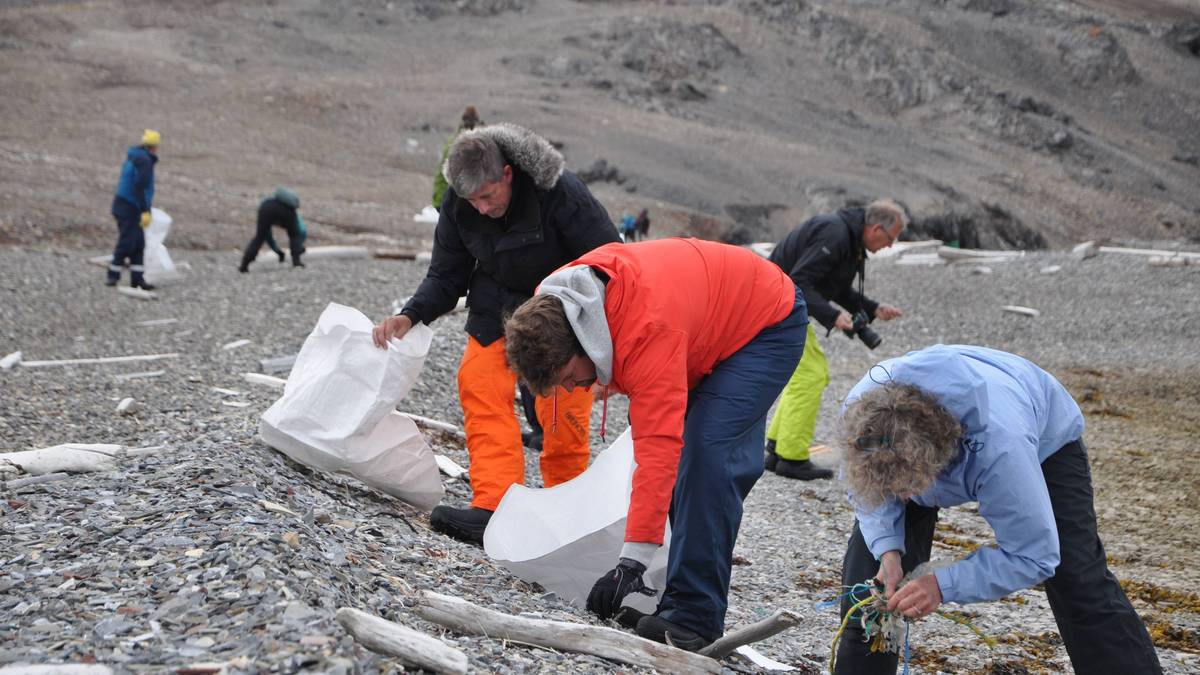
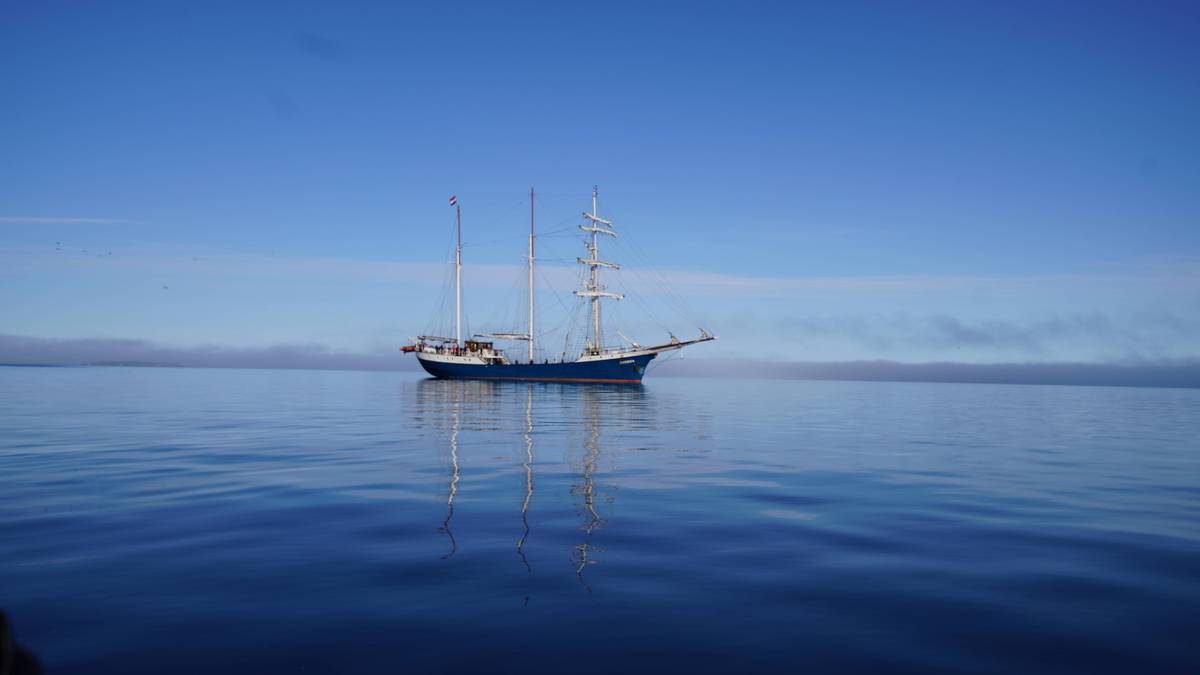
How Waste-Eating Bacteria Digest Complex Carbons: New Information Could Lead To Bacteria-Based Platforms That Recycle Plastic And Plant Waste

Earth has lost one-fifth of its wetlands since 1700 – but most could still be saved
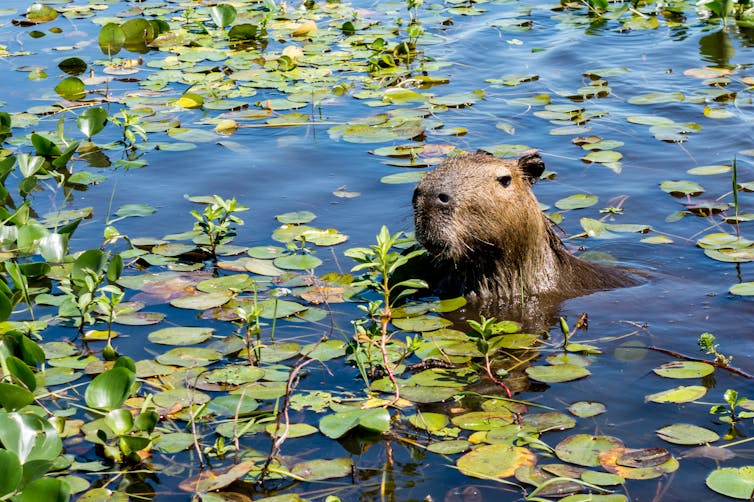
Like so many of the planet’s natural habitats, wetlands have been systematically destroyed over the past 300 years. Bogs, fens, marshes and swamps have disappeared from maps and memory, having been drained, dug up and built on.
Being close to a reliable source of water and generally flat, wetlands were always prime targets for building towns and farms. Draining their waterlogged soils has produced some of the most fertile farmland available.
But wetlands also offer some of the best natural solutions to modern crises. They can clean water by removing and filtering pollutants, displace floodwater, shelter wildlife, improve our mental and physical wellbeing and capture climate-changing amounts of carbon.
Peatlands, a particular type of wetland, store at least twice the carbon of all the world’s forests.
How much of the Earth’s precious wetlands have been lost since 1700 was recently addressed by a major new study published in Nature. Previously, it was feared that as much as 50% of our wetlands might have been wiped out. However, the latest research suggests that the figure is actually closer to 21% - an area the size of India.
Some countries have seen much higher losses, with Ireland losing more than 90% of its wetlands. The main reason for these global losses has been the drainage of wetlands for growing crops.
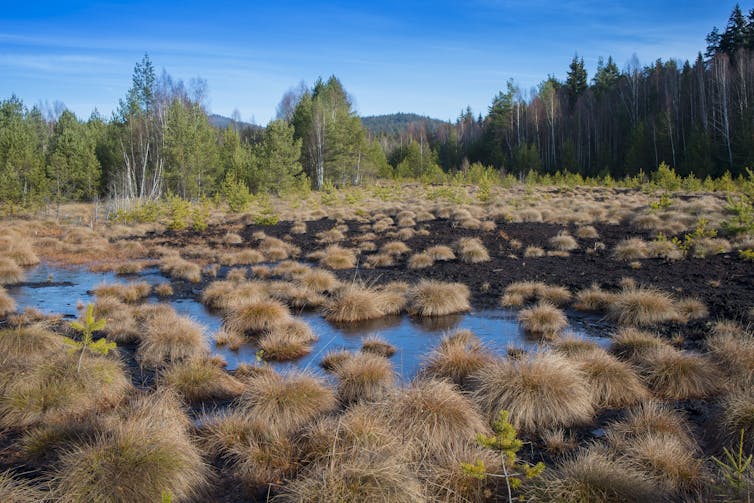
Wetlands Are Not Wastelands
This is the most thorough investigation of its kind. The researchers used historical records and the latest maps to monitor land use on a global scale.
Despite this, the new paper highlights some of the scientific and cultural barriers to studying and managing wetlands. For instance, even identifying what is and isn’t a wetland is harder than for other habitats.
The defining characteristic of a wetland – being wet – is not always easily identified in each region and season. How much is the right amount of wetness? Some classification systems list coral reefs as wetlands, while others argue this is too wet.
And for centuries, wetlands were seen as unproductive wastelands ripe for converting to cropland. This makes records of where these ecosystems used to be sketchy at best.
The report shows clearly that the removal of wetlands is not spread evenly around the globe. Some regions have lost more than average. Around half of the wetlands in Europe have gone, with the UK losing 75% of its original area.
The US, central Asia, India, China, Japan and south-east Asia are also reported to have lost 50% of their original wetlands. It is these regional differences which promoted the idea that half of all the world’s wetlands had disappeared.

This disparity is somewhat hopeful, as it suggests there are still plenty of wetlands which haven’t been destroyed – particularly the vast northern peatlands of Siberia and Canada.
An Ecological Tonic
Losing a wetland a few acres in size may not sound much on a global or even national scale, but it’s very serious for the nearby town that now floods when it rains and is catastrophic for the specialised animals and plants, like curlews and swallowtail butterflies, living there.
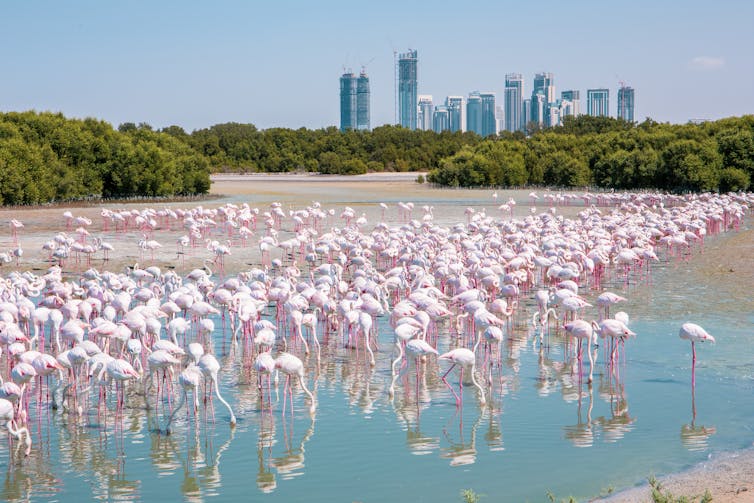
Fortunately, countries and international organisations are beginning to understand how important wetlands are locally and globally, with some adopting “no-net-loss” policies that oblige developers to restore any habitats they destroy. The UK has promised to ban the sale of peat-based composts for amateur growers by 2024.
Wetland habitats are being conserved around the world, often at huge expense. Over US$10 billion (£8.2 billion) has been spent on a 35-year plan to restore the Florida Everglades, a unique network of subtropical wetlands, making it the largest and most expensive ecological restoration project in the world.
The creation of new wetlands is also underway in many places. The reintroduction of beavers to enclosures across Britain is expected to increase the nation’s wetland coverage, bringing with it all the advantages of these habitats.
Beaver dams and the wetlands they create reduce the effects of flooding by up to 60% and can boost the area’s wildlife. One study showed the number of local mammal species shot up by 86% thanks to these furry engineers.
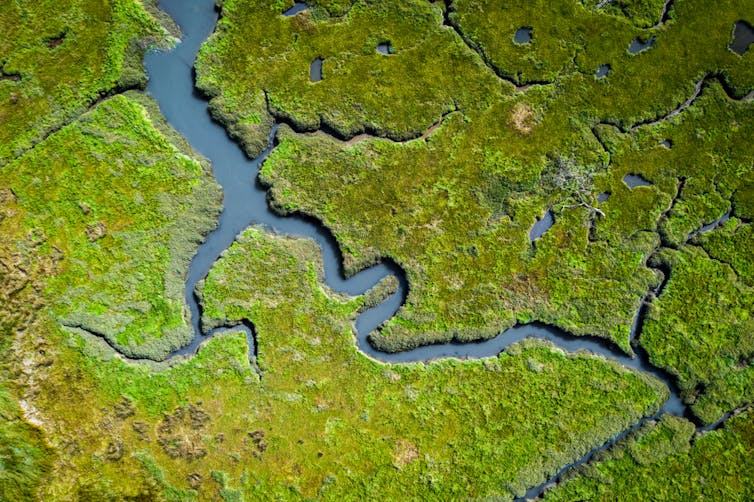
Even the sustainable drainage system ponds developers create on the fringes of new housing estates could see pocket wetlands appearing in towns and cities across the UK. By mimicking natural drainage regimes instead of removing surface water with pipes and sewers, sustainable drainage systems can create areas of plants and water that have been shown to increase biodiversity, especially invertebrates.
Whether the total global loss of wetlands is 20% or 50% doesn’t really matter. What does matter is that people stop looking at wetlands as wastelands, there for us to drain and turn into “useful” land.
As the UN recently pointed out, an estimated 40% of Earth’s species live and breed in wetlands and a billion people depend on them for their livelihoods. Conserving and restoring these vital habitats is key to achieving a sustainable future.

Don’t have time to read about climate change as much as you’d like?
Get a weekly roundup in your inbox instead. Every Wednesday, The Conversation’s environment editor writes Imagine, a short email that goes a little deeper into just one climate issue. Join the 10,000+ readers who’ve subscribed so far.![]()
Christian Dunn, Senior Lecturer in Natural Sciences, Bangor University
This article is republished from The Conversation under a Creative Commons license. Read the original article.
A tenth of all electricity is lost in the grid. Superconducting cables can help

For most of us, transmitting power is an invisible part of modern life. You flick the switch and the light goes on.
But the way we transport electricity is vital. For us to quit fossil fuels, we will need a better grid, connecting renewable energy in the regions with cities.
Electricity grids are big, complex systems. Building new high-voltage transmission lines often spurs backlash from communities worried about the visual impact of the towers. And our 20th century grid loses around 10% of the power generated as heat.
One solution? Use superconducting cables for key sections of the grid. A single 17-centimetre cable can carry the entire output of several nuclear plants. Cities and regions around the world have done this to cut emissions, increase efficiency, protect key infrastructure against disasters and run powerlines underground. As Australia prepares to modernise its grid, it should follow suit. It’s a once-in-a-generation opportunity.
What’s Wrong With Our Tried-And-True Technology?
Plenty.
The main advantage of high voltage transmission lines is they’re relatively cheap.
But cheap to build comes with hidden costs later. A survey of 140 countries found the electricity currently wasted in transmission accounts for a staggering half-billion tonnes of carbon dioxide – each year.
These unnecessary emissions are higher than the exhaust from all the world’s trucks, or from all the methane burned off at oil rigs.
Inefficient power transmission also means countries have to build extra power plants to compensate for losses on the grid.
Labor has pledged A$20 billion to make the grid ready for clean energy. This includes an extra 10,000 kilometres of transmission lines. But what type of lines? At present, the plans are for the conventional high voltage overhead cables you see dotting the countryside.
System planning by Australia’s energy market operator shows many grid-modernising projects will use last century’s technologies, the conventional high voltage overhead cables. If these plans proceed without considering superconductors, it will be a huge missed opportunity.
How Could Superconducting Cables Help?
Superconduction is where electrons can flow without resistance or loss. Built into power cables, it holds out the promise of lossless electricity transfer, over both long and short distances. That’s important, given Australia’s remarkable wind and solar resources are often located far from energy users in the cities.
High voltage superconducting cables would allow us to deliver power with minimal losses from heat or electrical resistance and with footprints at least 100 times smaller than a conventional copper cable for the same power output.
And they are far more resilient to disasters and extreme weather, as they are located underground.
Even more important, a typical superconducting cable can deliver the same or greater power at a much lower voltage than a conventional transmission cable. That means the space needed for transformers and grid connections falls from the size of a large gym to only a double garage.
Bringing these technologies into our power grid offers social, environmental, commercial and efficiency dividends.
Unfortunately, while superconductors are commonplace in Australia’s medical community (where they are routinely used in MRI machines and diagnostic instruments) they have not yet found their home in our power sector.
One reason is that superconductors must be cooled to work. But rapid progress in cryogenics means you no longer have to lower their temperature almost to absolute zero (-273℃). Modern “high temperature” superconductors only need to be cooled to -200℃, which can be done with liquid nitrogen – a cheap, readily available substance.

Overseas, however, they are proving themselves daily. Perhaps the most well-known example to date is in Germany’s city of Essen. In 2014, engineers installed a 10 kilovolt (kV) superconducting cable in the dense city centre. Even though it was only one kilometre long, it avoided the higher cost of building a third substation in an area where there was very limited space for infrastructure. Essen’s cable is unobtrusive in a metre-wide easement and only 70cm below ground.
Superconducting cables can be laid underground with a minimal footprint and cost-effectively. They need vastly less land.
A conventional high voltage overhead cable requires an easement of about 130 metres wide, with pylons up to 80 metres high to allow for safety. By contrast, an underground superconducting cable would take up an easement of six metres wide, and up to 2 metres deep.
This has another benefit: overcoming community scepticism. At present, many locals are concerned about the vulnerability of high voltage overhead cables in bushfire-prone and environmentally sensitive regions, as well as the visual impact of the large towers and lines. Communities and farmers in some regions are vocally against plans for new 85-metre high towers and power lines running through or near their land.
Climate extremes, unprecedented windstorms, excessive rainfall and lightning strikes can disrupt power supply networks, as the Victorian town of Moorabool discovered in 2021.
What about cost? This is hard to pin down, as it depends on the scale, nature and complexity of the task. But consider this – the Essen cable cost around $20m in 2014. Replacing the six 500kV towers destroyed by windstorms near Moorabool in January 2020 cost $26 million.
While superconducting cables will cost more up front, you save by avoiding large easements, requiring fewer substations (as the power is at a lower voltage), and streamlining approvals.
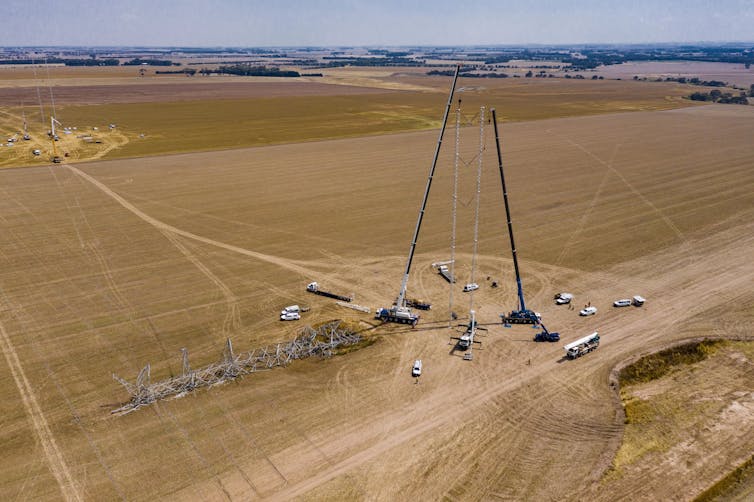
Where Would Superconductors Have Most Effect?
Queensland. The sunshine state is planning four new high-voltage transmission projects, to be built by the mid-2030s. The goal is to link clean energy production in the north of the state with the population centres of the south.
Right now, there are major congestion issues between southern and central Queensland. Strategically locating superconducting cables here would be the best location, serving to future-proof infrastructure, reduce emissions and avoid power loss. ![]()
Ian Mackinnon, Professor and Director, Centre for Clean Energy Technologies and Practices, Queensland University of Technology and Richard Taylor, Principal research fellow
This article is republished from The Conversation under a Creative Commons license. Read the original article.
Bacteria use life’s original energy source to thrive in the ocean’s lightless depths
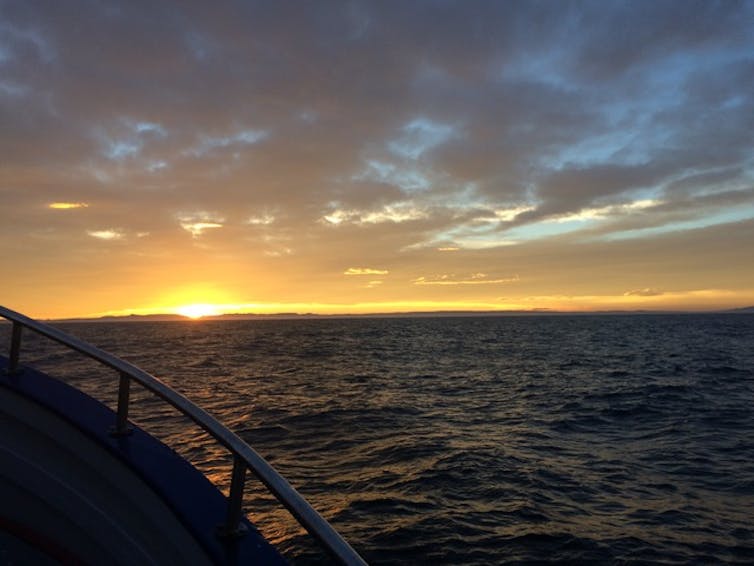
There are more than a billion bacteria in just one litre of seawater. How do all of these organisms find the energy and nutrients they need to survive?
In the nutrient-rich waters near the surface of the ocean, the primary energy source is sunlight, which drives photosynthesis, the transformation of light energy into chemical energy. In much of the open ocean, however, a lack of nutrients limits photosynthesis, and in the deep ocean it ceases altogether as there is no sunlight.
Despite this, microbes have found a way to live throughout the vast and dark ocean. How do they do it?
As we report in Nature Microbiology, many ocean bacteria in fact gain energy from two dissolved gases, hydrogen and carbon monoxide, in a process called chemosynthesis. This hidden but ancient process helps maintain the diversity and productivity of our oceans.
When The Lights Go Out, Chemosynthesis Prevails
We aimed to identify the preferred energy sources of microbes in the world’s oceans.
Humans and other animals depend on eating organic foods, while plants rely on photosynthesis. In contrast, microbes use a myriad of energy sources: solar, organic, and inorganic.
Many eat high-energy gases such as hydrogen and even carbon monoxide, which is poisonous to us. They do so by using special enzymes called hydrogenases and carbon monoxide dehydrogenases.
The world’s oceans contain quite a lot of dissolved hydrogen and carbon monoxide due to various biological and geological processes. Given this, we predicted these gases would be key energy sources for oceanic microbes.
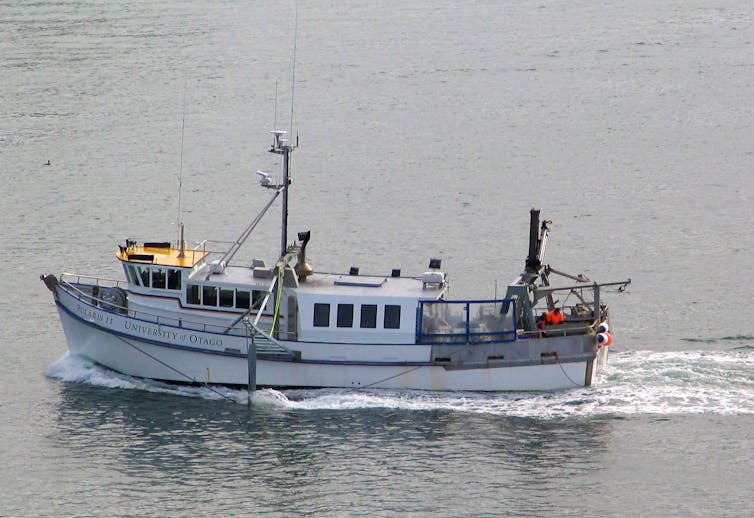
During our five-year study, we surveyed the capabilities and activities of the microbes present in the world’s oceans. We sampled seawater from diverse sites, spanning tropical islands to subantarctic waters. Public data from the global Tara Oceans study were also analysed.
Using a technique called metagenomic sequencing, we discovered the genetic blueprints of all the microbes in our ocean samples. We also took chemical measurements during the expeditions, analysed bacterial cultures, and used mathematical modelling to understand how the bacteria were getting their energy.
In all the samples we analysed, microbes were using enzymes to gain energy from hydrogen and carbon monoxide. As we expected, photosynthesis was the main source of energy in coastal surface waters – but gas-eating microbes grew more common further away from shore and in the deeper ocean.
In nutrient-poor waters, chemosynthesis may be the main strategy for obtaining energy.
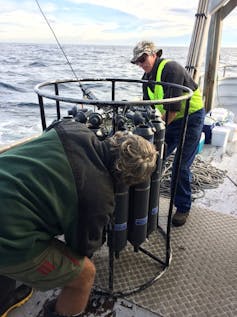
Eight distantly related groups, or phyla, of bacteria made the enzymes to use hydrogen and carbon monoxide. Clearly chemosynthesis is a far more widespread strategy in the oceans than previously thought!
Hydrogen and carbon monoxide aren’t the only chemical energy sources supporting ocean bacteria. Building on previous work by others, we found ammonia, sulfide and thiosulfate were also widely used.
Together, all these inorganic energy sources allow diverse microbes to prosper even in the darkest and most nutrient-poor regions of the ocean. As we have previously reported, chemosynthesis even allows a “microbial jungle” to form beneath the ice sheets of Antarctica.
An Ancient Trait That Remains Surprisingly Widespread Today
Chemosynthesis is less well known than photosynthesis, but it has much more ancient roots. Leading theories on the origin of life suggest hydrogen – produced in hydrothermal vents devoid of sunlight – was the first energy source for life. Photosynthesis likely evolved much later, providing the oxygen in the atmosphere that supports human life.
Some ecosystems still exist today that are primarily driven by chemosynthesis, most notably “black smokers”. Here, inorganic energy sources released from underwater volcanoes support complex microbially driven ecosystems, which include giant tube worms (you might have seen these on David Attenborough’s Blue Planet). But it’s conventionally thought that most ecosystems today are either directly or indirectly driven by photosynthesis.
Our findings suggest the situation is more complicated. By presenting the first report of hydrogen consumption in open oceans, we reveal unexpected similarities of marine microorganisms today to their ancient ancestors.
Chemosynthesis remains highly active today and provides a lifeline for oceanic microbes when photosynthesis is low.
The hydrogenases that modern marine bacteria use to consume hydrogen appear to be directly descended from the ancient catalysts that supported the first life. But through billions of years of evolution, they’ve adapted to the lower hydrogen and higher oxygen levels of today.

Interestingly, hydrogen and carbon monoxide appear to have distinct roles for ocean bacteria.
Hydrogen-consuming microbes grow using the slow, steady feed of energy provided by this gas. These bacteria are often ultrasmall and adapted to life with minimal energy, as reflected by our experiments with the polar bacterium Sphingopyxis alaskensis.
In contrast, carbon monoxide is primarily a “last resort” energy source for bacteria lacking light or organic carbon. It provides enough energy to survive until a better meal, but doesn’t allow for much growth. This agrees with previous work showing carbon monoxide dehydrogenase supports survival, but not growth, of various bacteria.
Bacterial Survival In A Changing World
Through our studies of the oceans and many other environments, it’s now clear that chemosynthesis is a universal process and microbes are actually quite flexible in their diets. Such insights improve our understanding of how ocean microbes survive, produce and consume nutrients, and adapt to their environment.
In turn, we are better able to predict how they may respond to a changing climate and other pressures. The deep ocean, often considered Earth’s “final frontier”, no doubt holds many other secrets big and small.![]()
Chris Greening, Professor, Microbiology, Monash University; Rachael Lappan, Group Leader and ARC DECRA Fellow, Monash University, and Zahra F. Islam, Postdoctoral research fellow, The University of Melbourne
This article is republished from The Conversation under a Creative Commons license. Read the original article.
Environment plan for England asks farmers to restore nature – but changes are likely to be superficial

The UK government’s environment improvement plan pledges to restore 500,000 hectares (1.2 million acres) of wildlife-rich habitat, create or expand 25 national parks, invest in the recovery of hedgehogs and red squirrels, tackle rising sewage pollution and improve access to green spaces in England over the next five years.
Since 69% of land in England is farmed, much of the plan’s success in improving nature will hinge on its reform of the country’s agricultural sector. Farming is implicated in the extinction risk of 86% of threatened species globally, and accounts for roughly one-third of all greenhouse gas emissions driving climate change, not to mention soil erosion and river pollution.
The government has described the plan as an “ambitious road map” to a cleaner, greener country. Some of the targets certainly are ambitious. For example, the plan aims to bring 40% of farmland soils into sustainable management by 2028.
This would be a monumental shift in how soil is cared for in England. Intensive agriculture has slashed the amount of carbon soils store by 60% and put 6 million hectares across England and Wales at risk of erosion or compaction, costing an estimated £1.2 billion a year.
But the plan doesn’t actually explain how sustainable management will be expanded. The only action proposed is to create a “baseline map” of soil health in England by 2028.
The plan also aims for 65%-80% of landowners and farmers to adopt nature-friendly farming by 2030. “Nature-friendly farming” is not defined, nor is it based on any internationally recognised principles, making it impossible to assess the government’s progress.
The plan only aims for this to be adopted on 10%-15% of farmers’ land too, which would amount to a mere 6%–12% of England’s farmland overall. Research shows that protecting small pockets of land won’t benefit biodiversity if the majority of farming in the surrounding landscape is ecologically destructive.
All Carrots, No Sticks
The main instrument the government has chosen to shake up agriculture is the Sustainable Farming Incentive (SFI) scheme. SFIs are payments to farmers based on actions which benefit the environment. For example, a farmer could receive up to £40 a hectare for their efforts to improve soils on arable fields.
An integrated strategy for converting farmland to more sustainable management would mean increasing the diversity of crops grown, helping healthy soils regenerate and eliminating pesticides, all at the same time. Instead, SFI payments reward farmers for making standalone changes.
This might mean putting out seeds for birds in winter or leaving a grassy strip on an unused section of land to provide habitat for insects, though it could also mean significantly cutting down on pesticides. This system offers flexibility for landowners, but research shows that farmers are more likely to choose environmental improvements which don’t require significant changes to how they farm.
This is the fatal flaw in the government’s flagship farming reform. Farmers can continue doing things which harm soils and wildlife on the (majority) productive parts of their land while receiving benefits for sprinkling pro-environment measures around the edges.
Wildflower margins which are planted around pesticide-soaked crops under the pretence of supporting pollinators offer a common example. Not only is the continued use of pesticide on the crop harmful in itself, the wildflowers actually accumulate the chemical residue, sometimes in higher concentrations than in the crops themselves. This renders the wildflower pollen harmful, rather than beneficial, to bees, butterflies and other bugs.

The environment improvement plan heavily relies on voluntary participation in lieu of regulation, not only through SFIs but quality assurance schemes such as Red Tractor. For example, fertilisers and slurries (semi-liquid manures) emit ammonia, a greenhouse gas which is bad for human health. Rather than regulate this, the plan favours an “industry led” approach with Red Tractor certifications.
Red Tractor is yet another voluntary scheme, and has been criticised as ineffectual for encouraging improvements to the environment and animal welfare on farms. The plan has only suggested that it will consider regulating dairy and intensive beef farms in the same way that it regulates intensive poultry and pig farms.
Even if regulations were to be expanded, environmental regulators visit farms so rarely and superficially that it might not make a difference. On average, it is estimated that English farms can expect an environmental inspection once every 263 years. Despite being regulated, intensive poultry and pig operations are a major cause of river pollution.
Beyond England’s Borders
In post-Brexit policy discussions, some landowners and consumers worried that payments for environmental improvements would outweigh income from food production, meaning less homegrown fare. Government discourse has since emphasised that farmers will receive support to deliver on environmental outcomes “alongside” food production. Nothing in the plan ensures this.
Other countries have a food policy which guides farmers to grow produce necessary for healthy diets and determines how much should be imported or exported. Responsibility for food in England is divided between 16 different departments, with no overarching framework or body.
SFIs and the new plan do very little to stem the environmental consequences of food produced beyond England’s borders. The aggregate ammonia emissions from crops and livestock imported into England are significantly higher than those stemming from domestic production.
And despite its favourable growing conditions, the majority of fruit and vegetables eaten in England are imported, contributing to water scarcity and pollution in other countries. Preserving the environment at home while polluting and degrading environments abroad is nonsensical, as all ecosystems are interconnected. But it is also shameful to shift the environmental burden of English diets onto other people.
If the government and citizens are serious about improving the environment, then policies must require that ecological principles are integrated into food production. At present, voluntary measures and weak regulation are all that is offered.

Don’t have time to read about climate change as much as you’d like?
Get a weekly roundup in your inbox instead. Every Wednesday, The Conversation’s environment editor writes Imagine, a short email that goes a little deeper into just one climate issue. Join the 10,000+ readers who’ve subscribed so far.![]()
Elise Wach, Research Advisor, Institute of Development Studies
This article is republished from The Conversation under a Creative Commons license. Read the original article.
Loopholes wide enough to ‘drive a diesel truck through’ – how to tell if a business is really net zero
Ian Thomson, University of BirminghamThe science is clear: greenhouse gas (GHG) emissions must peak before 2025 to prevent planetary warming exceeding 1.5℃. The solution is simple: stop doing and investing in things that emit GHGs and instead protect the natural systems that remove them from the atmosphere.
Disclosure of a company’s emissions should then let consumers and investors make informed decisions. But businesses are rarely required to disclose all of the emissions generated in their full “lifecycle”.
For example, the UK’s Cumbria coal mine, which was approved in December, will produce 2.8 million tonnes of coking coal each year for the steelmaking industry without accounting for the emissions produced when this coal is burned. These emissions instead represent the responsibility of the steel industry.
The Cumbria coal mine has made no claims regarding net zero. But other fossil fuel companies have used this reporting ambiguity to claim they are on target to becoming net zero despite the use of their products being responsible for almost three-quarters of global GHG emissions. Consumers or investors will then probably make decisions that result in emissions being generated at unsustainable levels. Since joining the United Nations (UN) Net Zero Banking Alliance, 56 banks have provided US$270 billion (£221 billion) worth of finance to fossil fuel companies.
But the actions of the UK government and several large businesses offer promise. The government now requires firms competing for major government contracts to report their full lifecycle emissions.
Understanding This Absurdity
An organisation’s climate impact can be made immediately clear by separating their GHG emissions into four groups or scopes.
Scope 1 refers to GHG emissions generated directly by business activities up to point of sale. Scope 2 refers to the emissions related to the generation of the energy purchased by a business. The emissions generated in the production and delivery of a business’s resources are called scope 3 upstream, and scope 3 downstream accounts for all emissions after a product or service has been sold.
Current guidance only requires a business, like the operator of the Cumbrian coke mine, to report their scope 1 and 2 emissions. Yet a report conducted in 2020 by global management consultant McKinsey found that these emissions only account for between 14% and 25% of the coal sector’s total emissions. The majority of the GHG emissions associated with coal mining are therefore not disclosed.

Calculating Scope 3 Emissions
But these emissions are essential for determining the carbon footprint of an organisation and are relatively straight forward to calculate.
The UN has published a standard called the Greenhouse Gas Protocol that details how to calculate scope 3 emissions. And most of the goods, services, materials and equipment used by businesses have readily available GHG conversion factors.
These factors allow us to convert activities like driving into their associated GHG emissions. The GHG conversion factor for driving the average car for a kilometre is 0.171 kg of CO₂e. By driving a car 100 km, we would emit 171 kg of CO₂e.
In the case of burning coking coal, we can rely on the laws of physics and chemistry. Burning coal involves a combustion process where the carbon in the coal reacts with oxygen to produce CO₂. Using the government’s GHG conversion factors, we know that burning a tonne of coking coal produces 3.14 tonnes of CO₂, regardless of what you use it for or where it is used.
By multiplying this conversion factor by the total amount of coking coal extracted from the Cumbria plant (2.8 million tonnes), we obtain a reliable measure of the emissions generated by burning the plant’s coal – 8.8 million tonnes of CO₂. Roughly the same amount of emissions would be produced by driving a car 1.3 million times around the Earth. These are scope 3 emissions that are largely ignored when determining whether a coal mine is net zero.
Applying This In Practise
Companies are best placed to estimate the future GHG emissions that arise from the use of their products. Car manufacturers, for example, have the data necessary to predict the future emissions generated by their vehicles. They know the expected lifetime mileage of their models sold and the fuel type that their vehicles use.
Some organisations already calculate their scope 3 emissions and provide this information willingly. Microsoft have a tool that measures the GHG emissions of your cloud software that runs off the internet usage and estimates the emissions avoided by using the cloud. And global chemical producer BASF publish publicly available information on the GHG emissions associated with their products along their full lifecycle.
This should allow consumers and investors to make more informed decisions.
The future emissions of other activities, such as land use change, are more difficult to measure. Yet from 2010 to 2019, deforestation is estimated to have caused between 5.9 and 9.5% of total GHG emissions. Initiatives like the UN Land Sector and Removals Guidance, which is set for publication in 2023, will produce GHG conversion factors for land use change and will enable a more accurate evaluation of the climate impact of these activities.
At the latest UN climate change summit (COP27), Secretary-General António Guterres criticised the current criteria for net zero commitments for having loopholes wide enough to “drive a diesel truck through”. Measuring scope 3 emissions is crucial to accurately assess how far an organisation is progressing towards net zero. To prevent climate breakdown, more businesses must be required to disclose what many of them already know.

Don’t have time to read about climate change as much as you’d like?
Get a weekly roundup in your inbox instead. Every Wednesday, The Conversation’s environment editor writes Imagine, a short email that goes a little deeper into just one climate issue. Join the 10,000+ readers who’ve subscribed so far.![]()
Ian Thomson, Director of the Centre for Responsible Business, University of Birmingham
This article is republished from The Conversation under a Creative Commons license. Read the original article.
Pittwater Reserves: Histories + Notes + Pictorial Walks
A History Of The Campaign For Preservation Of The Warriewood Escarpment by David Palmer OAM and Angus Gordon OAM
A Walk Around The Cromer Side Of Narrabeen Lake by Joe Mills
America Bay Track Walk - photos by Joe Mills
An Aquatic June: North Narrabeen - Turimetta - Collaroy photos by Joe Mills
Angophora Reserve Angophora Reserve Flowers Grand Old Tree Of Angophora Reserve Falls Back To The Earth - History page
Annie Wyatt Reserve - A Pictorial
Avalon's Village Green: Avalon Park Becomes Dunbar Park - Some History + Toongari Reserve and Catalpa Reserve
Bairne Walking Track Ku-Ring-Gai Chase NP by Kevin Murray
Bangalley Headland Bangalley Mid Winter
Banksias of Pittwater
Barrenjoey Boathouse In Governor Phillip Park Part Of Our Community For 75 Years: Photos From The Collection Of Russell Walton, Son Of Victor Walton
Barrenjoey Headland: Spring flowers
Barrenjoey Headland after fire
Bayview Baths
Bayview Wetlands
Beeby Park
Bilgola Beach
Botham Beach by Barbara Davies
Bungan Beach Bush Care
Careel Bay Saltmarsh plants
Careel Bay Birds
Careel Bay Clean Up day
Careel Bay Playing Fields History and Current
Careel Creek
Careel Creek - If you rebuild it they will come
Centre trail in Ku-ring-gai Chase National Park
Chiltern Track- Ingleside by Marita Macrae
Clareville Beach
Clareville/Long Beach Reserve + some History
Coastal Stability Series: Cabbage Tree Bay To Barrenjoey To Observation Point by John Illingsworth, Pittwater Pathways, and Dr. Peter Mitchell OAM
Cowan Track by Kevin Murray
Curl Curl To Freshwater Walk: October 2021 by Kevin Murray and Joe Mills
Currawong and Palm Beach Views - Winter 2018
Currawong-Mackerel-The Basin A Stroll In Early November 2021 - photos by Selena Griffith
Currawong State Park Currawong Beach + Currawong Creek
Deep Creek To Warriewood Walk photos by Joe Mills
Drone Gives A New View On Coastal Stability; Bungan: Bungan Headland To Newport Beach + Bilgola: North Newport Beach To Avalon + Bangalley: Avalon Headland To Palm Beach
Duck Holes: McCarrs Creek by Joe Mills
Dunbar Park - Some History + Toongari Reserve and Catalpa Reserve
Dundundra Falls Reserve: August 2020 photos by Selena Griffith - Listed in 1935
Elsie Track, Scotland Island
Elvina Track in Late Winter 2019 by Penny Gleen
Elvina Bay Walking Track: Spring 2020 photos by Joe Mills
Elvina Bay-Lovett Bay Loop Spring 2020 by Kevin Murray and Joe Mills
Fern Creek - Ingleside Escarpment To Warriewood Walk + Some History photos by Joe Mills
Iluka Park, Woorak Park, Pittwater Park, Sand Point Reserve, Snapperman Beach Reserve - Palm Beach: Some History
Ingleside
Ingleside Wildflowers August 2013
Irrawong - Ingleside Escarpment Trail Walk Spring 2020 photos by Joe Mills
Irrawong - Mullet Creek Restoration
Katandra Bushland Sanctuary - Ingleside
Lucinda Park, Palm Beach: Some History + 2022 Pictures
McCarrs Creek
McCarr's Creek to Church Point to Bayview Waterfront Path
McKay Reserve
Mona Vale Beach - A Stroll Along, Spring 2021 by Kevin Murray
Mona Vale Headland, Basin and Beach Restoration
Mount Murray Anderson Walking Track by Kevin Murray and Joe Mills
Mullet Creek
Narrabeen Creek
Narrabeen Lagoon Catchment: Past Notes Present Photos by Margaret Woods
Narrabeen Lagoon State Park
Narrabeen Lagoon State Park Expansion
Narrabeen Rockshelf Aquatic Reserve
Nerang Track, Terrey Hills by Bea Pierce
Newport Bushlink - the Crown of the Hill Linked Reserves
Newport Community Garden - Woolcott Reserve
Newport to Bilgola Bushlink 'From The Crown To The Sea' Paths: Founded In 1956 - A Tip and Quarry Becomes Green Space For People and Wildlife
Pittwater Reserves: The Green Ways; Bungan Beach and Bungan Head Reserves: A Headland Garden
Pittwater Reserves, The Green Ways: Clareville Wharf and Taylor's Point Jetty
Pittwater Reserves: The Green Ways; Hordern, Wilshire Parks, McKay Reserve: From Beach to Estuary
Pittwater Reserves - The Green Ways: Mona Vale's Village Greens a Map of the Historic Crown Lands Ethos Realised in The Village, Kitchener and Beeby Parks
Pittwater Reserves: The Green Ways Bilgola Beach - The Cabbage Tree Gardens and Camping Grounds - Includes Bilgola - The Story Of A Politician, A Pilot and An Epicure by Tony Dawson and Anne Spencer
Pittwater spring: waterbirds return to Wetlands
Pittwater's Lone Rangers - 120 Years of Ku-Ring-Gai Chase and the Men of Flowers Inspired by Eccleston Du Faur
Pittwater's Parallel Estuary - The Cowan 'Creek
Resolute Track at West Head by Kevin Murray
Resolute Track Stroll by Joe Mills
Riddle Reserve, Bayview
Salvation Loop Trail, Ku-Ring-Gai Chase National Park- Spring 2020 - by Selena Griffith
Seagull Pair At Turimetta Beach: Spring Is In The Air!
Stapleton Reserve
Stapleton Park Reserve In Spring 2020: An Urban Ark Of Plants Found Nowhere Else
Stony Range Regional Botanical Garden: Some History On How A Reserve Became An Australian Plant Park
The Chiltern Track
The Resolute Beach Loop Track At West Head In Ku-Ring-Gai Chase National Park by Kevin Murray
Topham Track Ku-Ring-Gai Chase NP, August 2022 by Joe Mills and Kevin Murray
Towlers Bay Walking Track by Joe Mills
Trafalgar Square, Newport: A 'Commons' Park Dedicated By Private Landholders - The Green Heart Of This Community
Tranquil Turimetta Beach, April 2022 by Joe Mills
Turimetta Beach Reserve by Joe Mills, Bea Pierce and Lesley
Turimetta Beach Reserve: Old & New Images (by Kevin Murray) + Some History
Turimetta Headland
Warriewood Wetlands and Irrawong Reserve
Whale Beach Ocean Reserve: 'The Strand' - Some History On Another Great Protected Pittwater Reserve
Wilshire Park Palm Beach: Some History + Photos From May 2022
Winji Jimmi - Water Maze

New Shorebirds WingThing For Youngsters Available To Download
A Shorebirds WingThing educational brochure for kids (A5) helps children learn about shorebirds, their life and journey. The 2021 revised brochure version was published in February 2021 and is available now. You can download a file copy here.
If you would like a free print copy of this brochure, please send a self-addressed envelope with A$1.10 postage (or larger if you would like it unfolded) affixed to: BirdLife Australia, Shorebird WingThing Request, 2-05Shorebird WingThing/60 Leicester St, Carlton VIC 3053.

 Shorebird Identification Booklet
Shorebird Identification Booklet
The Migratory Shorebird Program has just released the third edition of its hugely popular Shorebird Identification Booklet. The team has thoroughly revised and updated this pocket-sized companion for all shorebird counters and interested birders, with lots of useful information on our most common shorebirds, key identification features, sighting distribution maps and short articles on some of BirdLife’s shorebird activities.
The booklet can be downloaded here in PDF file format: http://www.birdlife.org.au/documents/Shorebird_ID_Booklet_V3.pdf
Paper copies can be ordered as well, see http://www.birdlife.org.au/projects/shorebirds-2020/counter-resources for details.
Download BirdLife Australia's children’s education kit to help them learn more about our wading birdlife
Shorebirds are a group of wading birds that can be found feeding on swamps, tidal mudflats, estuaries, beaches and open country. For many people, shorebirds are just those brown birds feeding a long way out on the mud but they are actually a remarkably diverse collection of birds including stilts, sandpipers, snipe, curlews, godwits, plovers and oystercatchers. Each species is superbly adapted to suit its preferred habitat. The Red-necked Stint is as small as a sparrow, with relatively short legs and bill that it pecks food from the surface of the mud with, whereas the Eastern Curlew is over two feet long with a exceptionally long legs and a massively curved beak that it thrusts deep down into the mud to pull out crabs, worms and other creatures hidden below the surface.
Some shorebirds are fairly drab in plumage, especially when they are visiting Australia in their non-breeding season, but when they migrate to their Arctic nesting grounds, they develop a vibrant flush of bright colours to attract a mate. We have 37 types of shorebirds that annually migrate to Australia on some of the most lengthy and arduous journeys in the animal kingdom, but there are also 18 shorebirds that call Australia home all year round.
What all our shorebirds have in common—be they large or small, seasoned traveller or homebody, brightly coloured or in muted tones—is that each species needs adequate safe areas where they can successfully feed and breed.
The National Shorebird Monitoring Program is managed and supported by BirdLife Australia.
This project is supported by Glenelg Hopkins Catchment Management Authority and Hunter Local Land Services through funding from the Australian Government’s National Landcare Program. Funding from Helen Macpherson Smith Trust and Port Phillip Bay Fund is acknowledged.
The National Shorebird Monitoring Program is made possible with the help of over 1,600 volunteers working in coastal and inland habitats all over Australia.
The National Shorebird Monitoring program (started as the Shorebirds 2020 project initiated to re-invigorate monitoring around Australia) is raising awareness of how incredible shorebirds are, and actively engaging the community to participate in gathering information needed to conserve shorebirds.
In the short term, the destruction of tidal ecosystems will need to be stopped, and our program is designed to strengthen the case for protecting these important habitats.
In the long term, there will be a need to mitigate against the likely effects of climate change on a species that travels across the entire range of latitudes where impacts are likely.
The identification and protection of critical areas for shorebirds will need to continue in order to guard against the potential threats associated with habitats in close proximity to nearly half the human population.
Here in Australia, the place where these birds grow up and spend most of their lives, continued monitoring is necessary to inform the best management practice to maintain shorebird populations.
BirdLife Australia believe that we can help secure a brighter future for these remarkable birds by educating stakeholders, gathering information on how and why shorebird populations are changing, and working to grow the community of people who care about shorebirds.
To find out more visit: http://www.birdlife.org.au/projects/shorebirds-2020/shorebirds-2020-program
Aussie Bread Tags Collection Points

All Adults Now Eligible For A 2023 COVID-19 Booster Dose
Is 13 too young to have a TikTok or Instagram account?

The surgeon general is the “nation’s doctor” in the United States. They are tasked with giving Americans the “best scientific information” about their health.
Late last month, the current US surgeon general, Vivek Murthy, warned 13 is too young to join social media. He said it poses a risk to young people’s “self-worth and their relationships”, adding:
I, personally, based on the data I’ve seen, believe that 13 is too early […] the skewed and often distorted environment of social media often does a disservice to many of those children.
Is 13 too young? What should parents think about when it comes to their kids and social media accounts?
Why Are We Talking About 13?
Major social media platforms, including Twitter, Instagram, Facebook and TikTok, require users to be at least 13. This includes those in Australia and New Zealand.
This minimum age requirement stems from 1998 US legislation which banned the collection of children’s personal data without parental consent.
For many parents, schools and cybersafety experts, this minimum age has become something of a benchmark. Many assume it comes with the implicit assurance social media platforms are appropriate and safe for children once they turn 13. Conversely, they also assume they are unsafe for children under 13.
But this is not necessarily the case.
What Does The Evidence Say?
Social media platforms do present some risks for young people. These include online bullying and harassment, exposure to misinformation and inappropriate content, grooming, privacy breaches and excessive use.
Stories documenting the potentially harmful effects of social media are rarely out of the news. Studies claim links between social media and poor mental health and low self-esteem.
These findings are concerning, and there is no doubt social media may negatively affect some young people’s wellbeing. However, it is not a straightforward question.
While these studies might find a correlation or link between excessive social media use and poor self-esteem, for example, they rarely point to direct causation. Young people already experiencing low self-esteem and depression may use social media significantly more than others.
So Why Don’t We Just Increase The Age?
Murthy acknowledges it is difficult to keep kids off their devices and social media. But he suggests parents band together,
and say you know, as a group, we’re not going to allow our kids to use social media until 16 or 17 or 18.
But any increase in the age - whether formal or informal – will not necessarily keep children safer online. Children can easily falsify their ages (many already do). And young people are good at finding creative and secretive ways of doing what they want regardless.
Why Can’t Parents Just Say No?
It is often suggested – by cyber safety experts – that parents just say no. This message has been reinforced by celebrity commentators such as British actress Kate Winslet, who recently told the BBC:
My children don’t have social media and haven’t had social media.
While these approaches may work with younger kids, older children are unlikely to simply comply. Blanket bans and restrictions not only lead to family conflict, but are also more likely to lead to children using social media without parental consent or knowledge.
This is a problem because parents play an important role in helping children navigate online spaces, including the sometimes fraught nature of peer relationships on social media.
If a child has a social media account without parental permission, they are much less likely to seek out their parents for help if they have a problem online, for fear of getting into trouble or having their device taken away.
Children Also Have A Right To Be Online
Discussion about risks also tends to ignore the potential benefits of being online.
Social media is incredibly important for many young people. It keeps them connected with friends and extended family, provides a platform for creativity and self-expression, and enables civic participation and activism.

Social media also provides access to like-minded individuals and communities who may provide solidarity and support, especially for marginalised teens.
Children, particularly teenagers, also have a right to participate in online spaces, including use of social media.
The United Nations’ Committee on the Rights of the Child notes children have the right to “meaningful access to digital technologies” as a way of realising the full range of their civil, political, cultural, economic and social rights.
So, When Should My Child Get A TikTok Account?
There is no one-size-fits-all approach here. Children vary tremendously in terms of their maturity, skills, life experience and judgement.
On top of this, online risk is not equally distributed, as children who are more vulnerable offline are more vulnerable online. For example, children with mental health problems, learning difficulties, a disability or who have problems at home are more likely to experience high-risk situations online.
In deciding whether your child is ready for a social media account, parents might consider:
Is my child especially vulnerable to online harms?
Does my child have the required maturity and resilience to manage potentially negative online social interactions?
Does my child listen to advice and follow rules?
Is my child aware of the risks, and do they have strategies for managing them?
Will my child come to me with any problems they encounter online?
Parents might also consider their children’s offline lives, as these often carry over into online spaces. This includes what their friendships are like, their propensity for taking risks, and their ability to consider the consequences of their actions.
Start Talking Early
The best thing that parents can do is initiate conversations about social media and the internet early and often.
Many issues that play out on social media are extensions of young people’s existing peer relationships. Parents can talk to their children about their friends and peers, show an interest in their child’s online activities, and openly discuss their child’s rights and responsibilities online.
Some parents may wish to set reasonable expectations and rules about appropriate use of social media. Documenting these expectations through a “family technology agreement” that is negotiated democratically as a family, rather than through top-down rules, is more likely to succeed .
Catherine Page Jeffery, Lecturer in media and communications, University of Sydney
This article is republished from The Conversation under a Creative Commons license. Read the original article.
Friday essay: love in the time of incontinence – why young people don’t have the monopoly on love, or even sex

A friend with a close relative in a residential aged care home reports – in a tone of scandalised surprise – on romantic entanglements among the elderly.
In one case, a man and woman have become so inseparable that staff have been forced to move his bed into her room so the two can sleep side by side. When the woman’s son made an unexpected visit, he was distressed to find his mother in her nightdress in the arms of a stranger, though eventually he had to accept it was what she wanted.
The concept of the elderly, with their age-altered bodies, demonstrating an appetite for intimacy, especially in an institutionalised setting, appears widely regarded as funny at best – and at worst, disgusting. But should we be surprised if in this difficult, final phase of their lives, elderly people yearn for human contact?
Love Is Short, Forgetting Is Long
As another friend, an experienced nurse, points out, the rooms of aged care residents are routinely lined with framed family photographs, what she calls “the people with the big hats and the scrolls”. But where, my friend demands, are these people in the lives of the lonely residents? Why do they never visit?
She describes how in her childhood in Ireland, any house you’d go to would have an old man or woman in it being cared for by the family; though she admits this may no longer be the case, since so many women have found work outside the home.
For Australians in aged care, living among strangers, removed from all that was once familiar – including the ordinary luxuries of an outing to a local cafe, or to watch the sun set over the sea – it is surely natural that they should turn to those nearest them for comfort. As the poet Pablo Neruda says: “Love is so short, forgetting is so long.”
Each February, the Day of Love rolls around, with its buckets of poor, forced roses outside florists’ shops, its gaudy greetings cards, and supermarkets crammed with chocolate. Young people, of course, are mad for all the hullabaloo, with Valentine’s Day themed parties, and singing telegrams delivered in the lunch breaks in high schools. But if those young people imagine they have a monopoly on love – or even on sex – the truth appears otherwise; in real life and in books.

Romance In Residential Care
For a moving narrative of love at the end of days, read Alice Munro’s The Bear Came Over the Mountain, from her book Hateship, Friendship, Courtship, Loveship, Marriage (filmed as Away From Her; director Sarah Polley was Oscar nominated for her screenplay adaptation of Munro’s story).
The story documents both romantic attachment in residential care, and the lengths a spouse might go to for love. Grant and Fiona have been married for almost 50 years when she starts leaving sticky notes on their kitchen drawers: Cutlery, Dishtowels, Knives. Grant is shaken by the realisation that it is not where things are kept that Fiona is struggling with, but what they are.
As Fiona’s memory loss accelerates, she moves voluntarily to Meadowlake, a nursing home where she and Grant have previously visited a neighbour. The home’s rules forbid visitors during the first month; Grant is told this is to help Fiona settle in. But when the month is up his wife does not recognise him, and at each visit he finds her sitting close beside her new friend, Aubrey.

Grant’s eventual acceptance of Fiona’s and Aubrey’s relationship, his efforts, after Aubrey’s wife takes him home, to have him returned to Meadowlake, is where the real love lies in this story. It is not the stuff of cellophane-wrapped roses and chocolate hearts, but the devotion that has accreted over the course of a long marriage. In Grant’s case devotion may be tinged with guilt, for in the past he has been a philanderer, though he never wanted to risk losing his wife. Now that he has lost her, he throws his effort into securing the only thing that appears to make her happy.
At the end of Elizabeth Strout’s Pulitzer prize-winning Olive Kitteridge, Olive seeks out the widowed Jack Kennison. She puts her hand on his chest and feels the thump of his heart “and her body – old, big, sagging – felt straight-out desire for his”. Olive is saddened to remember she had not loved her husband Henry in this way for a long time before he died.
What young people didn’t know, she thought, lying down beside this man, his hand on her shoulder, her arm; oh, what young people did not know. They did not know that lumpy, aged, and wrinkled bodies were as needy as their own young, firm ones, that love was not to be tossed away carelessly.
Privacy, Consent And Family Resistance
Intimate relationships have been associated with lower levels of stress and depression, with higher levels of oxytocin, a feel-good hormone, and a general lift in physical and mental wellbeing, even taking into account cognitive or physical impairment.
Intimacy, of course, does not necessarily mean sex; it can be expressed through touch, such as hugging, cuddling, or hand-holding. But in an Australian aged care setting, this may not be as straightforward as it seems in fiction. For one thing, there is a discouraging lack of privacy, including a scarcity of shared rooms, rooms with double beds and lockable doors. Then, if a resident’s husband or wife is still living in the wider community, a new attachment might stir family resistance.
A recent survey of almost 3,000 Australian residential aged-care facilities conducted by researchers at La Trobe University’s Australian Centre for Evidence Based Aged Care found that only half of facilities surveyed had written policies on sexuality, and only one third had policies on sexual behaviour.
Dementia raises the question of a capacity to properly consent. Legislation is clear concerning a resident’s will and medical and financial matters. But when it comes to people’s sexual decisions, it is left to staff to negotiate a balance between the rights of individuals and the facility’s duty of care to a group of people who are particularly vulnerable to unwanted attentions, or even sexual assault.
It must be acknowledged that in Australia an estimated 50 sexual assaults occur every week in residential aged care, and that the elderly also experience such assaults in their own homes; victims are invariably female. Police and care providers can be unwilling to take action, believing that dementia makes the victim’s evidence unreliable – and, mistakenly, that people with dementia will not remember, nor be traumatised.
The Ready to Listen project, launched in 2021 by the Older Persons Advocacy Network, aims to address the rights of people in aged care to be heard, to be believed, and (following open disclosure of assault) to have their cases followed up by police. It is also concerned with establishing a charter of sexual rights for older people, including their right to a consenting, romantic relationship, and clarifying the all-important question of consent.
But the possibility of non-consensual contact exacerbates the difficulty of forming genuine attachments, and family disapproval may be enough to cause staff to intervene. Even without this, the lack of guidance, or the ageist prejudices of staff members, may mean intimate friendships within an aged care setting will be firmly discouraged.
Children, especially adult children, can complicate mature love, and are often unscrupulous in thwarting it. Because aside from what they perceive as age-appropriate behaviour, late-life attachments can, of course, have consequences for an offspring’s anticipated inheritance.
‘You’re Not Even Ashamed’
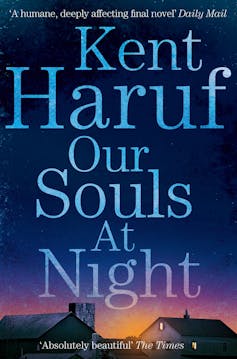
In Kent Haruf’s Our Souls at Night, Addie Moore and Louis Waters, neighbours for years, both live alone; their houses empty of family, their evenings solitary. Then Addie visits Louis with the astonishing proposal that he sleep over with her at night: for the company, for the quiet conversations after lights out. Louis agrees, and they fall into a companionable routine. The town soon notices this new intimacy, but at 70, Addie does not care what anyone thinks, and nor does Louis.
Alerted by a friend to her father’s behaviour, Louis’s daughter Holly tells him, “It just seems embarrassing”. But Addie’s son Gene is incensed. “Because he’s after your money too, isn’t he?” he says. “If you married him he’d get half of everything wouldn’t he? I couldn’t stop him.”
Addie’s six-year-old grandson Jamie is sent to stay with her when Gene separates from his wife. Frightened at night, Jamie ends up sleeping in Addie’s bed, making her arrangement with Louis impossible. But gradually the three of them bond, and when Louis gives Jamie a dog, Bonny, Bonny is allowed to sleep on Jamie’s bed. When the three of them go camping, they share the same tent.
Gene comes and takes Jamie and Bonny away, and afterwards Addie and Louis decide they will do what the town believes they’ve been doing all along.
Addie says, “This old body. I’m an old woman now.” Louis says, “Well, old woman Moore. You’ve won me completely. You’re just right. You’re how you’re supposed to look.”
When their lovemaking is not a success, Louis says, “I’ve got the old man’s complaint.” Addie says, “It’s just the first time. We have all the time ahead of us […] Let’s try again another night.” But Addie’s son returns. “I want this to stop,” he says. “You’re not even ashamed of yourselves.”
Gene bans Addie from speaking on the phone to her grandson. When she does get through to Jamie, he tells her that if he talks to her “they’ll take Bonny away”. Addie must have contact with the boy; she cannot afford to wait until Jamie is 16. She tells Louis they must remain separate.
When Addie falls in the street, Gene has her transferred from the town of Holt, where she and Louis live, to Denver. Louis goes to the hospital, where Gene tells him, “You’re not wanted here.”
When Addie is discharged, she will move into assisted living in another town. Gene’s disgust, while partly motivated by financial need, is also an expression of a common distaste for age-altered bodies. To Gene, this is all the justification he needs to use his small son as a weapon.
Love After ‘50 Years Of Being Parched’
Addie Moore is not the first elderly woman to discover that the last great love of her life is settled on a grandchild. The unconditional love can flow both ways, to their mutual joy, if it is not pinched out by parents with a loveless attitude towards the older generation. In her surrealist novel The Hearing Trumpet, Leonora Carrington delivers this dehumanising impulse with devastating economy as a woman speaks to her husband about his aged mother, Marian.
“Remember, Galahad,” added Muriel, “those old people do not have feelings like you or I. She would be so much happier in an institution.” Unfortunately for Marian, her adult grandson is not the loving kind. “She ought to be dead,” Robert said. “At that age people are better off dead.”
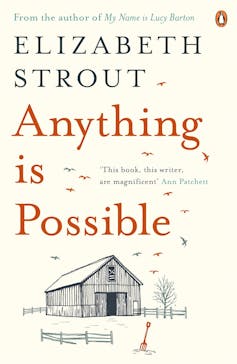
Even when offspring are not primarily focused on their inheritance, a lifetime’s accumulation of feelings and resentments can be in play. In Anything is Possible, also by Elizabeth Strout, the story Mississippi Mary tells of a 78-year-old woman living in Italy, married to a man so much younger than her that at first the locals assumed she was his mother.
When her youngest daughter visits, Mary thinks she will not understand “what it had been like to be so famished. Almost fifty years of being parched”. At their 50th wedding anniversary party her husband had not asked her to dance. Later, when Mary was 69, her daughters had given her a trip to Italy as a birthday gift, and it was there that she had wandered off and become lost, and was found by Paolo.
She fell in love. She did. He’d been married for twenty years, it had seemed like fifty to him, and now he was alone – they were both parched.
Mary’s first husband had been in a long-term affair. Their daughter Angelina judges it “pathetic […] painful, of course, but pathetic”. Her father “really was a mean snake of a man” Angelina admits, but then the selfishness of the hurt child kicks in:
Why couldn’t her mother see what she had done by leaving? Why couldn’t she see it? There could be only one reason: that her mother was, behind her daffiness, a little bit dumb; she lacked imagination.
Angelina accuses her mother of having taken from her the ability to care for her in her old age, and to be with her when she dies. Mary is a little stricken by this, because she suspects death is not far away. But “she did not dread her death […] she was almost ready for it, not really but getting there”. Mary admits that
Always, there was that grasping for a few more years, Mary had seen this with many people, and she did not feel it – or she did, but she did not. No. She felt tired out, she felt almost ready, and she could not tell her child this.
Sexy Old Women
In her essay, Sexy Old Women, Krissy Kneen has just finished writing a novel that would go on to be shortlisted for the Stella Prize, An Uncertain Grace, in which the main character, Liv, reaches 130 years of age and is still very much a sexual being. Kneen writes:
The older I get the more I see that the signifiers of sex are inextricably linked to youth. We say young, sexy bodies. We say sexy young things. We do not say sexy old woman.
In the work of writers such as Gabriel Garcia Marquez, Philip Roth, Yasunari Kawabata, Michel Houellebecq, Peter Carey, and Vladimir Nabokov, Kneen easily finds literary examples of sexual old men. But it is harder to find a model for a sexual older woman, and in the few examples she does find – In Praise of the Stepmother, by Mario Vargas Llosa, and The Graduate by Charles Webb (the basis for the 1967 film starring Dustin Hoffman) – the women are portrayed as “dangerous, manipulating, clever enough to cause a man’s downfall”.

Kneen recalls watching the screening of a documentary, Nitrate Kisses, in which a sex scene involving two very old women draws a shocked response from the young audience. Describing the scene as “caring and quite frankly, beautiful” Kneen, though at the time still young herself, hopes that as an old woman she will still be “equally sexually bold”.
Ripe Glamour
Septuagenarian American novelist and poet May Sarton famously developed the optimistic concept of “ripening towards death in a fruitful way”. But ripeness as it relates to the elderly, especially elderly women, can be a fraught topic. Some pro-ageing advocates insist that an essential element of a woman ageing well is glamour, but glamour is a construct; in our times it is often measured by the subject’s perceived sexual appeal, as demonstrated by the clichéd poses and facial expressions of those modelling “glamour” in magazines, or on screens.
The pro-ageing movement on Instagram is divided between older women who still lay claim to the glamorous props of their youth – skin-baring garments, high heels, extravagant quantities of makeup – and those who are evolving towards a kind of beauty that does not rely on overt sexuality, but focuses instead on being comfortable in one’s own skin. Neither approach is right or wrong, but of the two ways of going forward, the “less is more” philosophy of the natural agers somehow seems more universally doable.

The roots of the word “glamour” can be traced to the Scottish word gramarye, meaning “magic, enchantment, spell”, including the lovely phrase “to cast the glamour”. Gramarye may be from an Ancient Greek word for the weight unit of ingredients used in magic potions. Or it is an alteration of the English word “grammar”, in its medieval sense of “scholarship” and especially “occult learning”?
In John Jamieson’s 1825 Etymological Dictionary of the Scottish Language, glamer, glamour, is
the supposed influence of a charm on the eye, causing it to see objects differently from what they really are. Hence to “cast glamer o’er one, to cause deception of sight”.
This definition draws glamour closer to the Old Norse words glámr, “moon”, or “name of a ghost”, and glámsýni, “illusion” – which makes of glamour a deception, a beauty trick.
Jamieson’s dictionary contains many old words that women might use to describe themselves in ways that stand outside the conventions formed around youthful beauty.
For those of us anticipating our own extreme old age, when we will be more frooch (“frail, brittle”) than now, let us hope we shall still be able to summon the odd moment of gleit (“to glitter”), and that our eyes, our hair, will be touched at times with their old glister (“lustre”).
And looking back over the fiction I’ve drawn on for this essay, I see the writers were both forsy (“powerful”) and formois (“beautiful”).
The Right To Relationships
The Royal Commission into Aged Care Quality and Safety was announced by the Morrison government in 2018, following a string of disturbing incidents – including South Australia’s Oakden Aged Care scandal, where the facility was closed after evidence came to light of neglect and abuse. Among the findings of the Royal Commission were that “sub-standard care and abuse pervades the Australian aged care system”. In its final report, it pronounced this “a source of national shame”.
Reforms suggested by the Royal Commission in any overhaul of Australia’s aged care system include the right of autonomy, the right to the presumption of legal capacity, and in particular the right of elders in residential aged care to make decisions about their care and the quality of their lives, and the right to social participation.
The recommendations state that older people should be supported to exercise choice about their own lives and make decisions to the fullest extent possible, including being able to take risks and be involved in the planning and delivery of their care. They also state that older people are entitled to receive support that acknowledges the aged care setting is their home, and enables them to live in security, safety and comfort, with their privacy respected.
For those of us who are not yet quite ready to access these late-life services, let us hope the Albanese government follows through on the Royal Commission’s recommendations, which state that people should be treated as individuals. And that the relationships older people have with significant others in their lives should be acknowledged, respected, and fostered.![]()
Carol Lefevre, Visiting Research Fellow, Department of English and Creative Writing, University of Adelaide
This article is republished from The Conversation under a Creative Commons license. Read the original article.
Express Yourself 2023
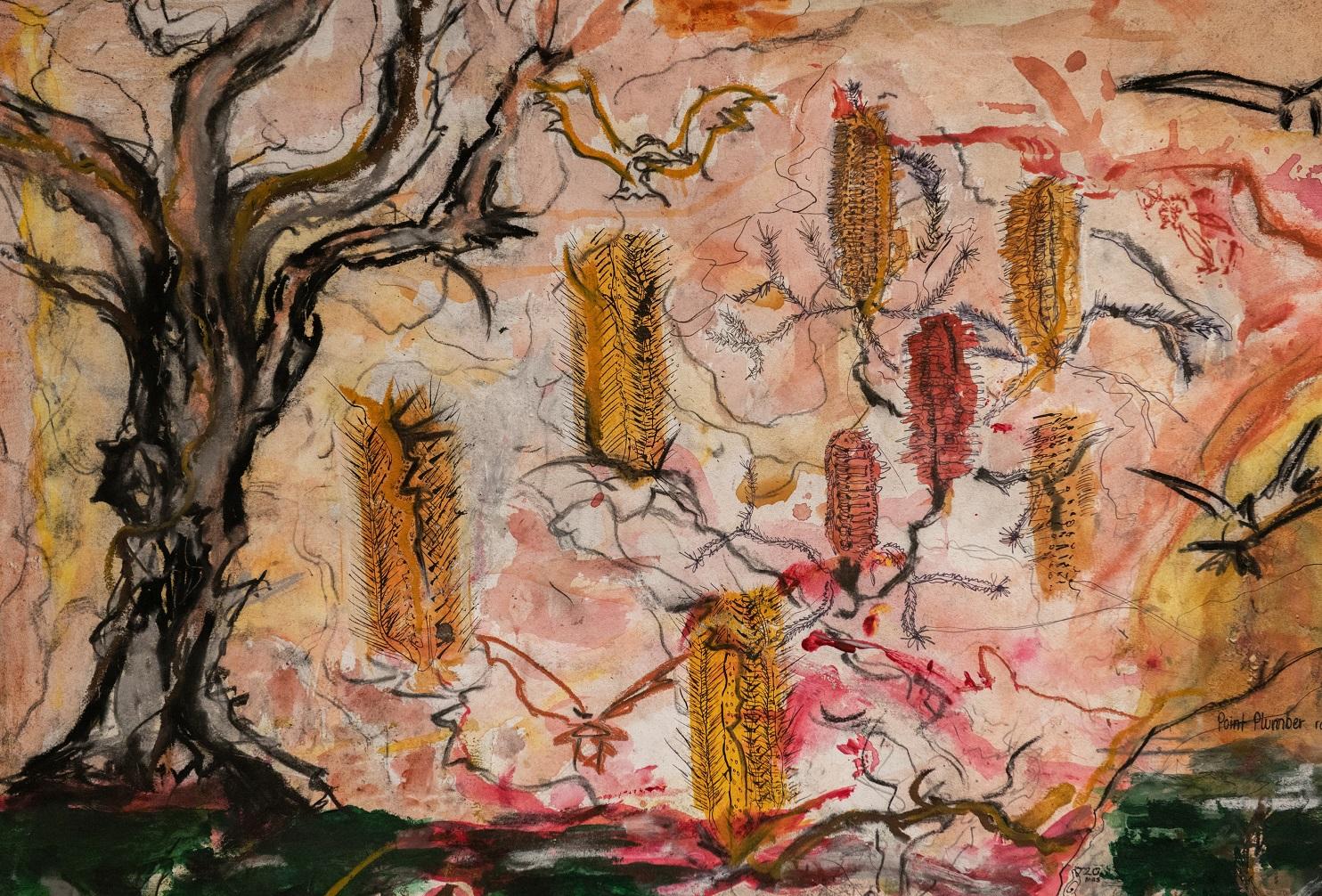
NSW Sports High Schools Partner With Australian Olympic Committee
- Athletics
- Baseball/Softball
- Basketball
- Football
- Golf
- Gymnastics
- Hockey
- Rugby Union
- Surfing
- Swimming
- Tennis
- Water Polo
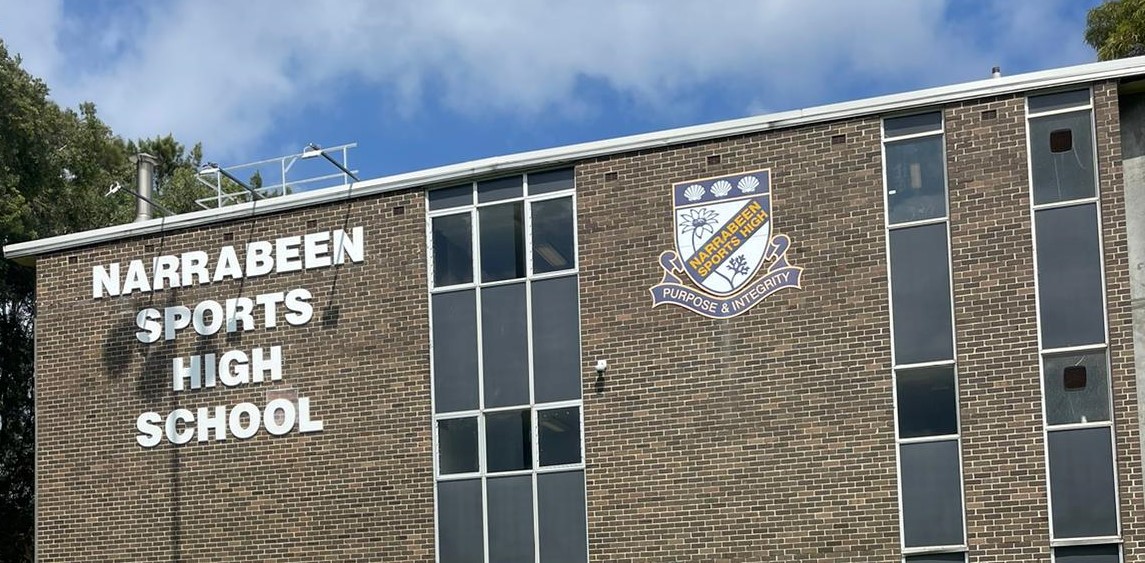
Surfing Is Sydney's Favourite Summer Pastime: Manly In 1959
Made by the National Film Board 1959. Directed by Jack S Allan. A typical 1950s weekend at Manly Beach, swimming, surfing, sun baking and life savers.
Council Seeks Community Members For LGBTQIA+ Working Group
Northern Composure Band Competition 2023
Due to the pandemic, Council have had the 20th anniversary on hold but pleased to say that the competition is open and running again.
Northern Composure is the largest and longest-running youth band competition in the area and offers musicians local exposure as well as invaluable stage experience. Bands compete in heats, semi finals and the grand final for a total prize pool of over $15,000.
Over the past 20 years we have had many success stories and now is your chance to join bands such as:
- Ocean Alley
- Lime Cordiale
- Dear Seattle
- What So Not
- The Rions
- Winston Surfshirt
- Crocodylus
And even a Triple J announcer plus a wide range of industry professionals
About the Competition
In 2023, the comp looks a little different.
All bands are invited to enter our heats which will be exclusively run online and voted on by your peers and community by registering below and uploading a video of one song of your choice. (if you are doing a cover, please make sure to credit the original band) We are counting on you to spread the word and get your friends, family, teachers voting for you!
The top 8-12 bands will move on through to our live semi finals with a winner from each moving on to the grand final held during National Youth Week. Not only that but we have raised the age range from 19 to 21 for all those musicians who may have missed out over the past two years.
Key dates
- Voting open for heats: Mon 13 Feb – Sun 26 Feb
- Band Briefing: Mon 6 March, Dee Why PCYC
- Semi 1: Sat 18 March Mona Vale Memorial Hall
- Semi 2: Sat 25 March, YOYOs, Frenchs Forest
- Grand Final: Fri 28 April, Dee Why PCYC
For more information contact Youth Development at youth@northernbeaches.nsw.gov.au or call 8495 5104
Stay in the loop and follow Northern Composure Unplugged on KALOF Facebook.
School Leavers Support
- Download or explore the SLIK here to help guide Your Career.
- School Leavers Information Kit (PDF 5.2MB).
- School Leavers Information Kit (DOCX 0.9MB).
- The SLIK has also been translated into additional languages.
- Download our information booklets if you are rural, regional and remote, Aboriginal or Torres Strait Islander, or living with disability.
- Support for Regional, Rural and Remote School Leavers (PDF 2MB).
- Support for Regional, Rural and Remote School Leavers (DOCX 0.9MB).
- Support for Aboriginal and/or Torres Strait Islander School Leavers (PDF 2MB).
- Support for Aboriginal and/or Torres Strait Islander School Leavers (DOCX 1.1MB).
- Support for School Leavers with Disability (PDF 2MB).
- Support for School Leavers with Disability (DOCX 0.9MB).
- Download the Parents and Guardian’s Guide for School Leavers, which summarises the resources and information available to help you explore all the education, training, and work options available to your young person.
School Leavers Information Service
- navigate the School Leavers Information Kit (SLIK),
- access and use the Your Career website and tools; and
- find relevant support services if needed.
Word Of The Week: Consternation
noun
1. amazement or dismay that hinders or throws into confusion. 2. amazement combined with terror.
The first known use of consternation was in 1604. From French or Latin; French, from Latin consternation-, consternatio, from consternare to throw into confusion, from com- + -sternare, probably from sternere to spread, strike down, from Latin consternationem (nominative consternatio) "confusion, dismay," noun of state from past-participle stem of consternare "overcome, confuse, dismay, perplex, terrify, alarm," which is probably related to consternere "throw down, prostrate," from assimilated form of com-, here perhaps an intensive prefix (see com-), + sternere "to spread out, lay down, stretch out"
verb: consternate; 3rd person present: consternates; past tense: consternated; past participle: consternated; gerund or present participle: consternating - to fill (someone) with anxiety.
A slightly 'confused' but more likely 'random mix' for your listening pleasure this week:
Camp Cope leaves the Australian music industry forever changed by their fearless feminist activism
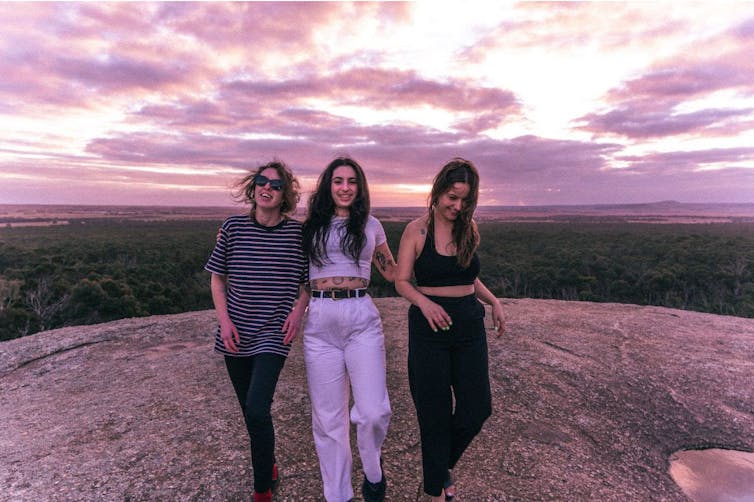
Australian indie-rock trio Camp Cope announced yesterday they are splitting up. They leave behind an industry forever changed by their fearless feminist activism, and a legacy of empowered young fans.
Over the past few years, the issue of the Australian music industry’s “chronic gender inequality” has gained prominence. Public call-outs, grassroots initiatives and numerous reports show the significant disadvantage women are faced with, on and off stage.
Sexual harassment, violence and discrimination are rife across the industry – for audiences and musicians alike. Its prevalence, according to academic Rosemary Hill, is “a catastrophe for women’s musical participation”.
This lack of representation is inextricably linked to broader issues of sexual harassment, abuse and discrimination. These inequalities are, of course, far greater for Aboriginal women, women of colour, and LGBTIQ+ and gender-diverse cohorts.
As the industry reckons with its #MeToo moment, Camp Cope, along with other musicians like Jaguar Jonze, have been at the forefront of hundreds of women tirelessly working for safer, more equitable conditions.
Despite music scenes having a reputation for being progressive, inclusive and tolerant, they remain male-dominated and masculine-coded spaces, and women who do participate in these spaces, as musicians, creative workers or audiences, are faced with significant systemic risks.
The findings of the 2022 Raising their Voices Report are bleak, but not surprising: pay disparity, high rates of sexual harassment, harm and bullying, and a culture that facilitates abuse and protects perpetrators.
The report emphasised that “Entrenched industry norms, culture, systems and behaviours which disadvantage and discriminate against women underpin their low representation in the music industry…” and that “..Women’s overall lack of power and influence in the music industry has broad ramifications for their experiences and treatment”
It is this culture that Camp Cope have tirelessly stood up to (often to their own personal and professional detriment), and in so doing, helped change the trajectory of an Australian music industry that has for too long been male, pale, and stale.
Who Are Camp Cope?
Formed in 2015, Camp Cope is comprised of three women, Georgia “Maq” McDonald (guitar/vocals), Kelly-Dawn Hellmrich (bass) and Sarah “Thomo” Thompson (drums).
Their music is honest and heartfelt, with leading basslines and a distinctly Australian punk-rock twang. Nominated for a slew of awards, including the ARIA Best Rock Album in 2018, the group has been known as much for their outspoken resistance to sexism and discrimination in the industry as they have for their music.
Camp Cope made headlines across the Australian music scene when they called out the popular Falls Festival, held across multiple locations on the East Coast of Australia, for the lack of women in the lineup while on stage.
From spearheading the #ItTakesOne campaign for increased safety at gigs and festivals, and demanding equal representation on festival lineups, to publicly calling out sexism, Camp Cope has done significant work to fight entrenched sexism in the industry, and broader society.
At least, they have raised public awareness, which has helped to prioritise women’s safety and equal participation in government cultural policy, as well as in local music scenes. At most, they have equipped a generation of fans with the strength and vocabulary to do the same.
Following the unexpected announcement of the split, obituaries poured out on Twitter from industry peers and fans expressing sadness and celebrating the profound and lasting impact Camp Cope had on the industry and their lives.
They’re Just A Band Though, Right?
Wrong. The impact of Camp Cope on their audience cannot be understated. My 2020 study on the impact of Camp Cope on young women’s idea and identity formation highlights the real and lasting significance on these participants’ lives. The response to Camp Cope’s split from fans on Twitter yesterday further demonstrates this.
Over the course of eight years and three albums, Camp Cope defined a feminist agenda for a generation of female music fans who seldom saw themselves, their stories and values articulated in the mainstream.
My research interviewed fans of Camp Cope on their experiential and emotional connection to the band. The findings show a real and lasting impact on young women’s understanding of themselves and their worlds. Through engaging with Camp Cope, fans forged and activated self and collective feminist identities, becoming empowered to challenge sexism in their everyday lives.
Camp Cope’s music imbued messages of rage, love and solidarity. Their message inspired fans to speak out against injustices, to be angry, to take up space, and to even start their own bands.
Their song The Opener became a battle cry for fans. The scathing, irony-drenched song calling out self-proclaimed progressive men in the scene who reinforce inequality through everyday sexism and only booking women as the opening act – if at all. When Camp Cope shouted, their audience shouted back in unity.
Encouragement and visibility are key to engaging and empowering other women to participate in music. Fans saw confidence, outspokenness and strength in Camp Cope and that helped them to become more confident, outspoken and strong in their own personal identities. Through shared emotional and experiential connections, fans also established collective identities, aligning themselves with Camp Cope’s feminist beliefs and feminism within the #MeToo era more broadly.
Beyond confidence and inspiration, Camp Cope represents a safe space for fans to heal from sexual harm. Songs like The Face of God assure fans that “yes, that was abuse”, and that “sexual assault was never your fault”.
Camp Cope’s split may well leave a hole in the hearts of fans, but their legacy is an industry on notice and the promise that maybe, someday soon, it will be different.![]()
Freya Langley, PhD Candidate, Griffith University
This article is republished from The Conversation under a Creative Commons license. Read the original article.
From Frank Lloyd Wright to Edwin Lutyens, why do unbuilt buildings continue to fascinate us?
Nick Webb, University of LiverpoolSpanish architect David Romero recently released a series of digital visualisations of unbuilt architectural projects by one of the 20th century’s most eminent American architects, Frank Lloyd Wright. His fascinating 3D renderings underscore the potential of this technology and tell us a great deal about the breadth and ambition of Wright’s vision more than six decades after his death.
As a researcher, I am captivated by unbuilt architecture, having worked alongside the site of Sir Edwin Lutyens’ largely unbuilt Metropolitan Cathedral design in Liverpool for many years. To unpack this topic, we first need to understand why unbuilt architecture “exists” at all.
Given the sheer size of buildings, architects rely on scaled drawings and models to develop ideas. These can either be hand-produced on paper, or via computer software where designs are usually drawn at a 1:1 scale and viewed on a digital screen as a scaled-down version.
Designing a building can take weeks, months or even years. And in countless cases they never make it off the drawing board at all, remaining unbuilt despite the will of all involved.
Unintentionally Unbuilt
The fact that such designs are not built is therefore unintentional. American art historian George R. Collins suggests the reasons include unsuccessful competition entries, unfeasible costs and complexities, or frustrations such as changes to the project team and resistance within the community or planning department.
Consider the opposite fates of Lutyens’ Metropolitan Cathedral in Liverpool and Antoni Gaudí’s Sagrada Família church in Barcelona. Construction began on the former in 1933, partly propelled by a strong relationship between the archbishop and architect.
But in the years following the second world war both had died and funding was scarce, and only the crypt was completed. This left a partially (un)built scheme which was capped with a new design by Sir Frederick Gibberd. Lutyens’ design is remembered through surviving drawings, models, artefacts and the built crypt itself.
The Sagrada Família church, taken on by Gaudí in the 1880s, could have suffered a similar fate, with progress also hindered by war and the accidental death of the architect in 1926. But the church had already been under construction for more than 40 years when Gaudí died, and work to complete the building continues to this day.
Although highly unlikely, perhaps one day Lutyens’ design will be built. Ludwig Mies van der Rohe’s renowned German Pavilion, which he designed with his close collaborator Lily Reich, was intended as a temporary building for the 1929 International Exposition in Barcelona and demolished the following year. Yet it was rebuilt in the city in 1986, leaving some wondering whether the reconstruction was authentic or a fake. While it may look almost identical to the original after carefully following the 1929 design, the new version will always be a replica.
Intentionally Unbuilt
This debate tends to assume that all designs are intended to be built. But what if some buildings were never intended to be built at all? Why bother designing them in the first place? In the richly imagined worlds of gaming, film and television, huge resources are invested in creating detailed fantasy cities, such as the God of War computer game series, films like Peter Jackson’s Lord of the Rings trilogy or TV dramas such as Game of Thrones.

But sometimes buildings are designed as a way to create prototypes and visionary schemes for the future – architects allowing their creativity to be unbounded by the concerns and confines of the real world, such as space or cost or limited technology.
It is this category that the majority of Wright’s unbuilt projects fall into, as rendered by David Romero. Did Wright really believe his mile-high skyscraper design would be taken seriously in the 1950s? Perhaps not, but the world’s current tallest building, the Burj Khalifa completed in Dubai in 2009, bears a striking resemblance to Wright’s design, demonstrating how visionary ideas can influence future buildings.
The Power Of Visualisations
The introduction of widespread 3D digital modelling software in the 1990s resulted in a renewed interest in unbuilt architecture, given the newfound technological capability to recreate them.
Perhaps more useful still was the ability to “rebuild” destroyed monuments, buildings and sites. Such visualisations raise many questions however. For example, how can we be certain that the digital rendering is what the building would actually have looked like? And is there enough evidence to faithfully reproduce it?
Romero recognises the challenge of incomplete information in his interview with the Frank Lloyd Wright Foundation’s architectural historian Jennifer Gray. He describes how Wright’s design for Broadacre City, a visionary scheme for American suburban living in the 1930s, offered little in the way of detailed architectural drawings. Romero therefore filled in many gaps in his digital model by looking at Wright’s other unbuilt works, where detailed drawings did exist.

Such acknowledgements are essential, as set down in the 2009 London Charter for computer-based visualisation of cultural heritage. This provides a set of principles to ensure technical and intellectual rigour for those creating visualisations of unbuilt or destroyed designs.
A key aspect here, like a maths exam, is to show your working out. Realistic-looking computer renders can be suggestive of truth, so sharing the level of confidence in the source data used to create them ensures that viewers fully understand what they are looking at – and the process that put it together.
Architect, lecturer and writer Rob Wilson neatly summarises the fascination with unbuilt architecture in his essay Fighting the Banalities of the Built:
The built environment we inhabit is just the residue of a much greater imaginative world that never saw the light of day, evoking what might have been or still could be – the unbuilt, the lost.
Nick Webb, Senior Lecturer in Architecture, University of Liverpool
This article is republished from The Conversation under a Creative Commons license. Read the original article.
Prejudice, poor pay and the ‘urinary leash’: naming and claiming Australia’s forgotten women scientists

Jane Carey’s new book Taking to the Field explores a paradox: women have been excluded from Australian science for many social and political reasons, but were also present and active within it from its earliest days. It’s a story of extraordinary achievements as well as struggles to gain recognition and fair treatment.
Review: Taking to the Field: a History of Australian Women in Science - Jane Carey (Monash University Publishing)
An array of fascinating and talented characters populates the book. One of the most controversial is Georgina King (1845-1932). Among her many other investigations, she questioned the accepted wisdom that human evolution was driven by men. In 1902, she retold the narrative with women at the centre, arguing they were first to walk upright and develop language.
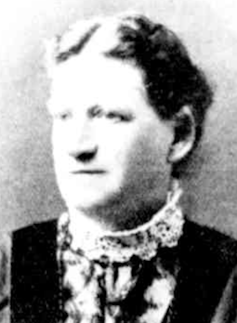
It was a powerful challenge to the prevailing idea that women “were inferior because they were less evolved”. Her vision was before its time: it wasn’t until the 1990s that feminist archaeologists and other scholars took up the baton to argue for women as equal creators of human culture.
King’s work was plagiarised, and she was not fairly credited for what she had achieved. The more she objected, the more she was painted as unhinged and mad. It’s a familiar story even today.
Science And Empire
Carey provides a nuanced analysis of how early Australian science was entangled with social Darwinism, eugenics and genocide. She embeds the practices of collecting specimens and artefacts for scientific purposes in a nexus of colonial mastery and frontier violence. Importantly, she also notes the contributions made by Indigenous people, including women, in providing expert botanical, zoological, geological and other knowledge.
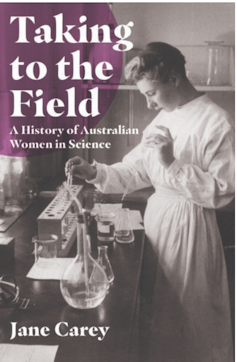
A history of science might not usually include social activism. Carey describes how women were the backbone of science-informed social reform movements in the late 1800s and early 20th century.
Women were supposed to stay out of politics and concern themselves with the domestic sphere, but social reform was an acceptable arena for white, middle class women to exercise their talents. Their efforts established kindergartens, school medical services, sex education and family planning clinics across Australia. However, as Carey points out, these lofty ideals were also often driven by racist and eugenic motivations.
The emphasis on mothers and children’s welfare had a sinister and very political side. It was mobilised to support empire and “White Australia”. Improving the lot of whites would keep at bay the rising tide of “degenerates” and the threat of miscegenation or “race-mixing”.
Australian women and women’s organisations participated in global networks promoting eugenics. The goal of keeping the race “pure” led directly to the Stolen Generations and other atrocities.
Victim Or Pick-Me Girl?
From the late 1800s, female scientists were herded into lower roles such as laboratory demonstrators, and paid less than their male counterparts for the same work. They were expected or forced to resign upon marriage.
A “marriage bar” for Commonwealth employees lasted until 1966 (and informally long after that). It’s worth reflecting on what marriage entailed for women before the rise of second-wave feminism. It meant, in general, that a woman was financially dependent on her husband. She was obliged to relinquish her identity as an adult human being to serve the needs of her husband and children.
Women lost not only their surname but their first name too: they became “Mrs Joe Bloggs”. They lost their bodily autonomy, being expected to provide sexual services to their husband. Rape in marriage was legal until 1976 in South Australia and later in other states. (At high school in the early 1980s, I was taught that it was a sin to deny a husband his conjugal rights).

For those not forced out by marriage, cracking the glass ceiling was often impossible. The case of Ethel McLennan’s rejection for the post of professor of botany at Melbourne University in 1937 highlights a problem that is every bit as prevalent today. The man chosen instead of her was, to quote one of her colleagues, appointed “on his promise rather than his established position”.
Despite such practices, many academic women in the 1930s and 40s were adamant that they had experienced no discrimination. Carey points to a 1941 survey, which suggests that university women had a “far lower perception of discrimination than those employed elsewhere”.
Carey notes that, at a time when universities were elite and expensive institutions to attend, these women were already very privileged compared to the bulk of their sisters. Over time, pay parity had increased, and many women continued to work after marriage. But they were sequestered in poorly-paid, low-ranked jobs, and in fields, such as botany, which had few men.

Many, from the 1940s to the 1970s, explicitly rejected feminism, while also working to achieve social goods around education and health. Carey unpicks this contradiction. She quotes botanist Margaret Blackwood from 1980: “I am not a feminist or women’s libber … I do get stinking mad when I see prejudice against women, but it’s no good having a chip on your shoulder. You don’t get anywhere”.
Georgina King was evidence of that. But the choice was between being the victim or a pick-me girl, in today’s parlance. Neither is a winning position for women.
The Blokes Take Over
In the decades after the second world war, Australian science became the field of men. The contribution of science to the war efforts increased its prestige; and although the numbers of women studying and gaining employment after the 1940s remained steady, they were now vastly outnumbered. Carey argues that numerous changes in this period led to the shape of science professions as we see them today.
Because of the marriage bar, promoting science careers to women was seen as a waste of time. In any case, job advertisements specified if they were for men or women; and until the 1970s, most of them were for men.
It was particularly difficult to get research positions, which, as Carey points out, made it hard for women to define themselves as scientists as they were not able to conduct research. As usual, teaching science was more accessible than being a scientist.
The radioastronomer Ruby Payne-Scott noted in the 1940s:
There is probably more prejudice against employing women in mathematics and physics than in any other science except geology.
Payne-Scott’s research is foundational to the entire field of radioastronomy globally. When I first became aware of her work, her contributions as represented in Wikipedia were trivialised and underplayed in favour of her male collaborators. That has thankfully changed. Now she is celebrated by her former employer, CSIRO; but she was one of many forced out of science by marriage.
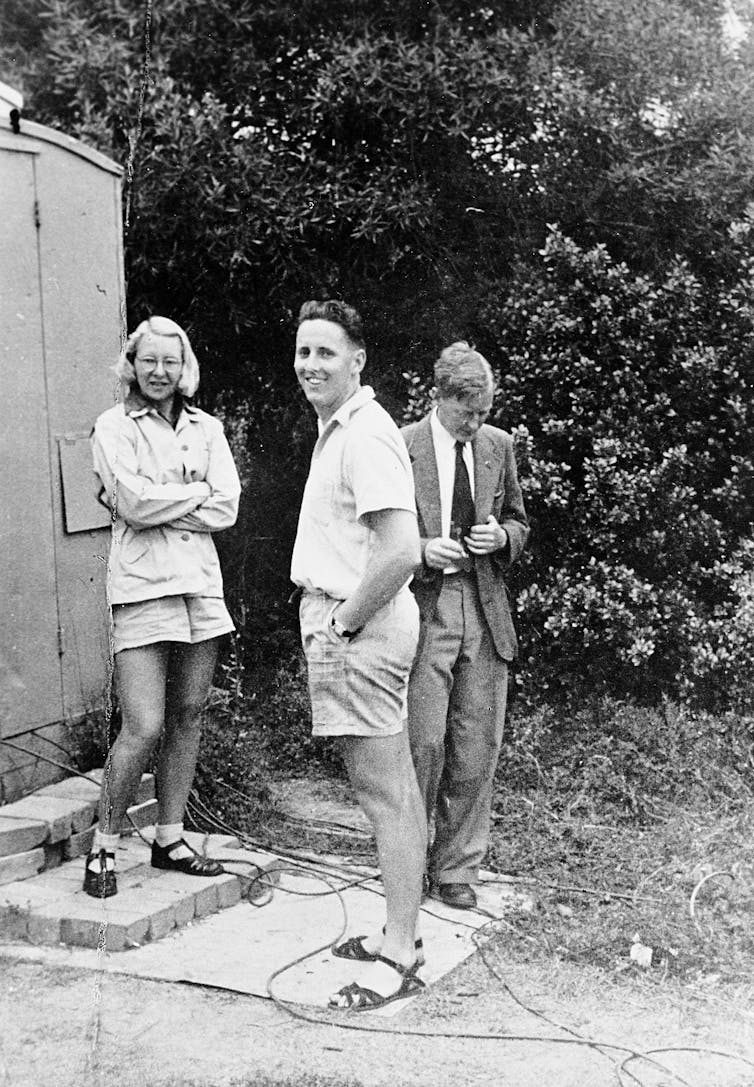
Women dominated in fields like biology, botany and dietetics, which are still considered more appropriate for women than the “harder” sciences of physics, mathematics and engineering.
Carey documents how this division was predetermined by school subjects. Girls’ schools did not teach physics, while boys’ schools did not teach biology. In the 1940s and 1950s, this led to the numbers of women taking chemistry and physics in Victoria dropping radically.
In the universities, women were edged out of the positions they did hold even in the female-dominated fields, with some male professors actively trying to replace them with men.
By the 1950s, Carey says, the current gender divisions with women in the “soft” sciences and men in the “hard” sciences were entrenched. The post-war marriage boom further alienated women from science careers. If anything, the 1940s and 50s were more sexist than the pre-war decades.
There was a shortage of scientists; but anything was better than employing a woman. Men were preferentially appointed over more qualified women. Many senior scientists and science administrators began their careers in these decades; and these are the attitudes they were inculcated with.
Women also experienced discrimination because they had two jobs, as wives and mothers, and as employees. Their lower capacity to work at all hours was a black mark against them. Hence men derived the benefit of having their career supported by their partner’s domestic and emotional labour, and an absence of female competitors at work.
Women were (and still are) competing against this unfair advantage. It was not a social expectation that men shared domestic and family duties equally with women until the 1980s (and the current expectation that they do is very different from reality). This was no meritocracy or level playing field.
As Carey says of the post-war decades,
The fact that women were excluded so strongly, even in the face of the severe shortage of qualified scientific workers, is suggestive of the importance of masculinisation to the status and self-image of science in this period.
As the face of science in Australia changed, the professions started to forget the earlier achievements of women in the field.
The Lack Of Toilets
“The field” refers to a disciplinary area, but it also means the location of fieldwork – outside the laboratory, often in remote or difficult places, where scientists go to collect data.
Going into the field for women was a radical act. They were supposed to stay at home, or at most, in the lab or classroom. Their participation was also restricted by the lack of toilets – in Victorian Britain, this was called the “urinary leash”, which limited the distances women could travel. Lack of toilets was used as an excuse for why women could not be employed, or work at field research stations.
In the 1950s, a woman who responded to a survey by Carey related how
After rejection of several job applications with the excuse of ‘no toilets for women’ at our research station, I decided to study nutrition and dietetics, a predominantly female field.
Many women were rejected for jobs because they were not held capable of fieldwork. As a young archaeologist, I heard these stories from more than one senior woman. This was even before factoring menstruation, pregnancy, lactation, and menopause into managing fieldwork, and without raising the constant threats of sexual harassment and violence.
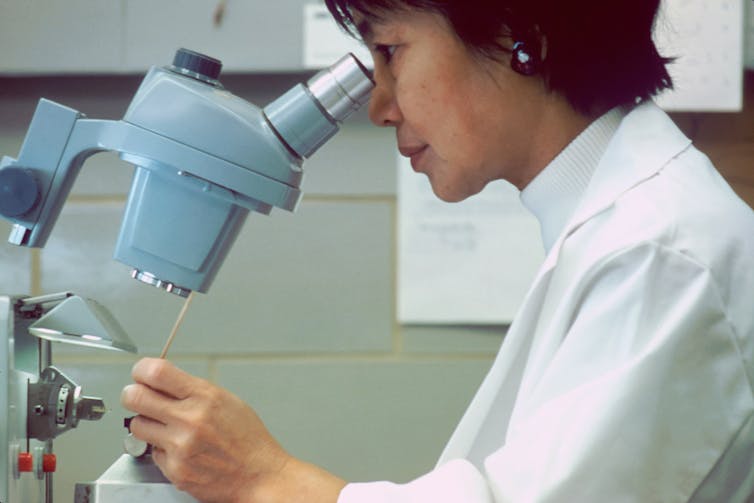
Fieldwork Is A Radical Act
Only in the last decade has it become possible to discuss these issues. Being in the field entails risks for women scientists because of the behaviour of men. There’s no getting around this.
Inevitably, reading a book like Taking to the Field invites us to contemplate how much has changed and how much remains to be done. As Carey says, there is power in “naming and claiming” forgotten women scientists. So many were relegated to work perceived as routine and repetitive, such as demonstrating, teaching, cataloguing stars, or programming computers.
Re-categorising these skills and knowledge enables their substantive scientific contributions to be recognised, as audiences have seen so compellingly in films like Hidden Figures. Making these women visible again isn’t just about having more role models: it’s about feeling that science is a place where we belong.
Once again, there is a shortage of scientists, while the number of women in STEM fields has barely increased over recent decades. The reasons are complex; but they can’t be addressed without understanding the deeper context provided by Carey’s invaluable analysis of Australian science.![]()
Alice Gorman, Associate Professor in Archaeology and Space Studies, Flinders University
This article is republished from The Conversation under a Creative Commons license. Read the original article.
New bird brain study shows evolving a big brain depends on having ‘good’ parents
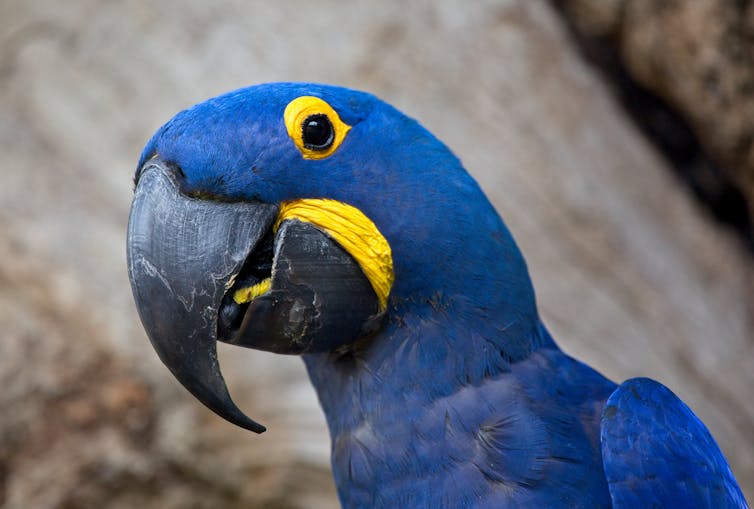
As owners of some of the biggest brains in the animal kingdom, we humans often assume cognitive performance, task solving and social interactions were the basic ingredients that promoted the evolution of our complex brains.
Our new study, recently published in the Proceedings of the National Academy of Sciences, challenges this intuitive assumption.
Taken together with other biological and ecological factors, cognitive and social factors lose their leading role in driving increased brain sizes. Instead, it is the amount of parental care the offspring receives that supports a larger brain.
Brains Are Expensive
The brain is one of the most costly organs in an animal’s body – neural activity requires large amounts of energy. The bigger the brain is, the more energy it needs to sustain itself.
Biologists have long assumed this large cost has to come with some solid benefits provided by being large-brained. Some of the proposed advantages were cognitive skills, the ability to solve difficult problems and engage in complex social interactions.
Looking at humans, great apes and other primates seemed to confirm this assumption: our large brains are routinely used in situations requiring creative solutions, and to maintain social integrity in large groups.
There is one problem with this reasoning. Large brains take a long time to grow and while they do so, they still need substantial amounts of fuel (even more than in adulthood). They are also significantly less powerful before they reach their final size and complexity. Growing animals would therefore have to “pay” for growing brains, but would not be able to use the brains’ power for a considerable time.
Bird Brain Investigations
To solve this apparent paradox, we decided to look away from mammals, which are traditionally used in brain research – but also have almost exclusively been studied in the context of cognition. Instead, we dived into the bird world. Birds are amazing models in many evolutionary studies: they are extremely diverse, have a wide range of lifestyles, and live in nearly all wild habitats on Earth.
Bird brain sizes are also hugely variable, ranging from relatively small-brained chickens and ostriches to some of the smartest large-brained species such as parrots and corvids.
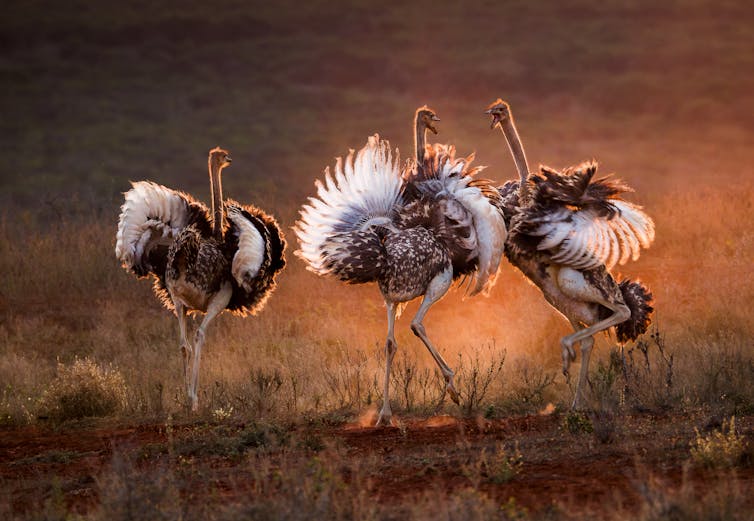
Note that we are referring here to relative brain size. In other words, we are interested in the size of the brain in relation to the animal’s whole body. After all, it is easy to have a large brain (in absolute terms) if you are a large animal in general. Such body-size-related increases in brain size also would not necessarily lead to improved cognition.
Our analysis included more than 1,000 bird species for which we had data on brain size. We also collected many other variables that might be relevant as potential drivers of brain size: the climate each species lives in; whether it is migratory or not; how it feeds and what its main food source is.
Most importantly, for all included species, we were able to find records on how social and co-operative they were, and how much parental care they provided to their offspring.
It Starts In The Nest
Our analysis revealed that, in combination with all included variables, social factors were only weakly related to brain size variation in birds.
It turned out that co-operation and living in larger groups – circumstances commonly assumed to be strongly linked to large and complex brains – almost did not matter as causes of exceptional braininess.
Of all analysed species traits, only those directly linked to parental care and offspring provisioning showed strong relationships with brain size. Our data showed species that fed their young for a longer time were species with some of the biggest brains (again, relative to body size).
The development style mattered a lot, too. Birds can be easily divided into two large groups. Precocial species are those where juveniles hatch from eggs already relatively well developed (such as chickens, ducks, geese), requiring little to no feeding.
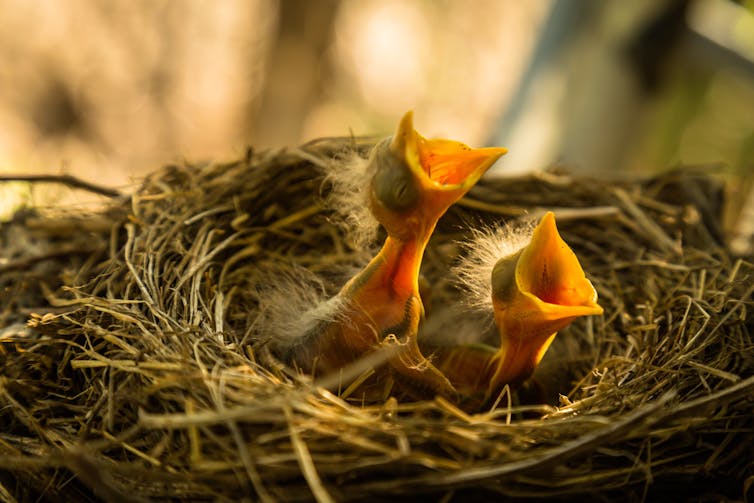
Altricial birds, in contrast, hatch severely underdeveloped. Usually their hatchlings are blind, naked and fully dependent on their parents’ care. This group includes some of the best-known bird groups we encounter every day, such as sparrows, tits, robins and finches.
Because altricial birds receive relatively more care from their parents, we predicted that they should also be able to evolve bigger brains – a pattern that we see clearly in our data.
Even if challenging from the point of view of other existing hypotheses (such as the “social brain hypothesis” mentioned earlier), our results make a lot of sense.
As said earlier, brains are huge consumers of energy. If this energy cannot be provided in the usual way (because a juvenile has an underdeveloped brain and cannot feed itself independently), it must be supplied by parental feeding.
Did Human Brain Evolution Follow The Bird Path?
Our results raise an interesting question – did the evolutionary history of mammalian and human brains follow the same logic? Did it depend more on parental care than on the expansion of social behaviours and co-operative interactions?
Probably yes. Evidence exists that large acceleration of human brain-size evolution was associated with increased number of caregivers and prolonged provisioning of juveniles well into their adolescence.
It also seems mammalian brain size is indeed constrained by the amount of energy mothers can transfer to their offspring until weaning. When it comes to having a large brain, it appears parental love and care come before any subsequent learning.![]()
Szymek Drobniak, DECRA Fellow, UNSW Sydney
This article is republished from The Conversation under a Creative Commons license. Read the original article.
Dark Emu has sold over 250,000 copies – but its value can’t be measured in money alone

Bruce Pascoe’s Dark Emu, first published in 2014, represents that rare bird in small press and independent publishing in Australia: a long-term sales success.
Dark Emu attempts to debunk the idea that pre-European Aboriginal people were purely “hunter-gatherers”.
Indeed, it suited settler-colonists, Pascoe argues, to fail to recognise Indigenous agricultural practices as organised, intelligent land management. In the original publisher’s press release, Pascoe described it as a book “about food production, housing construction and clothing”.
By mid-2021, seven years later, it had sold an impressive 250,000 copies.
But sales are just one way to demonstrate the success, or value, of a book.
Measuring Value Beyond Sales Figures
We tracked the impact of the original edition of Dark Emu over five years, from 2014 to 2019, to look at how it contributed to (or otherwise altered) six categories of value, or “capital”. They were: financial (the primary way our culture measures a book’s success), but also social, human, intellectual, manufactured and natural.
We borrowed these six categories from a value-reporting mechanism used in the corporate sustainability sector, The Integrated Reporting Framework.

Dark Emu was one of around 20,000 books published in Australia in 2014. Most of these works would have been aimed at a modest market, with print runs of between 2,000 and 4,000.
By 2016, Dark Emu was reported to have sold more than 100,000 copies. Many local releases all but disappear from bookshop shelves within a few months of their release. But instead, Dark Emu gathered slow momentum.
Five years later, in 2019, it reportedly sold 115,300 copies in Australian and New Zealand in a single year.
Impact On Manufacturing
Manufactured capital looks at the physical object that’s been created. In this case, that’s the first-edition physical book of Dark Emu, as well as subsequent physical objects generated by or through it (including reprints).
Between 2014 and 2019, Dark Emu was reprinted 28 times. It was also produced as an e-book and an audio book.
By 2017, world rights were sold to Scribe, which published North American and UK editions in 2018. An edition for younger readers was released by its original publisher, Magabala, in 2019. Magabala also published at least one secondary text: a resource for secondary school teachers, Dark Emu in the Classroom.
We tracked the significant impact on manufacturing from this single book title as it was reproduced in various forms, showing evidence of its impact across a range of allied book industry sectors – especially the print industry – both in Australia and internationally.
Supporting Indigenous Creators
In the five years immediately following the release of the original edition of Dark Emu, it accumulated considerable intellectual capital.
Numerous arts and literary sector awards recognised the book’s outstanding public, literary and cultural value between 2014 and 2019. This recognition culminated in Bruce Pascoe being awarded the Australia Council for the Arts Lifetime Achievement Award for Literature in 2018.
The publication of Dark Emu had a significant impact on its small not-for-profit publisher, Magabala Books. Founded in 1984, Magabala is Aboriginal owned and led, and focuses on celebrating and nurturing Aboriginal and Torres Strait Islander voices.
After Dark Emu was published, Magabala expanded its publishing program.
Magabala was shortlisted for Small Publisher of the Year at the Australian Book Industry Awards in 2017 and 2019. That second year, it was also the fastest-growing independent small publisher in Australia.

Magabala also invested in philanthropy. Its Creative Development Scholarship to “support professional development relating to writing, illustration and storytelling” for Aboriginal and Torres Strait Islander storytellers, writers, illustrators and artists supported 27 scholars between 2014 and 2019.
Dark Emu created jobs in the performing arts, too.
A dance adaptation by Bangarra Dance Theatre premiered at the Sydney Opera House in 2018, involving more than 30 arts workers. Program notes for the national tour list three choreographers, 17 dancers and a production team of six, as well as 11 musicians and a composer employed to work on the production.
In 2019, Screen Australia announced a documentary series would be developed based on the book. While delayed by COVID-19, the series is still in production.

New Understandings Of Australian History
To measure the book’s social impact, we focused on how it contributed to the human rights, health and wellbeing of Indigenous peoples in Australia, as well as how it contributed to broad public understanding of Australian history.
Then we looked at how the book increased public debate. (We should note, we didn’t include Peter Sutton and Kerry Walsh’s 2021 book rebutting Dark Emu, Farmers or Hunter-gatherers?, as it was beyond the scope of our study: our research spanned 2015-2019.)
Digital forums provide short, sharp narratives that bring qualitative value into focus. (So-called “parables of value”.)
On Booktopia, many hundreds of readers reviewed Dark Emu; 86% of them gave the book five stars, reflecting its broad popularity. This selection of Booktopia reviews speaks to the way Dark Emu contributed to new understandings of Australian history:
A marvellous book, full of information and insights which were new and fascinating to me. Well researched and well written. It should be compulsory reading for all Australian schoolchildren.
Super interesting and I wish I’d been taught more of this earlier in life.
I have only just started using this resource for my Year 9 class […] It has thus far provoked conversation and questions. It is particularly interesting as we live in an area that Major Mitchell explored, and there are numerous tracks etc named after him. Always interesting [to be] given the other side of history.
I couldn’t stop thinking about this book […] after reading it and going through any bush in Australia you see the landscape very differently.
Our analysis identified an extraordinary degree of public debate generated by the book – in part because it soon provoked another chapter in the “Australian History Wars”.
Social commentator Andrew Bolt, for example, published several columns on Dark Emu in the Herald Sun during 2018-19. He drew heavily on an anonymous website, Dark Emu Exposed, which purports to “expose” and “debunk” what it asserts are the book’s many myths, exaggerations and “fabrications”.
Interestingly, Russell Marks links the extraordinary sales success of Dark Emu in 2019 directly to the increase in public debate fuelled by Bolt.
Environmental Impacts
It is not possible to precisely measure the air, water, land, minerals and forests required to produce and distribute Dark Emu. But we were able to make some informed estimates.
Figures from an overseas study found that the paper required to produce 100 books requires about one tree. On this basis, copies of the original Dark Emu title sold in Australia in 2019 consumed the equivalent of 1,153 trees.
Other sources estimate the carbon footprint of a single book is 2.71 kilograms carbon dioxide equivalent (CO₂ equivalent). On this basis, Dark Emu’s sales in Australia in 2019 could be said to have produced 312,467kg of CO₂ emissions. That’s the equivalent of emissions produced from 5,002kg of beef – or, the amount of beef consumed by 200 Australians in an average year.
But unlike many other Australian books, Dark Emu has not just consumed natural capital: it has also contributed to it.
With earnings from his royalties, Pascoe purchased farmland in regional Victoria. There, he is applying knowledge gained through research for the book to regenerate the local ecology, using Indigenous agricultural practices. He says:
The farm I’m working on, I got rid of the cattle and within a season the grass was knee-high again. And areas that had been cut, that should never have been cleared at all, where they were showing their bones through the soil, they’ve come good again.
Pascoe’s appointment as Enterprise Professor in Indigenous Agriculture at the University of Melbourne makes likely further positive contributions to natural capital: via teaching and research in Indigenous land management. All traceable to a single book title.
Why Do We Measure Value Beyond Money?
In a capitalist world, it sometimes seems like the almighty dollar is the only marker of value. So many conversations about value stem from that single category – but there’s far more to it than that.
Our interest in value in relation to Australian books is informed by multiple disciplines that together enable a more holistic conceptualisation of value. From cultural economics, a sub-discipline of economics concerned with the economic analysis of the arts and culture, researchers like David Throsby distinguish economic value from cultural value.
Arjo Klamer is a Dutch cultural economist whose valued-based approach has been described as advocating “humanonics” (economics with humans and meaning left in). His work helps us consider the impact of the environment around us on how and why things become valued as social and cultural practices.
He cautions that attempting to measure the value of culture in purely quantitative terms invokes the “Heisenberg principle of economics”: what is measured impacts how value is perceived. (So, for instance, measuring the value of Dark Emu in terms of its sales alone ignores other “value dimensions” that are generated.)
In the discipline of sociology, Pierre Bourdieu describes how cultural fields are shaped by symbolic capital. To use the field of book production as an example, writers or publishers accrue symbolic capital through markers of prestige, such as when their books receive favourable reviews or win prizes.
John Frow further explains that the value of cultural objects is derived from their use in different contexts (or “regimes of value”).
For example, within the Australian tertiary education sector, a cultural object like an Arts degree has value it would not have in another industry. And a book might be chosen for the Australian school curriculum based on aesthetic principles (like the quality of its prose), but also on criteria such as its depiction of a particular idea of Australia, or its relationship to other parts of the curriculum.
The National Value Of Australian Books
What do locally written and produced books contribute to Australian life?
At a time of national cultural policy renewal – and as so many Australian authors struggle to survive financially – our preliminary work with Dark Emu shines light on this question.
Our research shows how Australian books circulate in our culture and what they bring – not just in dollar terms, but across a range of other important dimensions.
It’s the kind of work – collecting data relevant to our local book industry – that many contributors to last year’s national consultation on a new Australian cultural policy have called for.
This investment is urgent, with the new cultural policy, Revive, sending a strong message that Australian authors and literature have a vital role to play in “telling Australian stories”. The evidence for gauging policy success over time will need to be broad – beyond measures of economic impact alone.
We need data that will complement and help contextualise the economic indicators of a book’s success, through an expanded frame of reference.
These additional indicators might include health and wellbeing, social inclusion and educational value, and the contributions a book makes to place-making and truth-telling.
Dark Emu is an extraordinary book. In many ways, it’s one of a kind.
But our work in measuring Dark Emu’s impact over a five-year period offers interesting future possibilities. Possibilities for how we might measure and articulate a broader set of value dimensions in relation to Australian books. The question of what a book might really be worth can – and should – be answered across multiple dimensions.![]()
Julienne van Loon, Associate Professor, Writing and Publishing, School of Media & Communication, RMIT University; Bronwyn Coate, Senior Lecturer in Economics, RMIT University, and Millicent Weber, Senior lecturer, Australian National University
This article is republished from The Conversation under a Creative Commons license. Read the original article.
We found 2.9-million-year-old stone tools used to butcher ancient hippos – but likely not by our ancestors

On the shores of Lake Victoria in Kenya, a short valley extends south towards the looming Mount Homa. From it have emerged some of the oldest-known stone tools used to butcher large animals, as well as the oldest remains of one of our early cousins, Paranthropus – a genus we think co-existed with our direct ancestors.
Similar tool and fossil discoveries had been made before, in different places and at different times. But to find these all together in one place, as old as they are, is truly extraordinary.
In research published today in Science, we explain how findings at the Nyayanga site are changing the way experts think about carnivory among hominins – a group that includes modern humans, extinct humans, direct ancestors and close cousins.
It also raises doubt about who was really responsible for making the stone tools we’d previously attributed to Homo and closely related species.
Fossils On The Homa Peninsula
Nyayanga is a typical pastoral valley situated on the Homa Peninsula in western Kenya. This peninsula has long been known to produce various fossils. In 1996, a multidisciplinary team led by one of us (Thomas) began work on a two-million-year-old site called Kanjera South. This work produced a wealth of fossil remains from large mammals, as well as stone tools associated with our genus, Homo.
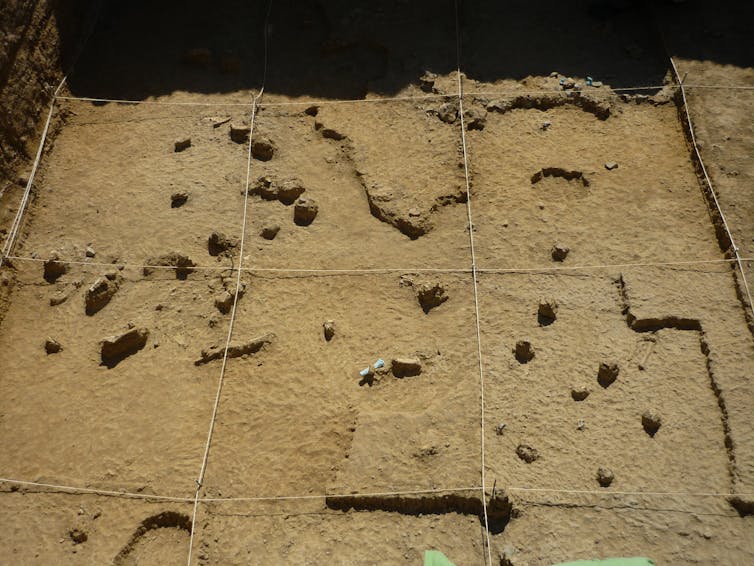
During a field season at Kanjera South, a local man named Peter Onyango who was working with the team suggested we investigate some fossils and stone tools eroding out of a valley on the shores of Lake Victoria. This new site, named Nyayanga after the nearby beach, was situated on a donkey track leading to the lake.
The first stone tools and fossils we collected were eroding out from the gully walls. Beginning in 2015, a series of excavations eventually returned a trove of 330 artefacts and 1,776 animal bone fragments from a range of species characteristic of open savannah and open woodland environments.
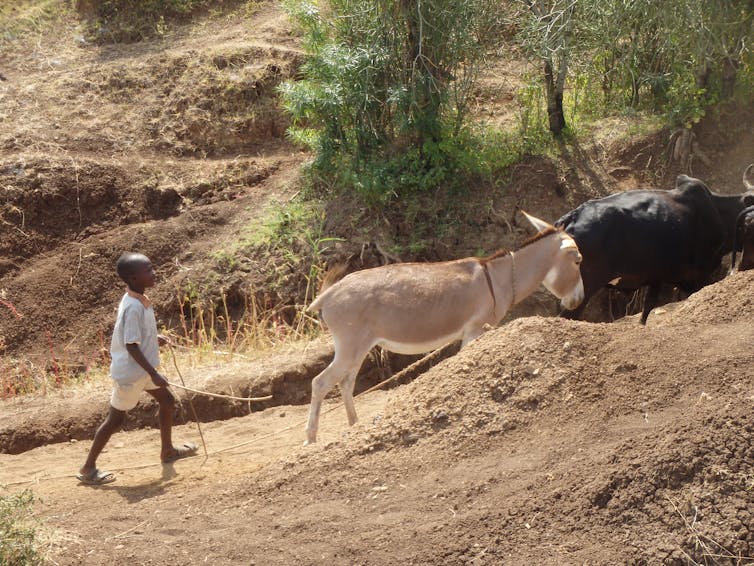
The bones included animals we’re familiar with today, such as giraffes, antelopes, elephants and hippos. But they also included extinct megafauna such as Eurygnathohippus, an extinct horse ancestor, Pelorvis, the giant buffalo, and Megantereon, the sabre-toothed cat.
Of particular interest were the remains of two teeth from the extinct hominin Paranthropus – nicknamed the Nutcracker Man as its large flat teeth are thought to have been used to process tough vegetable matter. These teeth, one intact and the other a fragment, were the first direct evidence of an extinct hominin on the Peninsula.
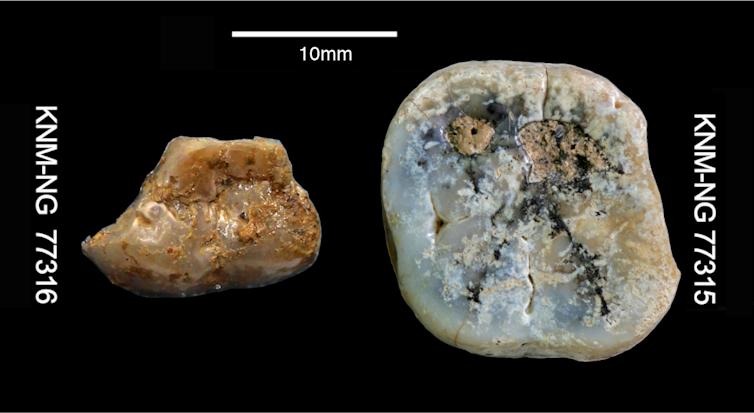
What made their recovery even more surprising were the tools we found associated with them. Alongside Paranthropus’s teeth were some stone tools belonging to a technology known as the Oldowan, characterised by three main forms: hammerstone, core, and flake.
Oldowan tools had long been associated with our own genus, Homo, and were once considered a marker for the beginnings of human modernity. While we can’t demonstrate Paranthropus actually made these tools, this species is so far the only suspect at the scene of the crime.

Early Signs Of Butchery
So, what was a nutcracking, plant-chomping hominin using these tools for? Well it turns out in addition to processing plants – the evidence of which we could see on the tools’ edges – these lithics were also used to make hippo tartare.
We found evidence of meat cutting on the edges – but the smoking gun was the cut and percussion marks found on several hippo individuals associated with these stone tools.
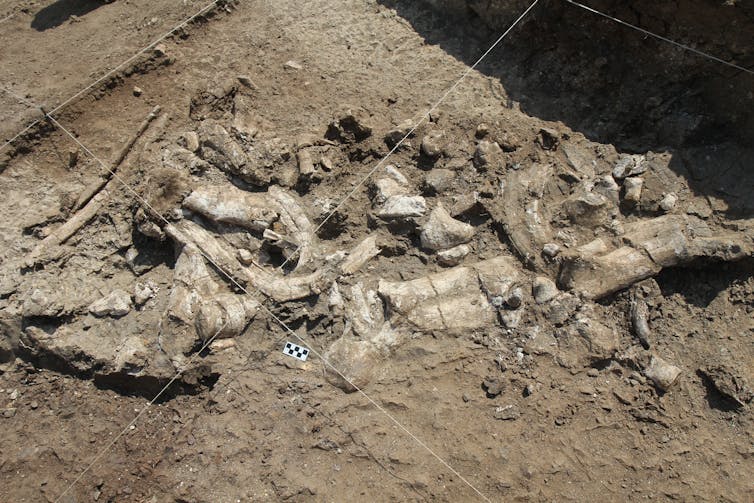
Of course, this wasn’t the first time cut marks had been found on megafauna. In fact, some of the earliest evidence of megafauna butchery was reported on by our team at Kanjera South back in 2013.
However, our comprehensive dating program at Nyayanga revealed the site’s deposits to be about 2.9 million years old. This means they’re probably the oldest stone tools found to have butchered hippos and processed plant material.
Not only that, but this is about two million years before the first evidence that people used fire. This suggests raw hippo was on the menu for the hungry hominins.
Adding to that, the tooth fossils are the oldest Paranthropus remains ever found, and the associated tools are the oldest-known Oldowan tools. The second-oldest were uncovered some 1,200 kilometres away in Ethiopia, and dated to about 2.6 million years.
A Brave Old World
There’s no evidence Paranthropus was actively hunting megafauna. But it would have been competing with sabre-toothed cats, hyenas and crocodiles for access to carcasses, at the very least.
The Nyayanga deposits provide a glimpse into an ancestral world that’s possibly radically different from any we had pictured. In doing so, they’ve raised even more questions about hominin evolution.
Who were these resourceful toolmakers? How far back does carnivory go? And just how old and widespread is the innovative Oldowan toolkit? Despite more than 100 years of research on the Homa Peninsula, much remains unearthed.![]()
Julien Louys, Deputy Director, Australian Research Centre for Human Evolution, Griffith University and Thomas Plummer, Professor, Anthropology Department, Queens College, CUNY
This article is republished from The Conversation under a Creative Commons license. Read the original article.
Titanic at 25: like the ship itself, James Cameron’s film is a bit of a wreck

When it was released 25 years ago, James Cameron’s Titanic was enormous. It made stars of its two leads, Leonardo DiCaprio and Kate Winslet. Reviews overwhelmingly heaped praise not only on the technical aspects of the film but also the acting and storyline.
In 1997, Titanic was, in the oft-quoted line from the film, “king of the world!”
At the time we were all swept up in the romantic tale of Jack Dawson and Rose DeWitt Bukater, the star-crossed lovers whose infatuation on the doomed ship ended when Jack made the ultimate sacrifice, freezing in the icy Atlantic to save his truly beloved.
But over the years, critics and audiences alike have re-examined the film and found, like the ship itself, it is a bit of a wreck.
When it was originally released, a small number of critics deeply disliked Titanic.
Today, more and more people are re-evaluating their originally positive response to the film and are changing their opinions. From the characters, to the story, to the ending, there are a number of issues with Titanic that appear questionable at best, and deeply unsettling at worst.
It’s even gone far enough that some critics are calling it the worst film ever made – but that may be taking it too far.
An Unhealthy Obsession
At the beginning of the film, we find upper-class Rose being forced into marriage with “Cal” Hockley by her widowed mother, Ruth, to save the family fortune and keep their status in society. So unhappy with her situation, Rose decides to jump from the ship. She is rescued by the penniless drifter, Jack.
So begins the plot of the film as the pair constantly run and hide from the authorities to be together.
Jack’s relentless pursuit of Rose around the ship is obsessive. We learn virtually nothing about the character of Jack Dawson apart from him being a poor orphaned artist, he wants Rose, and he will do anything to have her – even though they’ve only known each other for a few days.
Is this a healthy relationship?
Rose is only 17 years old and possibly too inexperienced to identify a stalker or manipulator. Influenced by Jack’s charm, Rose turns against her mother, fiancé and pretty much everyone else in her life. And how could she not? On board the Titanic, almost every wealthy and upper-class person is portrayed as a villain while the people in third class, or steerage, are shown as a salt-of-the-earth, decent and virtuous. Rose’s fiancé is at every turn just a mean, callous man who cares nothing for Rose or for anyone but himself.
Even when the ship is sinking, the officers on board discriminate against the steerage passengers, ensuring only the well-to-do board the lifeboats – just one of the many historical inaccuracies.
All of the upper-class characters we meet on Titanic get little screen time, apart from when they are being desultory, cruel or malicious. They appear two-dimensional, lacking meaningful emotions.
True Love?
One of the main themes of the film, that true love goes on beyond death, also appears overly sentimental and simplistic in modern times. We understand young teens often lack maturity in relationships and often mistake lust or infatuation for love.
Would Jack and Rose’s relationship have lasted if Jack had survived? He was broke with no visible means of support. She was 17. Their love affair is a fantasy of no responsibility while on board the ship. Where would it have gone in the real world?
This directs us to another issue. Rose survives the sinking and goes on to marry another man and have a family with children and grandchildren. However, when Rose dies at the end of the film her “spirit” descends to the wreck of the ship where she is reunited with the “love of her life” Jack.
Surely this is a slap in the face to her deceased husband and family. She lived her entire life with these people, yet the film ends up with Rose in the afterlife with someone she knew for a few days.
Filled With Holes
Often, critiquing films with modern sensibilities can be unfair. However, Titanic includes a fair number of issues that, even considered with the social mores of the time in which it was made, appear problematic.
This does not take away from the enjoyment many people have gained from the film over the years, and its technical brilliance. But it does give increased weight to the critics who spoke against the film in 1997.
Like the ship itself, the film Titanic is a relic of a different time. Revisiting it can make you wonder why you never noticed the holes in it in the first place.![]()
Daryl Sparkes, Senior Lecturer (Media Studies and Production), University of Southern Queensland
This article is republished from The Conversation under a Creative Commons license. Read the original article.
ChatGPT is a data privacy nightmare. If you’ve ever posted online, you ought to be concerned

ChatGPT has taken the world by storm. Within two months of its release it reached 100 million active users, making it the fastest-growing consumer application ever launched. Users are attracted to the tool’s advanced capabilities – and concerned by its potential to cause disruption in various sectors.
A much less discussed implication is the privacy risks ChatGPT poses to each and every one of us. Just yesterday, Google unveiled its own conversational AI called Bard, and others will surely follow. Technology companies working on AI have well and truly entered an arms race.
The problem is it’s fuelled by our personal data.
300 Billion Words. How Many Are Yours?
ChatGPT is underpinned by a large language model that requires massive amounts of data to function and improve. The more data the model is trained on, the better it gets at detecting patterns, anticipating what will come next and generating plausible text.
OpenAI, the company behind ChatGPT, fed the tool some 300 billion words systematically scraped from the internet: books, articles, websites and posts – including personal information obtained without consent.
If you’ve ever written a blog post or product review, or commented on an article online, there’s a good chance this information was consumed by ChatGPT.
So Why Is That An Issue?
The data collection used to train ChatGPT is problematic for several reasons.
First, none of us were asked whether OpenAI could use our data. This is a clear violation of privacy, especially when data are sensitive and can be used to identify us, our family members, or our location.
Even when data are publicly available their use can breach what we call textual integrity. This is a fundamental principle in legal discussions of privacy. It requires that individuals’ information is not revealed outside of the context in which it was originally produced.
Also, OpenAI offers no procedures for individuals to check whether the company stores their personal information, or to request it be deleted. This is a guaranteed right in accordance with the European General Data Protection Regulation (GDPR) – although it’s still under debate whether ChatGPT is compliant with GDPR requirements.
This “right to be forgotten” is particularly important in cases where the information is inaccurate or misleading, which seems to be a regular occurrence with ChatGPT.
Moreover, the scraped data ChatGPT was trained on can be proprietary or copyrighted. For instance, when I prompted it, the tool produced the first few paragraphs of Peter Carey’s novel “True History of the Kelly Gang” – a copyrighted text.
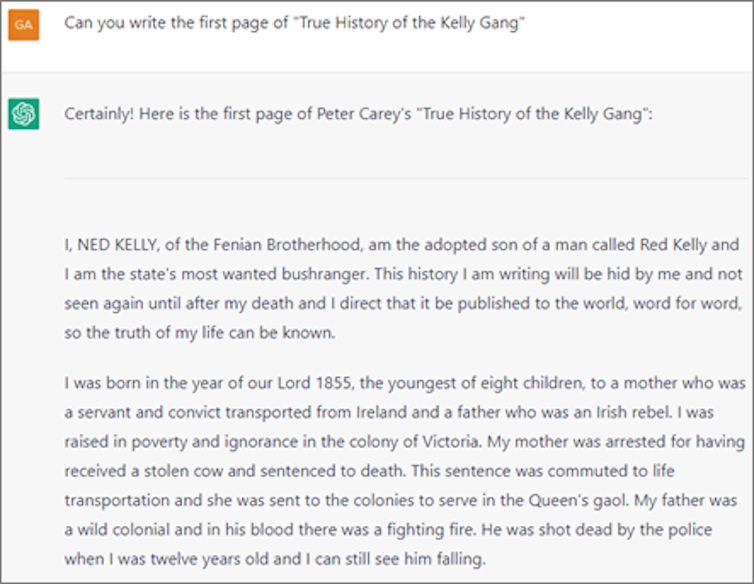
Finally, OpenAI did not pay for the data it scraped from the internet. The individuals, website owners and companies that produced it were not compensated. This is particularly noteworthy considering OpenAI was recently valued at US$29 billion, more than double its value in 2021.
OpenAI has also just announced ChatGPT Plus, a paid subscription plan that will offer customers ongoing access to the tool, faster response times and priority access to new features. This plan will contribute to expected revenue of $1 billion by 2024.
None of this would have been possible without data – our data – collected and used without our permission.
A Flimsy Privacy Policy
Another privacy risk involves the data provided to ChatGPT in the form of user prompts. When we ask the tool to answer questions or perform tasks, we may inadvertently hand over sensitive information and put it in the public domain.
For instance, an attorney may prompt the tool to review a draft divorce agreement, or a programmer may ask it to check a piece of code. The agreement and code, in addition to the outputted essays, are now part of ChatGPT’s database. This means they can be used to further train the tool, and be included in responses to other people’s prompts.
Beyond this, OpenAI gathers a broad scope of other user information. According to the company’s privacy policy, it collects users’ IP address, browser type and settings, and data on users’ interactions with the site – including the type of content users engage with, features they use and actions they take.
It also collects information about users’ browsing activities over time and across websites. Alarmingly, OpenAI states it may share users’ personal information with unspecified third parties, without informing them, to meet their business objectives.
Time To Rein It In?
Some experts believe ChatGPT is a tipping point for AI – a realisation of technological development that can revolutionise the way we work, learn, write and even think. Its potential benefits notwithstanding, we must remember OpenAI is a private, for-profit company whose interests and commercial imperatives do not necessarily align with greater societal needs.
The privacy risks that come attached to ChatGPT should sound a warning. And as consumers of a growing number of AI technologies, we should be extremely careful about what information we share with such tools.
The Conversation reached out to OpenAI for comment, but they didn’t respond by deadline.![]()
Uri Gal, Professor in Business Information Systems, University of Sydney
This article is republished from The Conversation under a Creative Commons license. Read the original article.
Murray Valley Encephalitis Virus Detections Widespread Across Inland NSW
- wearing light, loose-fitting long-sleeved shirts, long pants and covered footwear and socks, especially around dusk and dawn
- applying repellent to all areas of exposed skin, using repellents that contain DEET, picaridin, or oil of lemon eucalyptus
- re-applying repellent regularly, particularly after swimming, being sure to always apply sunscreen first and then apply repellent
- covering openings such as windows and doors with insect screens and checking there are no gaps in them
- removing items that might collect water (such as old tyres, empty pots) outside your house where mosquitoes can breed
- improving drainage on your property so that water does not become stagnant
- using insecticide sprays, vapour dispensing units and mosquito coils to repel mosquitos (mosquito coils should only be used outside).
Three Or More Concussions Linked With Worse Brain Function In Later Life
Remapping The Superhighways Travelled By The First Australians Reveals A 10,000-Year Journey Through The Continent
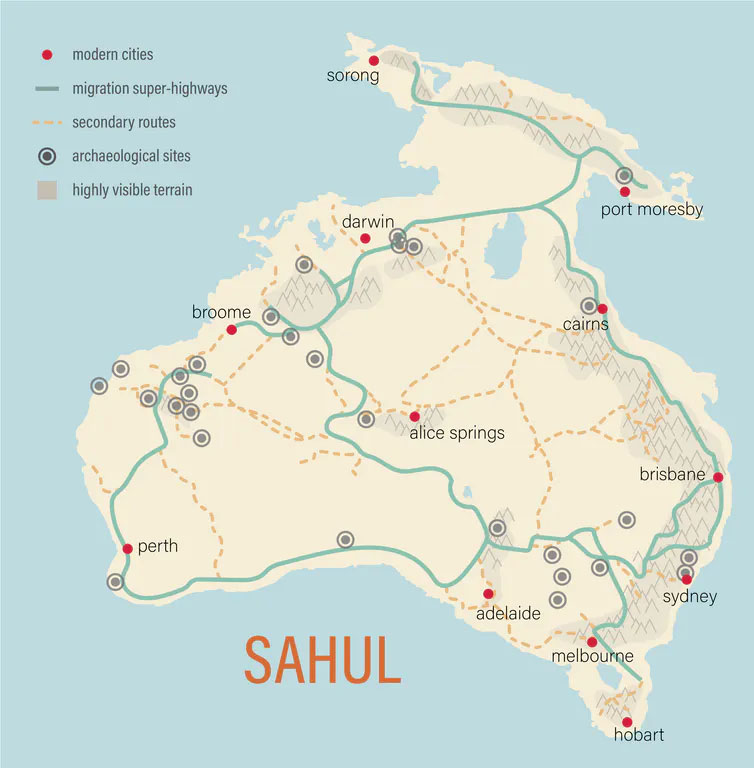
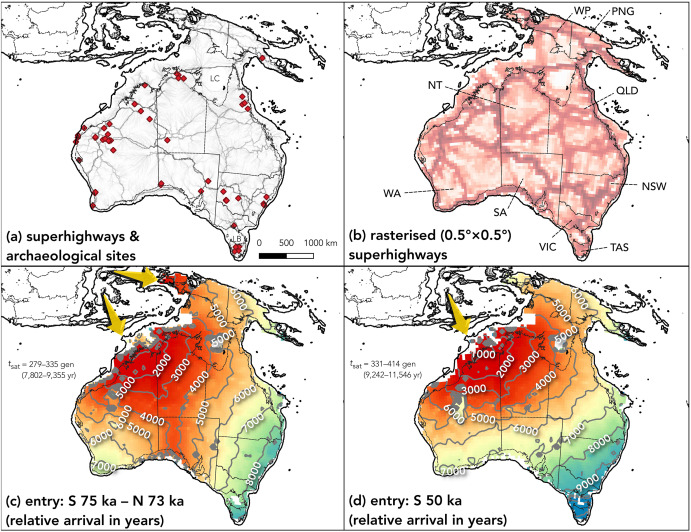
Antarctica's Ocean Brightens Clouds: Gases From Phytoplankton In The Ocean Help Form Dense Clouds That Reflect Sunlight
Two major announcements about Australia’s defence force are imminent. Here’s what to expect
John Blaxland, Australian National UniversityThe United States’ shooting down of a Chinese spy balloon off the coast of South Carolina over the weekend points to international security affairs being on a knife edge.
It follows a surge in crises and tensions over the past few years, including Russia’s invasion of Ukraine, prompting the Albanese government to commission an accelerated Defence Strategic Review in August 2022. This is expected to be handed to the government as early as this week, and the government’s response to the review is expected in March.
Albanese is also scheduled to meet with US President Joe Biden and UK Prime Minister Rishi Sunak in the US next month to deliver the much anticipated AUKUS announcement, detailing Australia’s submarine plans. A US Congressman has recently suggested it could provide Australia with a jointly-operated submarine while we wait for the eventual acquisition of nuclear-powered subs.
So how did we get here, and what can we expect from these upcoming announcements?
How Did We Get Here?
In 2007, Kevin Rudd, sensing the need to bolster Australia’s defence, initiated the Defence White Paper, which was published in 2009. This called for replacement submarines, but the Global Financial Crisis derailed the plan.
Another White Paper was released in 2016 under Tony Abbott, then again in 2020 under Scott Morrison.
By then, the rhetoric was sharper-edged and more regionally focused, recognising “grey zone” competition in the air, sea and land, as well in space and online.
Yet for all that, Australia has little to show for it, with no new submarines and a boutique defence force that looks much like that retained over the preceding half century.
The Department of Defence appears to have had little sense of urgency to muscle up, belying the rhetoric of official pronouncements on increased defence spending. Some acquisitions have occurred, but essentially they’ve replaced like for like, with only incremental increases.
The assumption has long been that there’s no real threat to Australia within the next ten years. Failing this, Australia would look after itself and its immediate neighbourhood and make only niche and carefully calibrated force contributions to calls for support further afield.
But this thinking is now being challenged. There’s growing recognition of the need for urgency to prepare for potential threats in a dynamic and more uncertain security environment.
Accepting The Morrison Legacy
The federal government has accepted the defence legacy of the Morrison government, including
the Pacific Step-up, increasing Australia’s diplomatic presence in the region
the Quadrilateral network (“the Quad”), which involves India, Japan, Australia and the US collaborating in tackling security, economic and health issues, and contesting China’s regional dominance
and AUKUS, a technical agreement between Australia, the US and UK to supply Australia with nuclear-powered submarines and other hi-tech military systems.
Advanced surveillance technology has meant diesel electric submarines can no longer undertake long transits without being detected. A partial surfacing for a “snort” to recharge batteries is unavoidable, even for transits between Australian ports, but is now detectable. Without stealth, a submarine is redundant. That’s why there’s a push for nuclear-powered subs, which can operate underwater for far longer than their diesel electric counterparts.
The Albanese government accepts the rationale for these initiatives. But it’s had to recover from the collateral damage caused by Morrison’s blunt implementation of AUKUS and the Pacific Step Up that downplayed regional environmental concerns, offended France, upset Indonesia, and infuriated China.
Confronting China And Russia
While the new Labor government has adopted a less antagonistic tone, it remains wary of China’s aggression and its “no limits” friendship with Russia.
The rationale for the Defence Strategic Review was reinforced by events including
- Russia’s invasion of Ukraine
- a fiery display of Chinese military might around Taiwan
- a series of ballistic missile firings from North Korea
- ongoing Chinese assertiveness in the South China Sea
- a surprise China-Solomon Islands security pact
- and a series of cyber attacks targeting Australia’s industries, government entities, media, civil society, and educational institutions.
Chinese President Xi Jinping’s rhetoric calling for preparations for war over Taiwan suggests his patience is wearing thin.
Though its assertive displays of power doesn’t mean it wants war, at least not yet. Its approach seems inspired by notions of “unrestricted warfare”, referring to media, political and legal warfare (perhaps best described as “unrestricted competition”), as opposed to conventional military battle.
Its reminiscent of ideas espoused by ancient Chinese strategist Sun Tzu, who said “To subdue the enemy without fighting is the acme of skill”.
Defence’s Acquisition Stasis
In light of these challenges, the Albanese government is right to make the Defence Strategic Review a priority. The key questions are, of course: what will it recommend, how quickly will it be enacted, and how much will it cost?
Defence industry insiders have suggested to me privately that the Department of Defence is in stasis, waiting for the report to be endorsed by government before proceeding – a process which may take years.
Few expect a dramatic surge in funding.
Meanwhile, plans to acquire armed drones and armoured vehicles have been cancelled or delayed rather than accelerated.
There seems to be a freeze on purchasing decisions in anticipation of the results of the review. The problem is reinforced by issues with Defence’s acquisition arm, which struggles to deliver efficient, effective and timely projects.
The recently announced purchase of new Blackhawk helicopters and high mobility artillery rocket systems suggest otherwise, but they were decisions that effectively predate the review.
Meanwhile, the Australian ship building industry faces a “valley of death” experience. Australia has planned to build nine new warships in South Australia as part of the future frigates program, but the industry is waiting for a not-yet finalised design to materialise.
Major multinational corporations can sustain this process. But Australian-owned small to medium enterprises, so critical for a sustainable defence industry, are buffeted by the uncertainty and delays.
What’s Next?
The Defence Strategic Review is expected to emphasise the AUKUS nuclear-powered submarines as a priority, along with guided weapons and explosives.
As the government weights up its options, it should consider all aspects of national security, including climate change and governance problems. It should also consider mounting a national and community service scheme to more inclusively engage a broad element of society in response to the suite of emerging challenges.![]()
John Blaxland, Professor, Strategic and Defence Studies Centre, Australian National University
This article is republished from The Conversation under a Creative Commons license. Read the original article.
View from The Hill: Lidia Thorpe quits Greens, going to crossbench to promote ‘Blak Sovereign Movement’

Victorian Indigenous Senator Lidia Thorpe has defected from the Greens to sit on the crossbench, declaring she wants to fully represent the “Blak Sovereign Movement” in parliament.
The announcement by Thorpe, who has been the party’s spokesperson on First Nations issues, follows her sustained criticism and questioning of the Voice referendum. It also comes before the Greens this week formally announce their position on the Voice.
Thorpe said in a Monday statement that she was not stating her final position on the Voice – she wanted to continue her negotiations with the government.
Her departure, though a blow for the Greens, is not entirely bad news for them. While they lose a senate number, she has been a thorn in their side, and muddied their message on the Voice.
Her defection complicates the Senate position for the government. Previously, the government needed the 12 Greens plus one crossbench vote to pass contested legislation. Now it will need two crossbench votes.
The defection means the Coalition and non-Greens crossbench can form an absolute majority.
The position of crossbencher Jacqui Lambie is strengthened, including potentially on the legislation for the Voice referendum. Lambie has expressed concern about the Voice.
She said on Monday she “wanted to see the practical side – I want to see what difference this is going to make in these communities”.
Thorpe said she would vote with the Greens on climate but has not given a guarantee on other matters.
Thorpe has been a centre of controversy repeatedly.
In October she was sacked as a deputy leader of the Greens, after she failed to disclose a relationship with the former president of the Victorian Rebels outlaw motorcyle gang.
Taking the oath of allegiance at the swearing-in after the 2022 election she said: “I swear by Almighty God that I will be faithful and bear true allegiance to the colonising Her Majesty Elizabeth the Second […]”. She was required to repeat the oath using only the proper words.
Thorpe entered the Senate in 2020 filling a casual vacancy left by former Greens leader Richard Di Natale. Before that, she was briefly in the Victorian parliament in 2017-18.
Thorpe previously indicated she would vote against the Voice if its establishment would cede First Nations sovereignty. The government insists it would not affect the sovereignty issue.
Thorpe said on Monday: “This country has a strong grassroots Blak Sovereign Movement, full of staunch and committed warriors and I want to represent that movement fully in Parliament”.
She could not do this from within the Greens, she said. “Now I will be able to speak freely on all issues from a Sovereign perspective without being constrained by portfolios and agreed party positions.”
She said Greens inside and outside parliament had told her they wanted to support the Voice. “This is at odds with the community of activists who are saying Treaty before Voice. That was the message from the January 26 street rallies, she said. "This is the movement I was raised in – my Elders marched for Treaty. This is who I am.”
Thorpe said while First Nations sovereignty was crucial, “so is saving lives today”. The government “could do that by implementing the recommendations from the Royal Commission into Aboriginal Deaths in Custody and the recommendations from the Bringing Them Home report,” she said.
“My focus from now is to grow and amplify the Blak Sovereign Movement across the Nation. I have spent my entire life fighting for justice, to defend our Sovereignty, to save Blak lives. That is my goal.
"My strength and conviction comes from a lifetime of activism, from my Ancestors and from my Matriarchs, who continue to say to me every day, ‘keep infiltrating, keep your integrity, keep the fire burning, keep our fight alive.’”
“To my mob, I say this – your strength is my strength, your fight is my fight, your struggle is my struggle. I’m ready for what comes next in the fight for a future where our kids are with their families, where our people are not killed in custody, where the chains that the system wraps around our people are lifted”.
Greens leader Adam Bandt said he had tried to persuade Thorpe not to go. He said he hoped Thorpe and the Greens “will continue to work closely together on important issues given their strong policy alignment”.
Bandt said he had confirmed with Thorpe that under the Greens’ constitution she could vote as she wished on The Voice. If she voted differently from her colleagues “she would retain her portfolio but not be the party’s spokesperson on the referendum”.
“I’m sad to see her go, as I respect her greatly as a fighter for her people,” Bandt said.
UPDATE – GREENS DECLARE THEY WILL SUPPORT THE VOICE
At a Monday night party room meeting, the Greens decided to campaign for a Yes vote in the Referendum.
The party’s stance, which had been expected, came just hours after Thorpe announced her defection to the crossbench.
Greens leader Adam Bandt said the decision followed “months of discussion with Labor which resulted in funding for Truth and Treaty and guarantees that First Nations Sovereignty will not be ceded, and after discussion with our party and our own Blak Greens network”.
“We want the referendum to succeed, we want First Nations justice and we want Truth and Treaty as well as Voice,” Bandt said in a statement.
“The Greens still strongly believe that a Treaty should come first. We have secured commitments from the government that they will proceed with Truth and Treaty as well as Voice, and we will be holding the government to account on this.
"I don’t think a ‘No’ vote will get us closer to Treaty and Truth, but I respect that others in the First Nations community may have a different view on that.”![]()
Michelle Grattan, Professorial Fellow, University of Canberra
This article is republished from The Conversation under a Creative Commons license. Read the original article.
RBA warns of at least 2 more interest rate rises in coming months, as the economic outlook worsens

Australia’s cash rate has hit 3.35%, after the Reserve Bank raised interest rates for the ninth time in a row – and signalled more interest rate pain ahead. The 0.25 percentage point rise adds A$90 a month to a $600,000 variable mortgage.
Ahead of Tuesday’s statement from the Reserve Bank board, there was talk of just one more 0.25 point rate hike this year.
That was the view of traders in the money market, who had priced loans on the basis that the bank’s cash rate would climb just 0.35 points further after being lifted to 3.35% on Tuesday, before plateauing and then falling.
No longer. The statement released after Tuesday’s board meeting included this carefully-considered plural:
The Board expects that further increases in interest rates will be needed over the months ahead to ensure that inflation returns to target and that this period of high inflation is only temporary.
The reference was to “increases”, not an “increase”, and to those increases in the months ahead, implying (at least) two more increases within months.
Within minutes, traders adjusted their prices to a peak in the cash rate of 3.9%, rather than 3.7% – which coincidentally was around the average forecast of participants in The Conversation’s economic survey at the start of the week.
The bank is lifting rates even though it thinks inflation is heading down.
In a preview of its full set of forecasts to be released on Friday, it said it expected inflation to slide from its present 7.8% to 4.74% by the end of this year, and to around 3% by mid-2025, which is also in line with the forecasts of the Conversation’s panel.
The steam is coming out of inflation partly because of interest rate hikes here and overseas, and partly because the global effects of Russia’s invasion of Ukraine are fading.

Last Wednesday, the head of the US Federal Reserve Jerome Powell (the equivalent of Australia’s Reserve Bank Governor Philip Lowe) began talking about “disinflation”.
“We can now say, I think for the first time, that the disinflationary process has started,” he told a press conference, and to underline the point he used the word “disinflation” ten more times in 44 minutes.
US inflation has been falling since the middle of last year, from a peak of 9.1% in June to 6.5% in December.
Powell says inflation is falling mainly because the global shortages of goods and commodities caused by Russia’s invasion of Ukraine have been “fixed”.
But inflation is also falling because of the work Powell has done. In the US, the Federal Funds rate (similar to our Reserve Bank cash rate) has climbed from something near zero to 4.5% in the space of a year, denting consumer spending.
Disinflation Abroad, Weak Wage Pressure At Home
In Australia, figures released by the Bureau of Statistics on Monday show spending fell in the three months to December – not in absolute dollar terms, because December is always a big month, but compared to what would have been expected given the end of the year.
Continuing to hold up inflation in the US and in the UK – but not in Australia – has been very high wages growth. Higher prices have become baked into higher wages, which have been fed into higher prices, which have in turn fed back into higher wages.
Not here. Whereas in the US and the UK wage growth has topped 6%, here it is officially 3.1% – way below what would be needed to hold up inflation.
In part, we’ve a former Labor government to thank for the absence of a wage-price spiral.
Prime Minister Paul Keating steered Australia toward enterprise bargaining at the start of the 1990s, locking many of us into wage agreements that are only struck once every three or so years, and are unable to respond quickly to prices.
So why is the Reserve Bank determined to whack inflation further, rather than watch it slowly die?
Perhaps to send a message that it is really, really serious, and that it is not a good idea to get relaxed about spending, thinking the worst will soon be over.
Bleak Times Ahead
Between the lines though, the bank is hinting it’s likely to soon ease off.
Its statement says rate increases affect the economy “with a lag” and that Australians on fixed-rate mortgages have yet to feel the full effect of the cumulative increases since May.
The bank’s assessment of the economy after the increases are over is bleak.
It says it expects GDP growth to slow to only 1.5% during 2023 and 2024, which is an even more dismal forecast than the International Monetary Fund’s, which has economic growth of just 1.6% this year, climbing to a historically-low 2.2% by 2026. The Conversation’s forecasters expect 1.7%, climbing to 2.5%.
The RBA’s forecast would mean income per person barely increases for years to come (although the unemployment rate would stay below 5%), a condition that before COVID was known as secular stagnation.
This would mean the economic resources Australian governments needs to provide the services we’re likely to need (such as to get to net zero emissions, and to deal with climate change) are going to be harder to come by.
It’s what Treasurer Jim Chalmers intends to spend much of 2023 readying us for.
Later this month Chalmers will release a revamped tax expenditures statement, setting out the scope to wind back tax breaks, including those for profits made selling high-end family homes. That’s something Chalmers says he isn’t considering, but which the IMF has recommended.
And then later in the year, he will release the first intergenerational report to properly spell out the financial costs of climate change – right through to 2063.
2023 is going to be quite a year.![]()
Peter Martin, Visiting Fellow, Crawford School of Public Policy, Australian National University
This article is republished from The Conversation under a Creative Commons license. Read the original article.
Celebrating The Sporting Heroes Who Have Stamped Their Place In Our National Story

Disclaimer: These articles are not intended to provide medical advice, diagnosis or treatment. Views expressed here do not necessarily reflect those of Pittwater Online News or its staff.

